

Top 13 Tools for Researchers in 2024!
Gone are the days of going to the library, studying numerous books, taking notes on paper, and doing research. Thanks to technology, we no longer have to do this tedious routine to do research. However, research is still a meticulous, painstaking process.
This is why we decided to uncover some of the best software tools for researchers that are going to help you conduct and maintain your research with ease. Read on…
List of Top 13 Best Tools for Researchers for better results:
Research today is dynamic. We often use the internet to browse websites, watch videos, study analytics, and conduct our research by exploring different types of digital content, making technology a major stakeholder in making our research success .
While the internet has made it easy for us to access worldly information with the click of a button (or mouse!), it has created a whole new set of problems.
Sorting through a seemingly infinite number of websites, verifying content, and curating only the best stuff can take a lot of time and effort. This is why we have brought you 13 essential research tools every researcher should use while working on the internet.
1. Bit.ai

Online research means going through numerous websites, articles, blogs, images, videos, infographics, and more to find what you are looking for.
For our dynamic, interactive, and media-rich research, we need a tool that incorporates all facets of modern-day research under one roof. Simple text editors of the past just won’t cut it anymore! This is where Bit comes in.
Bit allows researchers and teams to collaborate, share, track, and manage all knowledge and research in one place.
It’s the perfect research tool to share multi-dimensional research with your peers and not just plain, boring text and slides.
Add articles, PDFs, videos, white papers, ebooks, audio samples- basically anything you can think of – and share it with your peers easily!
Other notable features of Bit include:
- An easy-to-use, minimal editor that supports Markdown.
- Collaborative, real-time editing, and communication with peers.
- Add any type of digital content (images, videos, etc) to your Bit document.
- A content library to save all your media files for quick access.
- Smart search, allows anyone to search and find any files, images, documents, links, etc quickly.
All-in-all, Bit is a must-have writing tool for researchers and authors!

Key Features of Bit:
- Workspaces to store different research content easily
- Content library to store media assets
- Real-time collaboration with fellow researchers
- Free with limited functionality
- Paid plans start from Pro ($8/month), Business ($15/month), Enterprise (contact sales)
Read more: How Bit.ai Can Help You Manage Your Academic Research?
2. elink.io
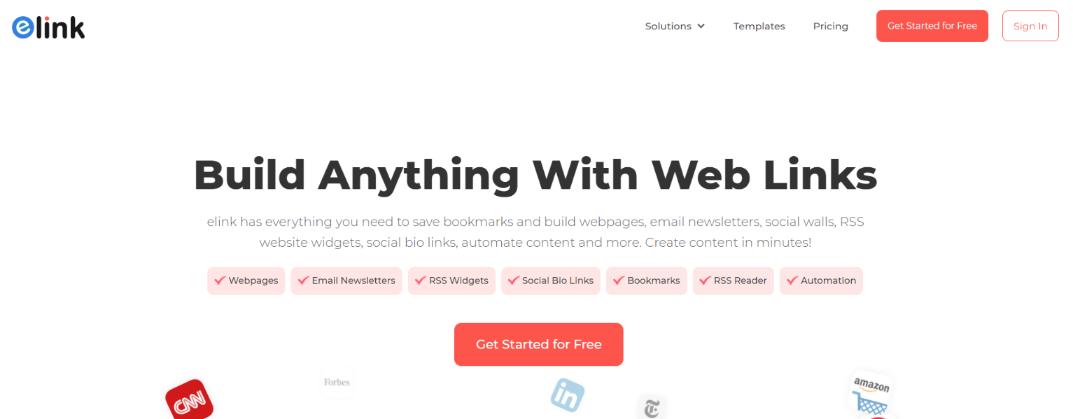
Research often involves going through hundreds of links and articles and compiling them in one safe space for future reference or publishing them for your audience.
This is why many researchers use bookmarking and curation tools like elink to quickly save their links under one roof and share them with their peers.
elink makes it easy for researchers to save content from around the web. They can save article links, videos, cloud files, social media posts, and much more!
Researchers have the option of saving content to their link library or adding them directly to content collections and sharing their research with their peers . To make the bookmarking process a breeze, elink also has a chrome extension .
Simply click on the extension or right-click on any webpage to save the content directly to your elink dashboard.
Researchers can edit the title and description to add their own voices or notes. They can even bundle links together and share their link collection with others as a newsletter or embed the collection on your blog/website!
Key Features of elink:
- Save links quickly using the chrome extension
- Create and share research links as a newsletter or embed it on your website
- Easy user-interface
- Paid plans start at Pro Monthly ($15/month), Pro 1 Year ($12/month), and Pro 2 years ($10/month).
3. GanttPRO
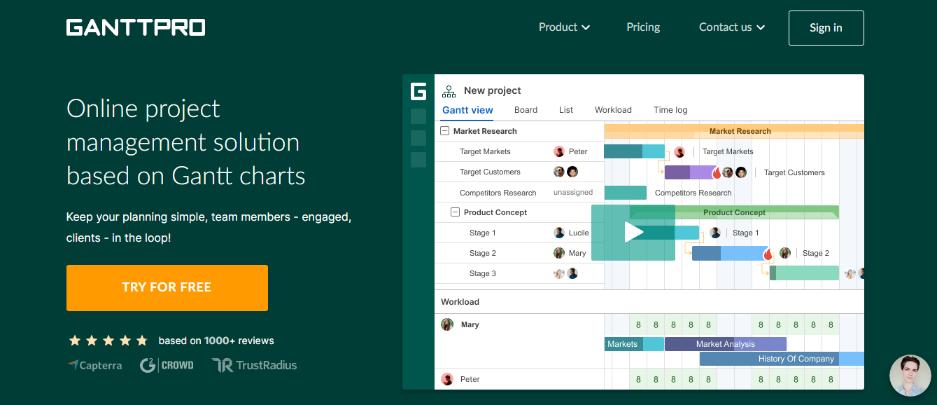
No matter what kind of research you do, you need to organize, plan, and stay focused on all of your activities.
Without a robust planning tool, researchers may fall behind the schedule and lose their progress.
GanttPRO project and task management tool makes it easy for single researchers and groups of any size to plan their tasks on a visually appealing Gantt chart timeline, follow their progress, and all the deadlines.
GanttPRO allows researchers to create a limitless number of tasks, groups of tasks, and subtasks on one timeline.
Besides, it’s a perfect planning tool for assigning tasks to your fellow researchers or creating virtual resources, whoever or whatever they may be. The software is a good choice for collaboration, time tracking, as well as sharing and exporting your schedules.
Key Features of GanttPRO:
- Dozens of ready-made templates.
- Real-time collaboration with fellow researchers.
- Elegant user interface with a short learning curve.
- Free 14-day trial with all features available.
- Paid plans start from Team ($4.5/user/month), Individual ($15/month), Enterprise (contact sales).
4. Grammarly
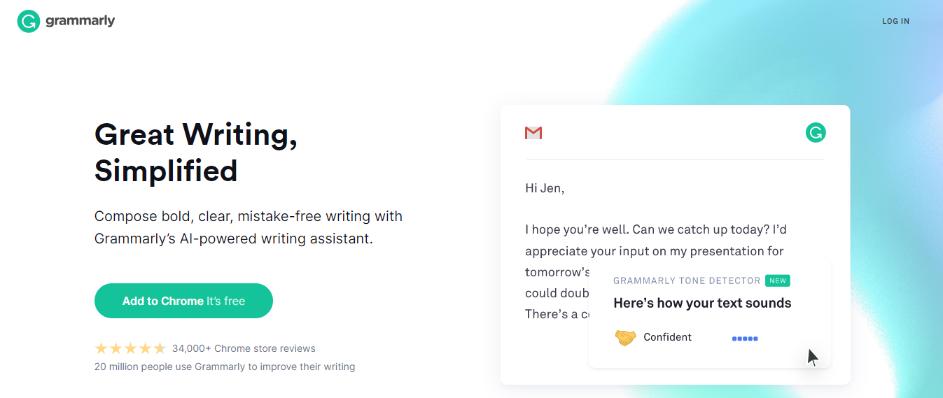
Research work often involves hours of proofreading and spellchecking to make your research professional .
Grammarly, a writing enhancement tool will save you a ton of time and effort doing this dreaded task! Apart from basic spellchecking and corrections, Grammarly includes a grammar checker, a punctuation checker, a vocabulary enhancer, and even a plagiarism checker tool!
This awesome tool scans your research for more than 250 types of grammar mistakes in six distinct writing genres and leaves you with error-free writing. With thorough explanations for all your errors and weekly progress reports .
Grammarly is a must-have tool for researchers. It’s available as a browser extension, a desktop app, a web-based app, and a Microsoft add-in. Many of the Grammarly alternatives are also available in the market that is equally good.
Key Features of Grammarly:
- Works with the majority of online tools like Word, Slack, etc.
- Plagiarism checker tool
- Tone detector
- Paid plans start from: Premium ($11.66/month), Business ($12.50/month)
Read more: 10 Best Writing Apps To Make You A Better Writer!
5. Typeset.io

With over 100,000+ verified journal formats to choose from, Typeform makes the process of research a bit too easy! Quickly copy-paste or upload your paper on Typeset and follow any citation style you need.
Typeset also has a plagiarism and grammar checker built in to ensure your writing is error-free. Once done uploading and citing, click on autoformat to generate your report in seconds.
You can also download your research in PDF , Docx, LaTeX file, or even as a Zip file. With collaboration features built-in, you can invite your fellow researchers to the platform and work together.
Key Features of Typeset:
- Over 100,000+ journal formats to choose from
- Plagiarism and grammar checker tool
- Editing services to improve your publication chances
- Paid plans start from: Researcher ($8/month), Team($6/month), Journals / Publishers (contact sales)
6. Scrivener

Scrivener is another great tool for research writing and keeping your notes organized.
Used by researchers, screenwriters, novelists, non-fiction writers, students, journalists, academics, lawyers, translators, and more, Scrivener is a tool made for long writing projects.
On signing up, you are quickly presented with its editor, with a sidebar to keep everything in place. You can also break your content into manageable sections of any size and leave Scrivener to join them together.
For novelists and storytellers, there’s also a corkboard to visualize your storyline and move cards around as you like.
The outliner keeps a synopsis of what you have already written, along with word count data and metadata. Users can arrange their research articles and other files in folders and subfolders.
Key Features of Scrivener:
- Desktop and mobile apps
- Outline creator
- Easy organization
- Paid plans start from $40.84/one-time fee
7. ProofHub

You must organize, prepare, and stay focused on all of your efforts, regardless of the type of research you conduct.
Researchers may go behind schedule and lose progress if they don’t have a good task management tool. ProofHub is an all-in-one project and team management application that allows research teams and organizations of any size to efficiently plan their research projects in one spot.
ProofHub allows you to create, assign and track tasks using effective task management features like Kanban boards and table view. Researchers can also get a visual idea of how their project is progressing using robust Gantt charts.
ProofHub also allows you to store and jot down all the data or information collected through your research in Notes. You can even create different notebooks and store your information according to the topic. Not just that, you can even share your research work with your team members.
Teams can also share and store files, documents, and images in ProofHub’s files section. Managers can track their team’s time spent on a specific research task using automatic and manual timers.
Team members can also brainstorm ideas or have real-time discussions in ProofHub’s discussions section and make way for better research work.
Key features of ProofHub:
- Ready to use project templates
- Task management
- Time tracking and project reporting
- Team collaboration (chat, notes, and discussions)
- File management
- Online proofing
- 14-day free trial with all the features.
8. Google Scholar

Next up is an amazing research tool by Google called Google Scholar. Google Scholar provides a quick way to broadly search for scholarly literature from one location.
Look for articles, theses, books, abstracts, and court opinions, from professional societies, online repositories, universities, academic publishers, and other websites.
Researchers can also explore related works, citations, authors, and publications easily. Create a public author profile and see who’s citing your recent publication. Google Scholar also allows its users to keep up with recent developments in any area of research.
Key Features of Google Scholar:
- Create a public author page
- Look for information across Google’s database
- Easy to use
- Free to use
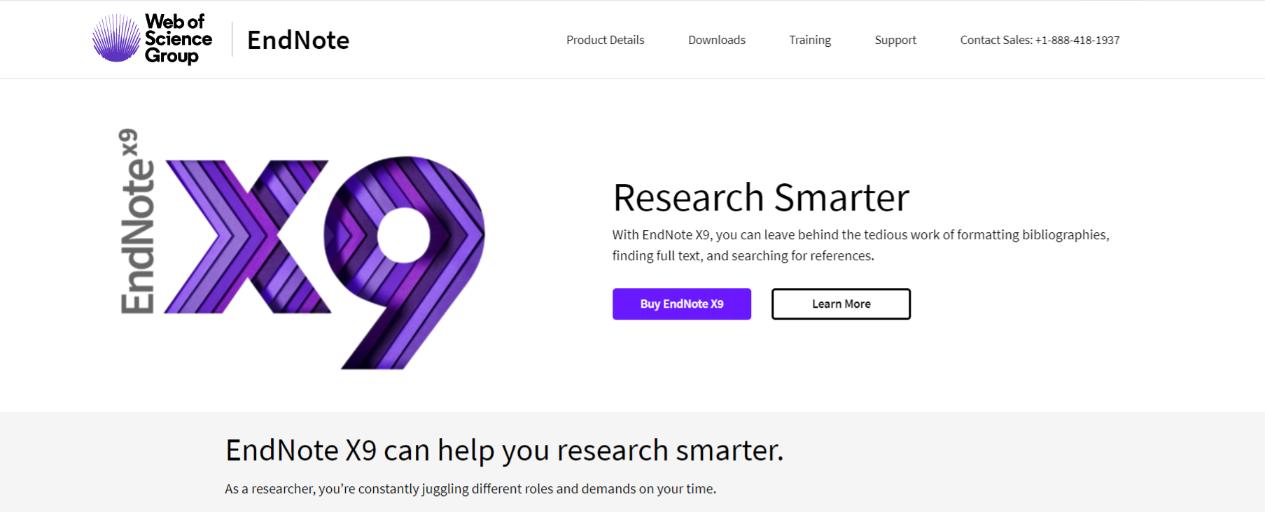
Endnote wants you to research smarter by simplifying the tiresome work of formatting bibliographies, finding full text, and searching for references.
Endnote is collaborative in nature as it allows you to share selected groups of references, manage team access, and track activity and changes from one single dashboard.
With smarter insights, Endnote automatically finds the impact of your references and finds the best-fit journal for your papers.
The platform also enables users to automatically create, format, and update bibliographies. Quickly export your references and full-text PDFs into EndNote and start working instantly.
With a bunch of EndNote templates and plug-ins, researchers can enhance their Endnote experience and get the most out of the platform.
Key Features of Endnote:
- Import filters for prior research
- Track your teammates’ activity on your shared library
- Automatic reference and link updating
- Paid plans start from $249
10. Evernote
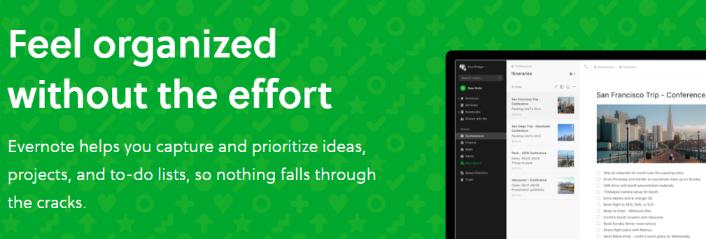
Evernote is a note-taking app that can be very useful while conducting research . The app helps you store all your personal ideas, to-do listsm4, notes, and research links in one place.
Create separate tags and folders for the different types of information you are saving and keep it all organized.
Evernote auto-syncs across all your devices, including desktop, smartphone, and tablet, so you can switch between devices without losing your data.
Its Chrome browser extension called the Evernote web clipper is a great add-on for saving articles or other content on the internet while doing your research.
Just click the browser extension to save the entire page or highlights to your Evernote notebook along with any notes you have about that page.
Key Features of Evernote:
- Keep notes, articles, and other content in one place
- Chrome extension for clipping content
- Set reminders
- Paid plans start from Plus ($34.99 per year or $3.99 per month), Premium ($69.99 per year or $7.99 per month), and Evernote Business (contact sales)
11. Mendeley

Mendeley is a reference management software that allows researchers to create references, citations, and bibliographies in multiple journal styles with just a few clicks.
Quickly access your library from anywhere – from anywhere. Windows, Mac, Linux, etc and add papers directly from your browser with a few clicks or import any documents from your desktop to your library.
With its research network, researchers connect and network with over 6 million users. Users can create groups to carry out discussions, discover research, and follow curated bibliographies.
There are also over 250,000 + science, technology, and health jobs to advance your career and grant info from over 5000 organizations to fund your next research !
Key Features of Mendeley:
- Annotate and organize documents
- Find and create groups with fellow researchers
- Grant information from over 5000 organizations
- Paid plans start from $55/year for 5 GB to $165/year to unlimited storage
12. ContentMine

ContentMine offers a variety of text mining services to help researchers find, download, analyze, and extract knowledge from academic papers.
ContentMine builds its own open-source code to help out researchers find papers and not waste time on the internet doing so. They can also convert academic papers , PDFs to HTML, or to almost any format.
ContentMine can also extract data from tables and graphs, reducing the time taken to conduct a meta-analysis. The platform also offers consultancy as well as training workshops to educate people on the work they do and how.
Key Features of ContentMine:
- Extract data from tables and graphs
- Quickly mine text from hundreds of papers
- Workshops and training
- Contact sales
13. ResearchGate

The last tool on our list of awesome tools for researchers is a platform called ResearchGate. ResearchGate gives you access to over 135 million publication pages, allowing you to stay up to date with what’s happening in your field.
With a built-in community, researchers can share their research, collaborate with peers, and discover new papers and bibliographies.
ResearchGate also provides deep analytics on who’s been reading your work and keeps track of your citations. With over 17 million users, ResearchGate is a research community to join!
Key Features of ResearchGate:
- Share and find researchers
- Analytics to see who’s reading your work
- Citation tracking
Before you go!
Our team at bit.ai has created a few awesome templates to make your research process more efficient. Make sure to check them out before you go, y our team might need them!
- Case Study Template
- Research Paper Template
- Competitor Research Template
- Brainstorming Template
- SWOT Analysis Template
- White Paper Template
Final Words
There you have it folks, our list of amazing websites, apps, and software to use while conducting your research. Research is hard work- from finding and managing content to organizing and publishing- research takes a lot of time and effort.
However, with our awesome list of tools, researchers are surely going to get out the most of their time and effort and get work done more efficiently. Did we miss any awesome tool for researchers out there? Let us know by tweeting us at @bit_docs.

Further reads:
- Top 11 Code Editors for Software Developers
- Collaborative Research: Definition, Benefits & Tips!
- Best Resource Management Tools and Software
- How to Write a Research Proposal?

11 Best Link in Bio Tools in 2024!
Writing Vision Statement: Definition, Examples and Best Practices!
Related posts
How bit.ai can help students better manage their schoolwork, management report: what is it & how to create it, 5 standard operating procedure examples you can use today, the ultimate code review checklist to master code quality, marketing report: definition, types, benefits & things to include, 9 powerful document editors you should use this year.

About Bit.ai
Bit.ai is the essential next-gen workplace and document collaboration platform. that helps teams share knowledge by connecting any type of digital content. With this intuitive, cloud-based solution, anyone can work visually and collaborate in real-time while creating internal notes, team projects, knowledge bases, client-facing content, and more.
The smartest online Google Docs and Word alternative, Bit.ai is used in over 100 countries by professionals everywhere, from IT teams creating internal documentation and knowledge bases, to sales and marketing teams sharing client materials and client portals.
👉👉Click Here to Check out Bit.ai.
Recent Posts
How to build an effective knowledge base for technical support, 9 knowledge base mistakes: what you need to know to avoid them, personal user manual: enhance professional profile & team productivity, 9 document management trends every business should know, ai for social media marketing: tools & tactics to boost engagement, a guide to building a client portal for your online course.

19 Academic Writing Tools (that are completely free!)

A selection of tools for academic writing – from collaborating, time-tracking and project management to finding the perfect phrase or translation. We are continuously updating this list (latest update: April 2023).
I often get asked about my favourite academic writing tools. That’s why I compiled this scientific tools list for you with 19 great tools to support your academic writing. You can use all these scientific research tools for free and some of them have paid versions with additional features.
Just one word of caution: Exploring new academic writing tools can be a time-suck and distract you from getting your actual writing done. If you are one of those people who spend hours signing up for new software for academic writing and getting it set up, only to abandon the tool a few days or weeks later – then be careful reading this scientific tools list, and don’t get overenthusiastic. 😉
By the way, I don’t have any affiliation with any of the academic writing tools listed below, and none of these are affiliated links.
Here, we go, 19 tools for academic writing and scientific research I recommend in no particular order:
ACADEMIC Writing tools
1. writefull.
This proof-reading tool for scientific texts is powered by AI and big data. You can integrate the Writefull app into Word or Overleaf for free. A reader of the blog brought my attention to this tool (thank you so much!) and I’ve only recently started using it, so I can’t give you a full-blown review just yet but so far the results are promising. Writefull is owned by Digital Science, a company that has released several Open Science apps, such as figshare, Overleaf and Altmetric.
2. Phrasebank
Created by Dr John Morley from “The University Language Center” of Manchester University, the Phrasebank is a database of common phrases used in papers, dissertations and grant proposals – a real goldmine!
The phrases are organised both by the common sections in a paper such as the Introduction, Methods, Results or Discussion section. For example, in the tab for the Introduction section, one can find entries for “establishing the importance of the topic for the world or society” or “identifying a knowledge gap in the field of study”. If you click on the latter, you can find among others the following suggested phrases: “It is still unclear whether…”, “However, the behaviour of X has not yet been investigated” and “Causal factors leading to X remain speculative”.
You can also look for phrases by choosing a general language function. Some of the choices are “being cautious”, “describing trends”, “signalling transition”.
The Phrasebank is very useful to get inspiration for new wording but I do not endorse all entries. Sometimes you find language that is a bit clunky or overly complicated so do use your own judgement when you browse this academic writing tool. PS: You can also download the Academic Phrasebank as PDF or Kindle file.
3. Thesaurus.com
If you’re looking for synonyms, thesaurus.com is the best online thesaurus I’ve found so far. It divides the synonyms based on different meanings of the word and indicates the relevance of the synonym by using three shades of orange.
Just one word of caution: Don’t fall into the trap of using too many synonyms in your academic writing. Being precise is so much more important than varying the words you are using in your writing. In particular for field-specific terminology, I advise against using synonyms .
This is a hot tip for researchers who need to transcribe interviews (hello, social scientists!), who like to record research ideas or those who like to write by dictating text into their phone. Otter is an AI-based transcription tool that works for English language recordings. The quality of the transcriptions is comparable to other transcription services using AI, meaning they are often not accurate and can give nonsensical, even comical results — especially when the recorded voice has a strong or unusual accent. Still, the automated and quick transcriptions (real time transcriptions are available too!) can be a good starting point and are a huge time saver. What’s cool about Otter compared to its competitors is that they give you 300 minutes of transcriptions per month for free!
There are many online dictionaries but Linguee is my favourite for academic writing. It suggests a translation on the basis of previous translations published on the internet. Therefore, this dictionary is especially great if you’re looking to not only translate a word but a certain turn of phrase or idiom. Linguee translates to and from English in over 20 languages. An essential academic writing tool for all non-native English speakers!
ACADEMIC WRITING TOOLS FOR Collaboration AND CO-WRITING
6. authorea.
The magazine “ TechCrunch ” describes Authorea as “a Google Docs for scientists”. On the academic writing platform, you can write, edit, and insert citations, figures and data. And it’s great for collaborative writing: Co-authors can access the same text at the same time, track the changes they made, insert comments and even live-chat during writing sessions. Documents can be imported from LaTeX and Word and exported as LaTeX, Word and PDF documents. You can also submit your article as a bioRxiv preprint straight from the Authorea platform. This software for academic writing is free for up to ten documents with limited sharing options.
7. Overleaf
Overleaf is to LaTeX users, what Authorea (see tool #6) is to Word users: an online editor that allows you to access and collaborate on your writing projects from anywhere. You can, for example, invite others to comment on your work. Overleaf offers some other neat collaborative writing features, such as a track-changes function, but – unfortunately – only on the paid plan. LaTeX may seem a bit intimidating at first but you actually get the hang of it quite fast (and feel like a coder 😎). Also, in my experience, you save a lot of time formatting your text (and feel smug about it when you talk to Word users 😁).
Slack is a chat tool that you can use in your lab or with your collaborators. Used in the right way, it allows you to save time by cutting down on emails and create a group atmosphere even if the members are not working in the same location. You can easily add files to the chats and create different channels for subgroups or certain topics. There also exist virtual communities on Slack you can join, such as the New PI Slack community for Assistant professors around the world.
Loom is a great scientific research tool when you want to share a quick video with a colleague, student or collaborator. This could be a recorded presentation or lecture, your comments on the paper of a co-author, or a tutorial on using a piece of software. You can record your screen, camera and microphone. The neat thing is that after you’re done recording, Loom auto-generates a link you can share.
Academic writing tools for Productivity and project management
Toggl is a time-tracking app that you can install on your phone and computer. There’s only one way of knowing how long certain writing tasks typically take you, and that is by tracking the time they took you to complete . Time-tracking has another great advantage: You can identify time-sucks in your day. And these may be less obvious than you think.
I like to use Toggl for time-tracking because it’s quick to use and integrates with various other scientific research tools I am using. You just need to click the big red power button to start or stop a recording and assign tracked times to different projects. This scientific research tool has paid plans but for most people the free basic plan will be sufficient.
Are you easily tempted to check your phone when you really should be writing? This app called Forest may be just right for you then. Once installed on your phone, you can start planting a virtual tree whenever you want to focus. It grows from a little plant to a full-grown tree. When you pick up your phone and leave the app, the tree dies. This way, you can build your forest representing the time you have spent on focused work (or quality time with your family and friends…). I’m not using Forest myself, but I’ve heard that it works really as an academic writing tool well for some people. Give it a go!
12. Focusmate
As Forest (see tool #11), Focusmate is an app to help you stay focused. Instead of gamification, the concept of Focusmate is based on social accountability. Here is how it works: You schedule a 50-minute virtual co-writing session with another Focusmate member, turn on your webcam when your session starts, greet your temporary co-worker and then get to work silently.
Even though being filmed while working is a little strange in the beginning, co-writing sessions work really well for a lot of researchers. This is why we offer co-writing sessions as part of our academic writing program, the Researchers’ Writing Academy, as well.
13. Cold Turkey
If Forest (tool #11) or Focusmate (#12) don’t get you to focus on your writing, you may need to go Cold Turkey . This software for academic writing blocks any other application and turns your computer into a typewriter. You can choose whether you want Cold Turkey to prevent you from digital distractions for a certain amount of time or until you’ve hit a certain word count. With the paid version, you can even access integrated productivity soundtracks and text formatting.

Not an app exactly, but free as well: Click the orange button below to have me walk you through my step-by-step system to write clear & concise papers for your target journals in a timely manner . This free academic writing training is perfect for you if you’re reading this blog post because you are procrastinating on writing your paper.
Trello is an excellent project management tool for your academic writing, which you can use for managing each of your writing projects, for creating a publication pipeline and as a daily and weekly to-do list. Trello is a great introduction into project management because it’s a lot easier to learn and use than most other project management software. For each project called a “Board”, you can create different “lists”, which are vertical collection of “cards”, which you can move between lists. You can add due dates, checklist lists, links, files and text to each card. To work collaboratively, you can leave comments on cards and assign them to members on your team. You can also use Trello as a brainstorming tool, using the cards just as you would use post-it notes.
Members of my online course, the Researchers’ Writing Academy , get access to Trello templates I created to easily manage their publication pipeline, the writing process for each of their scientific papers and all of their other daily, weekly and monthly tasks and projects.
15. Todoist
Todoist is an alternative to Trello (see tool #16) or can be used in addition. It’s an online to-do list organiser and project management tool that comes as an app and browser version. You can organise your tasks in projects and schedule them for a certain day. This academic writing tool shows you today’s tasks as well as those for the next seven days. It also tracks your productivity, i.e. how many tasks you have completed.
academic writing Tools for finding and reading the literature
Feedly is a neat RSS feed manager that helps you stay up to date with the scientific literature. Instead of getting email alerts from journals (because who wants to get more emails…) you can view and organise the literature you are interested in by following journals’ RSS feeds. You can not only use this for scientific literature but also subscribe to blogs, for example the one you’re reading right now, by simply putting the URL in the Feedly search: https://annaclemens.com/blog .
Are you a mindmapper? Then you need Xmind , a free mindmapping and brain-storming tool. It’s intuitive, looks good and does exactly what you want a mindmapping tool to do. The free version allows for embedding of hyperlinks, images, attachments, so you can really use it however you like! That’s all I can really say about it as I’m not using mindmapping myself. But I know scientists who swear by it!
18. Audemic
Audio formats have become so popular (I’m a big podcast lover myself!) so it shouldn’t really come as a surprise that there now is an audio tool available for the scientific literature too: Audemic . This tool — completely free to use for individual researchers — creates summaries for you (that go beyond the abstract), lets you skip sections, highlight text and take notes while listening.
There are a few reference managers for your academic writing to choose from, some of which cost money. Zotero is free, open-source and doesn’t lack in functionality. You can easily save references from your browser, organise them in folders and with tags and create bibliographies with the right style. You can also create a citation library with your co-authors or share your library with others.
That’s it: 19 academic writing apps and scientific research tools to support your writing for free! However, the best academic writing software won’t make you more productive if you don’t rely on a streamlined writing process and if you aren’t using your writing sessions effectively. If you want to get your hands on a template to write scientific papers in a systematic fashion, sign up for this 1-hour writing training now. It’s free too!

Share article
© Copyright 2018-2024 by Anna Clemens. All Rights Reserved.
Photography by Alice Dix
8 Must-Have Tools for Researchers in 2023 (Including AI)
.png)
Table of contents

Chelsea Forsyth
A growing number of researchers are already using AI tools to improve their work exponentially.
I am referring to all kinds of academic researchers here, including:
- Computer scientists,
- statisticians,
- economists,
- and social scientists.
Among other benefits, AI allows them to analyse large amounts of data and uncover patterns and insights. In one study , AI systems were found to be 87% accurate in detecting a disease state, and 93% accurate in clearing patients. From improved accuracy and efficiency to faster results and more data points, AI is revolutionizing research across the globe and opening up exciting new opportunities.
If you want your research to stand out, there’s no substitute for hard work and hours of study. However, whether you’re a student writing a paper or a professional trying to establish yourself in your field, software tailored to your needs can make that hard work go exponentially further. From data analysis to collaboration tools, the best research tools can streamline your workflow, increase productivity, and improve the accuracy and reliability of your findings.
In this article, we'll explore the top 8 tools for researchers and explain some lesser-known tips for using them to save time and hassle in your academic or scientific endeavors.
Let AI find flaws in your research paper > Get Wordtune and find flaws in your research paper >

1. SciSpace
SciSpace — formerly Typeset — is a brilliant tool for academics and researchers who create white papers, technical documentation, or research papers.
Created with the aim of “making science more collaborative and accessible,” SciSpace allows users to search its expansive database for papers, authors, and topics of interest. Once you’ve found sources, you can use innovative AI features such as “summarize introduction” or “dataset used” to help you quickly understand and digest complex and lengthy research papers. These features feel reliable and highly useful, providing accurate and informative answers when tested.

The homepage also promotes popular research papers, highlights the most-read journals at that point in time, and displays the trending research topics of the day, so is a great place to discover new information. Plus, SciSpace offers a fast and efficient citation generator in 2,551 different citation styles — including American Psychological Association and Modern Language Association — as well as auto-ordering citations. You can get started with SciSpace for free by heading to the website and creating an account — this offers up to 30 output previews, downloads of up to 1000 words, and 5 bibliography downloads. But if you’d prefer access to unlimited output previews, bibliographies, and downloads, you’re better off upgrading to a paid account starting at $8 a month.
2. Wordtune Read
Need to get up to speed with complex, lengthy information in a short amount of time? Then you'll love Wordtune Read .

This AI reader summarizes long documents for you so you can digest more information faster. You can source this material however you like, whether online or from your own archives—upload a PDF, paste in a link, or simply copy text into the reader. Whichever you choose, Wordtune Read will provide you with a succinct list of easy-to-understand bullets.
Wordtune Read offers a free plan that allows you to get five pieces of content summarized each month. If you find it helpful, you can upgrade to one of the premium plans, starting at $9.99 a month.
Visual project management tool Trello is a free web-based platform that allows you to organize ideas, tasks, and projects in an efficient and aesthetically pleasing way. It’s a perfect organization tool for people who value simplicity — and color coding.
Trello allows you to organize your projects into boards containing various lists, or “cards,” to sort your tasks onto. Within each list, you can break down each task further by adding notes or to-dos. The website describes itself as similar to a whiteboard filled with Post-it notes, where each Post-it is a task with further detail attached.
Trello is also a brilliant tool for collaborating with team members; you can share your boards, give collaborators editing access, and assign tasks and deadlines to team members. The platform also integrates with other tools, such as Google Drive. This makes it easy to access and store research data, even on your phone via the Trello mobile app .
If 10 free boards aren’t enough for you, Trello also offers premium plans—the cheapest of which starts at $5 a month.

4. GanttPRO
GanttPRO is another project management tool that can help researchers track their progress and plan upcoming tasks. It’s a little bit more in-depth than Trello; as the name suggests, it enables users to create Gantt charts as visual timelines and task lists, making it easy to keep track of deadlines and track project progress.
Gantt charts are brilliant for helping you gain a visual overview of your project, demonstrating the relationship between task start and end dates, important project milestones, impending deadlines, and any tasks that depend on other tasks being finished before you can get started. GanttPRO also provides detailed collaboration features that enable researchers to work together more efficiently, such as assigning comments, inserting links into descriptions, attaching files, and receiving real-time notifications. For this reason, I’d recommend this tool for researchers collaborating with other academics, rather than those working alone (Trello is probably preferable in that instance).
While it’s a little less beginner friendly than a program like Trello, GanttPRO has an extensive learning center on its website that can help researchers get familiar with all the features.
Though you can trial it for free, GanttPRO doesn’t offer a free plan. The Basic plan costs $9.99/month for one user, or $7.99/month if split between 5 users.

5. ResearchGate
ResearchGate is a free professional network for scientists and researchers. The platform allows students or researchers to connect with other academics, ask questions, get answers related to their research, and find resources to help them in their studies.
This tool is particularly useful for students—you can reach out directly to the author to request full texts from researchers, which is invaluable if you find a paper that could enhance your own research. You can also see where papers have been referenced in other research, which can provide a useful trail for you to follow to gain more insight into your chosen subject. In particular, ResearchGate is a great way for students or researchers to stay up-to-date with the latest research in their field. There’s even a feature that allows you to publish your research and get feedback from peers, a great tool for academics looking to improve their work.

6. Cite This For Me
Picture the situation: you’ve spent hours composing a research or academic paper and have finally finished—only to realize that all your references are in the wrong format.
Cite This For Me , an online tool that can automatically generate Harvard, APA, and MLA citations and bibliography entries, can take the struggle out of formatting citations. It’s free and simple to use—just add the relevant details of the website, book, or journal you’ve referenced and you’ll have your citation in seconds. You can then paste this into your work. It also offers a plagiarism checker, which checks your paper against billions of sources for any accidental plagiarism—though you do have to upgrade to use this feature. The website doesn’t make it extremely clear how much this costs, but it looks like a monthly payment of $6.99 or a one-off payment of $19.99 gives you access to the full version.

7. Scrivener
Scrivener might be better known as a must-have tool for writers, but it's also perfect for researchers and students. Ideal for long-form content, Scrivener works as both an outliner and word processor and makes it easy to manage and organize outlines, notes, concepts, research, documents, and your final draft—all in one interface.
Each Scrivener project is organized as its own filing system and has three root folders: Draft, Research, and Trash. These folders are present in every project, but otherwise, you can organize them as you like. The Research folder alone is a powerful tool that can store various types of files, including text files or notes, PDFs, graphics, audio files, videos, and photos. Add an overview to each section in any folder for a simplified view of your project as a whole.
When writing in the Draft folder, you can add outline elements to each section and move sections around with Scrivener's drag-and-drop interface, so you don't have to worry about writing your paper in chronological order. Scrivener can also sync between your Mac, Windows, or iOS devices with the help of Dropbox .
When you’re done drafting, Scrivener makes it simple to compile the various portions of your manuscript into a single document and export it.
Scrivener costs $49 for a lifetime Windows or Mac license for a single device, though you can get 15% off if you're a student or academic. You can also test-drive it with a free 30-day trial or get it at a reduced rate of $23.99 on an iOS device .

8. Google Scholar
Google Scholar is a free search engine that focuses entirely on scholarly literature and academic sources. All you need to get started to find relevant research is a Google account.
Google Scholar is super easy to use, as its interface is similar to that of the Google search engine. There are, however, a number of useful differences. For instance, you can copy a citation in various formats, export bibliographic data, and explore related links to find, for example, publications that have cited the listed work. Another Google Scholar hack for researchers is the ability to locate an open-access version of a paid source. Below an article's title and short description are links, including "Save" and "Cite." If Google finds another version of the article, there will also be a link to "All versions." You can click this to see if there are any open-access versions of an article locked behind a paywall.

Time to start your research
Whether you need to collect and organize data with a tool like Scrivener, use Wordtune Read to summarize a lengthy source, or plan out your project on GanttPRO, there’s a tool on this list to help make your research process easier and more efficient.
By letting AI and other tools do the repetitive work for you, you can save time while staying accurate and focusing your energy on the most important, innovative parts of your research.
Share This Article:
.webp)
How to Craft Your Ideal Thesis Research Topic

How to Craft an Engaging Elevator Pitch that Gets Results
.webp)
Eight Steps to Craft an Irresistible LinkedIn Profile
Looking for fresh content, thank you your submission has been received.

10 Best Literature Review Tools for Researchers
This post may contain affiliate links that allow us to earn a commission at no expense to you. Learn more

Boost your research game with these Best Literature Review Tools for Researchers! Uncover hidden gems, organize your findings, and ace your next research paper!
Conducting literature reviews poses challenges for researchers due to the overwhelming volume of information available and the lack of efficient methods to manage and analyze it.
Researchers struggle to identify key sources, extract relevant information, and maintain accuracy while manually conducting literature reviews. This leads to inefficiency, errors, and difficulty in identifying gaps or trends in existing literature.
Advancements in technology have resulted in a variety of literature review tools. These tools streamline the process, offering features like automated searching, filtering, citation management, and research data extraction. They save time, improve accuracy, and provide valuable insights for researchers.
In this article, we present a curated list of the 10 best literature review tools, empowering researchers to make informed choices and revolutionize their systematic literature review process.
Table of Contents
Top 10 Literature Review Tools for Researchers: In A Nutshell (2023)
#1. semantic scholar – a free, ai-powered research tool for scientific literature.
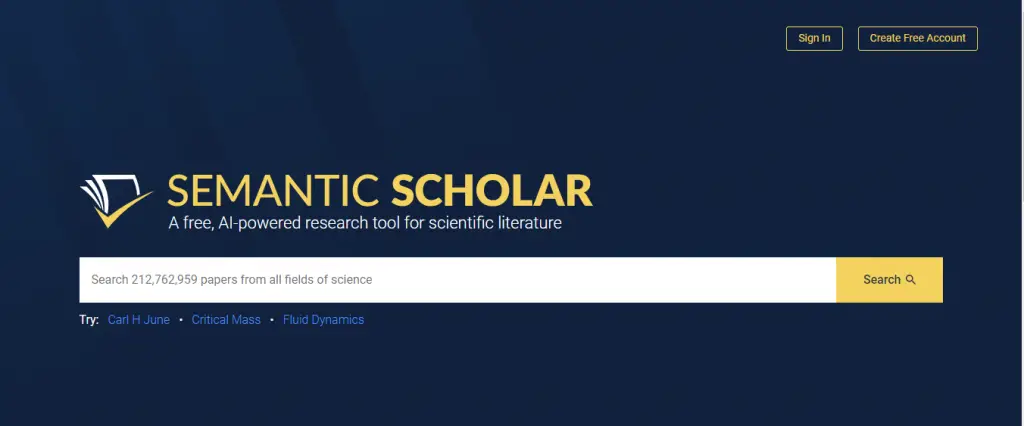
Semantic Scholar is a cutting-edge literature review tool that researchers rely on for its comprehensive access to academic publications. With its advanced AI algorithms and extensive database, it simplifies the discovery of relevant research papers.
By employing semantic analysis, users can explore scholarly articles based on context and meaning, making it a go-to resource for scholars across disciplines.
Additionally, Semantic Scholar offers personalized recommendations and alerts, ensuring researchers stay updated with the latest developments. However, users should be cautious of potential limitations.
Not all scholarly content may be indexed, and occasional false positives or inaccurate associations can occur. Furthermore, the tool primarily focuses on computer science and related fields, potentially limiting coverage in other disciplines.
Researchers should be mindful of these considerations and supplement Semantic Scholar with other reputable resources for a comprehensive literature review. Despite these caveats, Semantic Scholar remains a valuable tool for streamlining research and staying informed.
#2. Elicit – Research assistant using language models like GPT-3
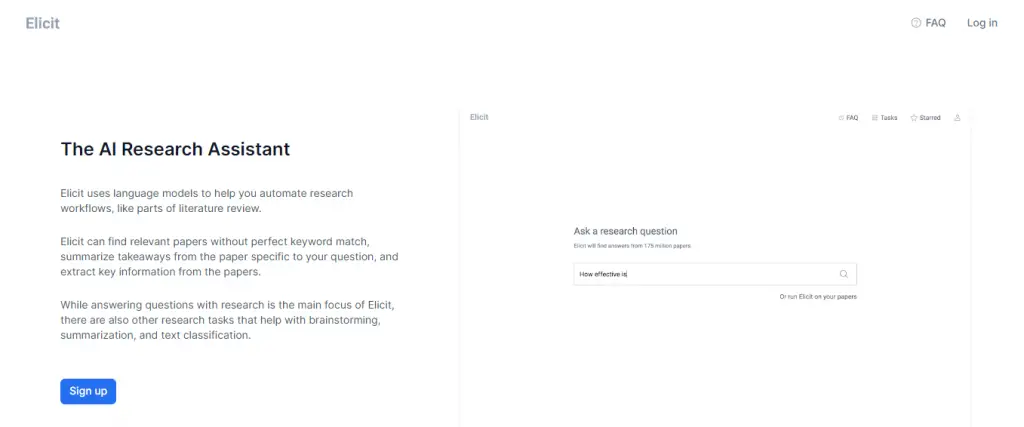
Elicit is a game-changing literature review tool that has gained popularity among researchers worldwide. With its user-friendly interface and extensive database of scholarly articles, it streamlines the research process, saving time and effort.
The tool employs advanced algorithms to provide personalized recommendations, ensuring researchers discover the most relevant studies for their field. Elicit also promotes collaboration by enabling users to create shared folders and annotate articles.
However, users should be cautious when using Elicit. It is important to verify the credibility and accuracy of the sources found through the tool, as the database encompasses a wide range of publications.
Additionally, occasional glitches in the search function have been reported, leading to incomplete or inaccurate results. While Elicit offers tremendous benefits, researchers should remain vigilant and cross-reference information to ensure a comprehensive literature review.
#3. Scite.Ai – Your personal research assistant
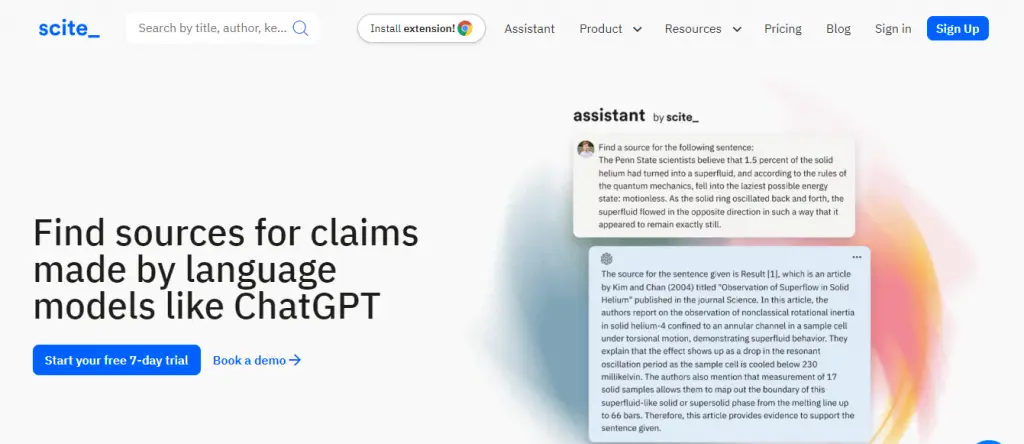
Scite.Ai is a popular literature review tool that revolutionizes the research process for scholars. With its innovative citation analysis feature, researchers can evaluate the credibility and impact of scientific articles, making informed decisions about their inclusion in their own work.
By assessing the context in which citations are used, Scite.Ai ensures that the sources selected are reliable and of high quality, enabling researchers to establish a strong foundation for their research.
However, while Scite.Ai offers numerous advantages, there are a few aspects to be cautious about. As with any data-driven tool, occasional errors or inaccuracies may arise, necessitating researchers to cross-reference and verify results with other reputable sources.
Moreover, Scite.Ai’s coverage may be limited in certain subject areas and languages, with a possibility of missing relevant studies, especially in niche fields or non-English publications.
Therefore, researchers should supplement the use of Scite.Ai with additional resources to ensure comprehensive literature coverage and avoid any potential gaps in their research.
Rayyan offers the following paid plans:
- Monthly Plan: $20
- Yearly Plan: $12
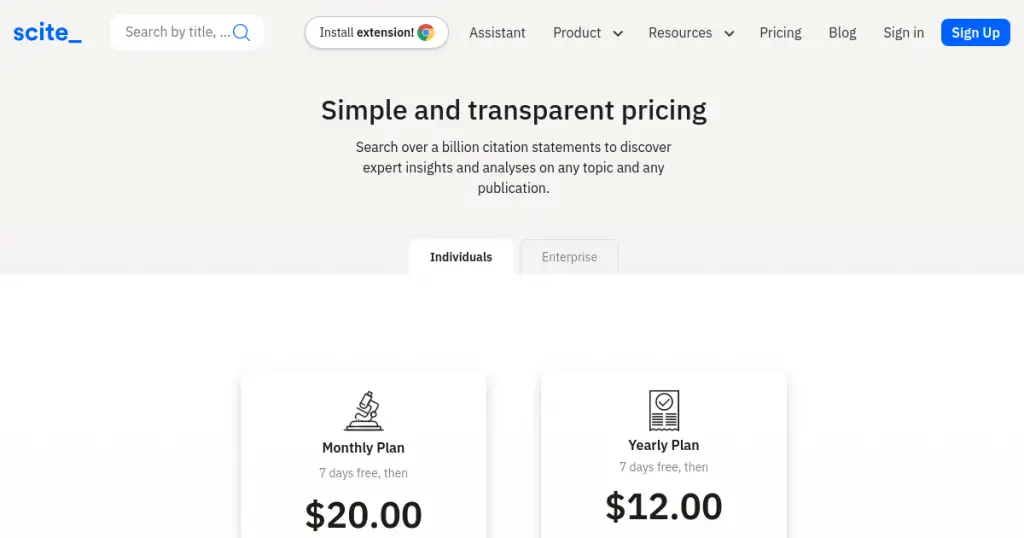
#4. DistillerSR – Literature Review Software
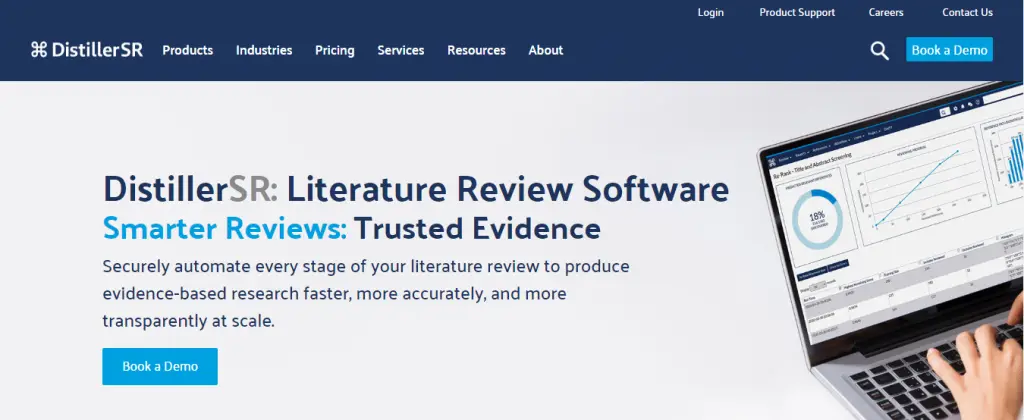
DistillerSR is a powerful literature review tool trusted by researchers for its user-friendly interface and robust features. With its advanced search capabilities, researchers can quickly find relevant studies from multiple databases, saving time and effort.
The tool offers comprehensive screening and data extraction functionalities, streamlining the review process and improving the reliability of findings. Real-time collaboration features also facilitate seamless teamwork among researchers.
While DistillerSR offers numerous advantages, there are a few considerations. Users should invest time in understanding the tool’s features and functionalities to maximize its potential. Additionally, the pricing structure may be a factor for individual researchers or small teams with limited budgets.
Despite occasional technical glitches reported by some users, the developers actively address these issues through updates and improvements, ensuring a better user experience.
Overall, DistillerSR empowers researchers to navigate the vast sea of information, enhancing the quality and efficiency of literature reviews while fostering collaboration among research teams .
#5. Rayyan – AI Powered Tool for Systematic Literature Reviews
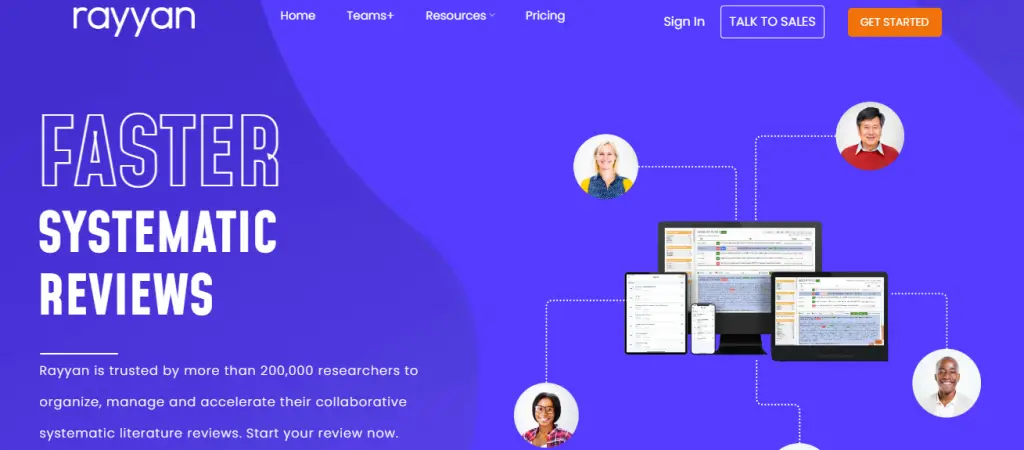
Rayyan is a powerful literature review tool that simplifies the research process for scholars and academics. With its user-friendly interface and efficient management features, Rayyan is highly regarded by researchers worldwide.
It allows users to import and organize large volumes of scholarly articles, making it easier to identify relevant studies for their research projects. The tool also facilitates seamless collaboration among team members, enhancing productivity and streamlining the research workflow.
However, it’s important to be aware of a few aspects. The free version of Rayyan has limitations, and upgrading to a premium subscription may be necessary for additional functionalities.
Users should also be mindful of occasional technical glitches and compatibility issues, promptly reporting any problems. Despite these considerations, Rayyan remains a valuable asset for researchers, providing an effective solution for literature review tasks.
Rayyan offers both free and paid plans:
- Professional: $8.25/month
- Student: $4/month
- Pro Team: $8.25/month
- Team+: $24.99/month
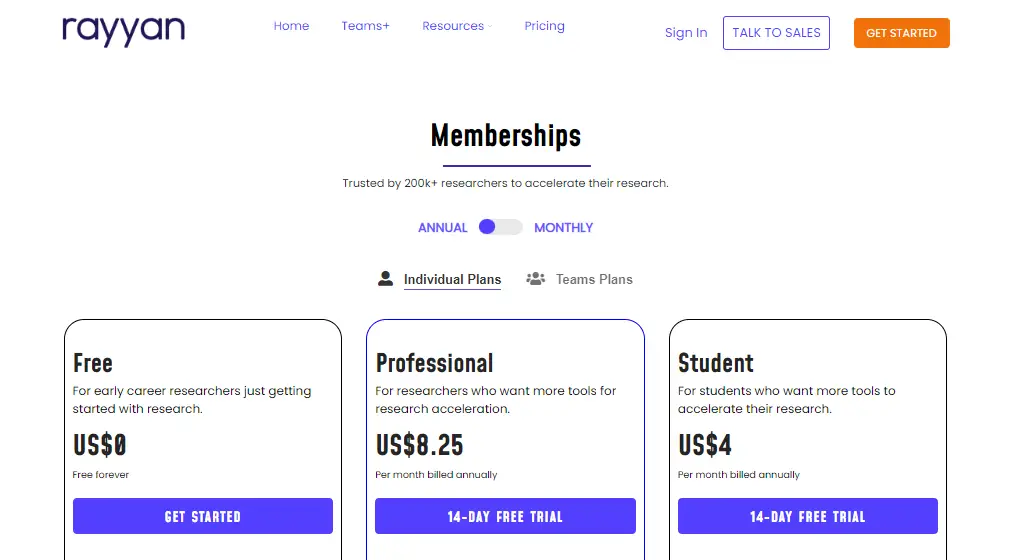
#6. Consensus – Use AI to find you answers in scientific research
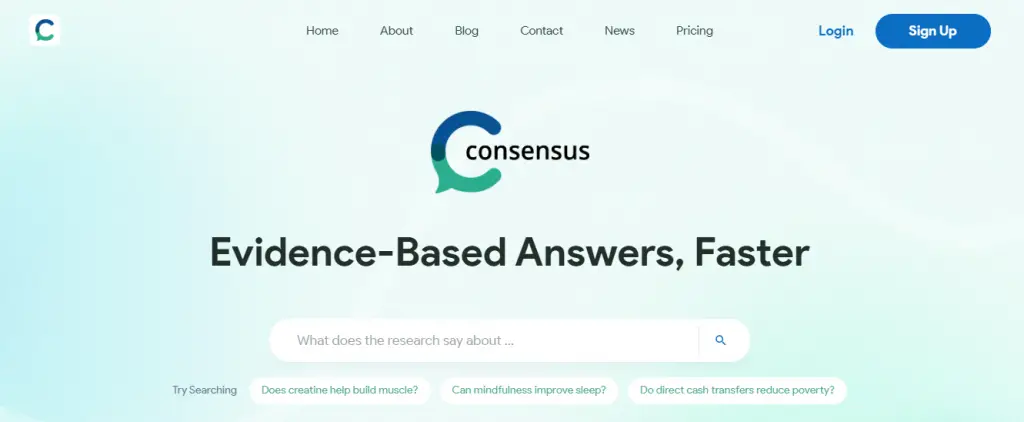
Consensus is a cutting-edge literature review tool that has become a go-to choice for researchers worldwide. Its intuitive interface and powerful capabilities make it a preferred tool for navigating and analyzing scholarly articles.
With Consensus, researchers can save significant time by efficiently organizing and accessing relevant research material.People consider Consensus for several reasons.
Its advanced search algorithms and filters help researchers sift through vast amounts of information, ensuring they focus on the most relevant articles. By streamlining the literature review process, Consensus allows researchers to extract valuable insights and accelerate their research progress.
However, there are a few factors to watch out for when using Consensus. As with any automated tool, researchers should exercise caution and independently verify the accuracy and relevance of the generated results. Complex or niche topics may present challenges, resulting in limited search results. Researchers should also supplement Consensus with manual searches to ensure comprehensive coverage of the literature.
Overall, Consensus is a valuable resource for researchers seeking to optimize their literature review process. By leveraging its features alongside critical thinking and manual searches, researchers can enhance the efficiency and effectiveness of their work, advancing their research endeavors to new heights.
Consensus offers both free and paid plans:
- Premium: $9.99/month
- Enterprise: Custom

#7. RAx – AI-powered reading assistant
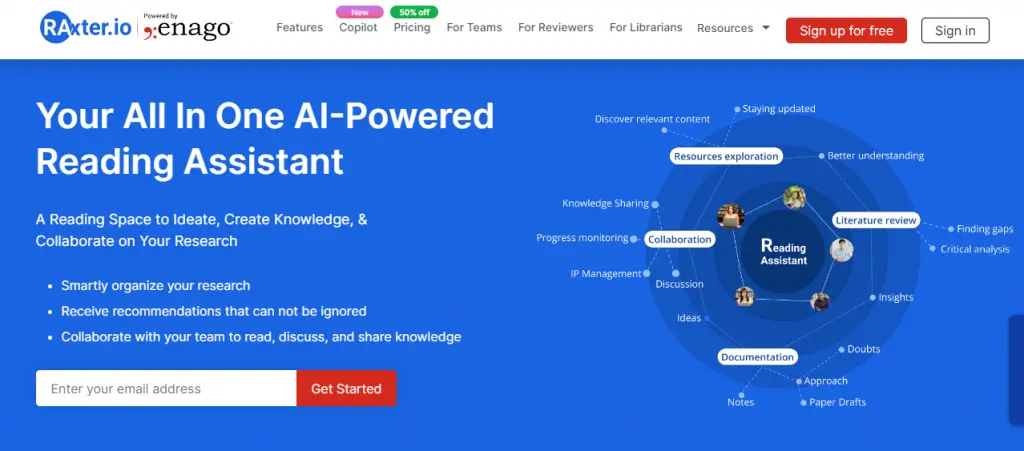
Consensus is a revolutionary literature review tool that has transformed the research process for scholars worldwide. With its user-friendly interface and advanced features, it offers a vast database of academic publications across various disciplines, providing access to relevant and up-to-date literature.
Using advanced algorithms and machine learning, Consensus delivers personalized recommendations, saving researchers time and effort in their literature search.
However, researchers should be cautious of potential biases in the recommendation system and supplement their search with manual verification to ensure a comprehensive review.
Additionally, occasional inaccuracies in metadata have been reported, making it essential for users to cross-reference information with reliable sources. Despite these considerations, Consensus remains an invaluable tool for enhancing the efficiency and quality of literature reviews.
RAx offers both free and paid plans. Currently offering 50% discounts as of July 2023:
- Premium: $6/month $3/month
- Premium with Copilot: $8/month $4/month
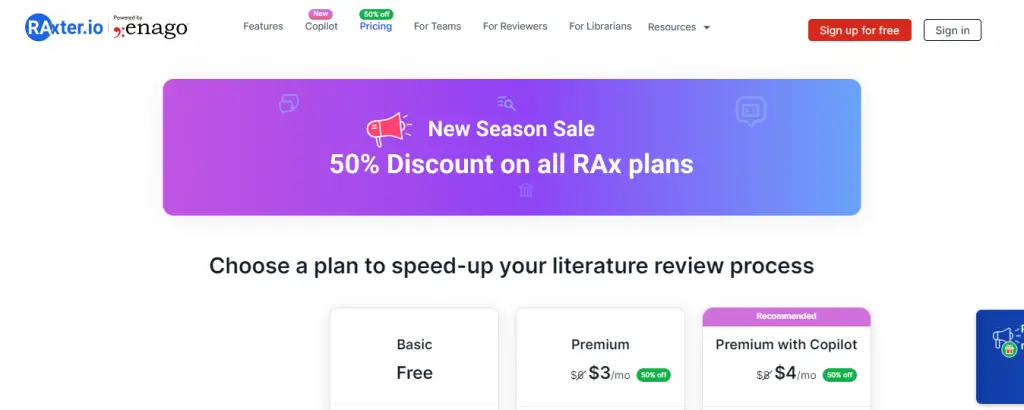
#8. Lateral – Advance your research with AI
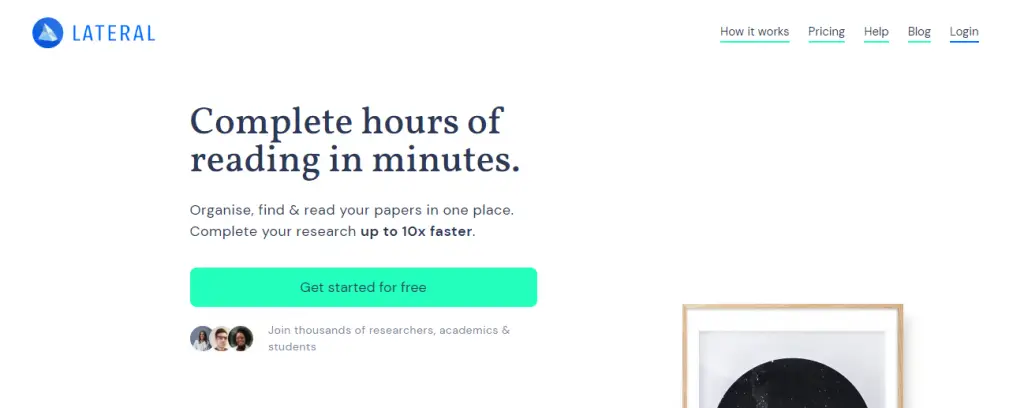
“Lateral” is a revolutionary literature review tool trusted by researchers worldwide. With its user-friendly interface and powerful search capabilities, it simplifies the process of gathering and analyzing scholarly articles.
By leveraging advanced algorithms and machine learning, Lateral saves researchers precious time by retrieving relevant articles and uncovering new connections between them, fostering interdisciplinary exploration.
While Lateral provides numerous benefits, users should exercise caution. It is advisable to cross-reference its findings with other sources to ensure a comprehensive review.
Additionally, researchers must be mindful of potential biases introduced by the tool’s algorithms and should critically evaluate and interpret the results.
Despite these considerations, Lateral remains an indispensable resource, empowering researchers to delve deeper into their fields of study and make valuable contributions to the academic community.
RAx offers both free and paid plans:
- Premium: $10.98
- Pro: $27.46
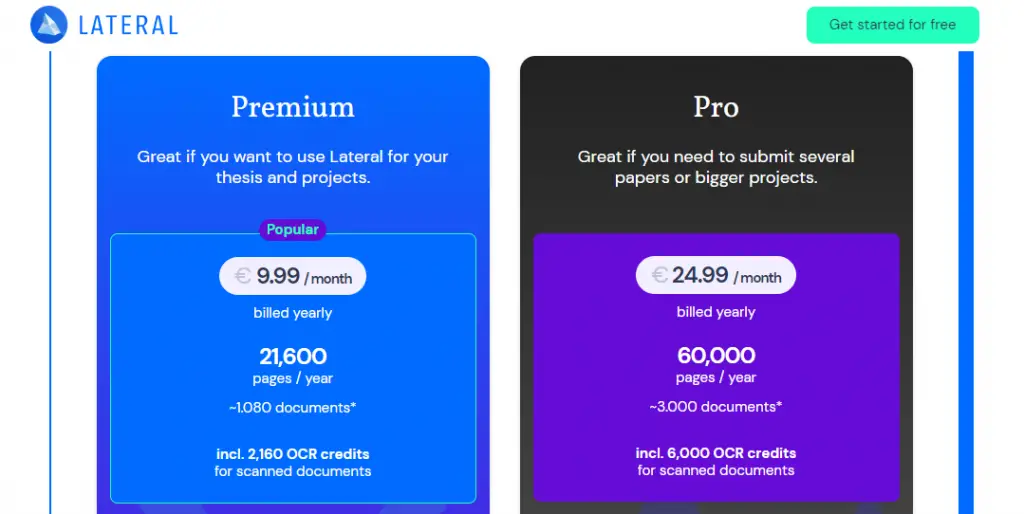
#9. Iris AI – Introducing the researcher workspace
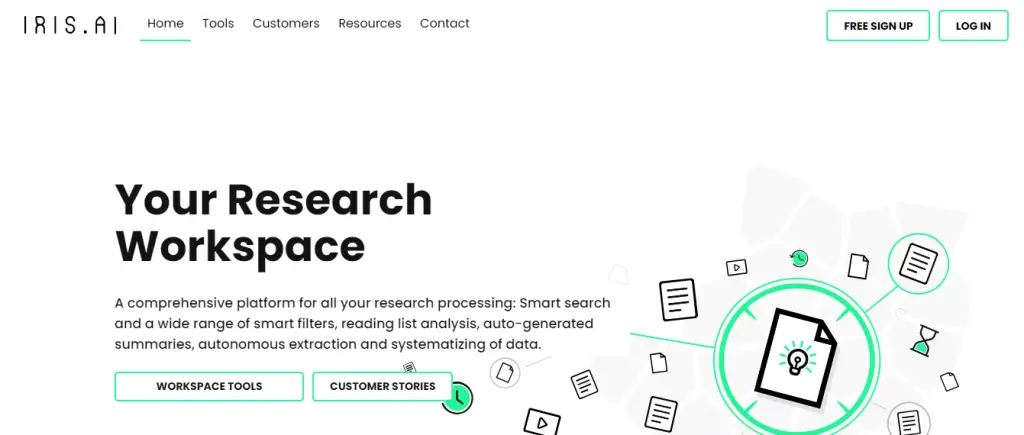
Iris AI is an innovative literature review tool that has transformed the research process for academics and scholars. With its advanced artificial intelligence capabilities, Iris AI offers a seamless and efficient way to navigate through a vast array of academic papers and publications.
Researchers are drawn to this tool because it saves valuable time by automating the tedious task of literature review and provides comprehensive coverage across multiple disciplines.
Its intelligent recommendation system suggests related articles, enabling researchers to discover hidden connections and broaden their knowledge base. However, caution should be exercised while using Iris AI.
While the tool excels at surfacing relevant papers, researchers should independently evaluate the quality and validity of the sources to ensure the reliability of their work.
It’s important to note that Iris AI may occasionally miss niche or lesser-known publications, necessitating a supplementary search using traditional methods.
Additionally, being an algorithm-based tool, there is a possibility of false positives or missed relevant articles due to the inherent limitations of automated text analysis. Nevertheless, Iris AI remains an invaluable asset for researchers, enhancing the quality and efficiency of their research endeavors.
Iris AI offers different pricing plans to cater to various user needs:
- Basic: Free
- Premium: Monthly ($82.41), Quarterly ($222.49), and Annual ($791.07)
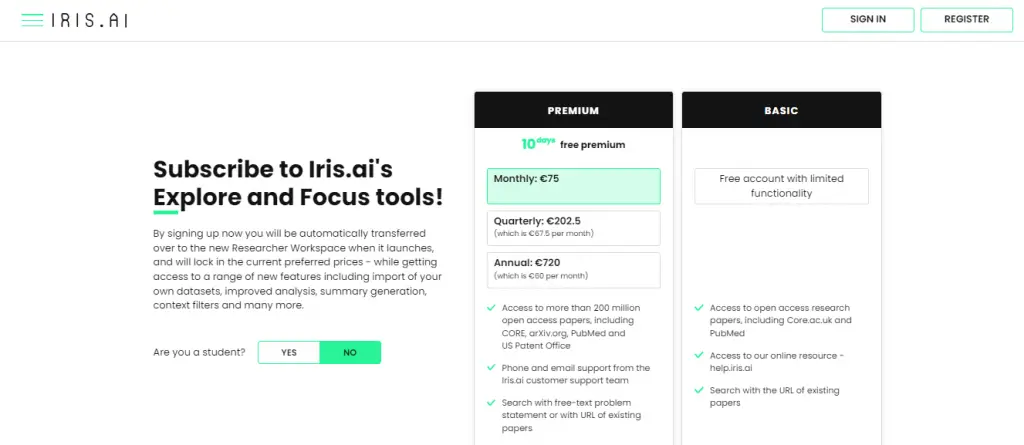
#10. Scholarcy – Summarize your literature through AI
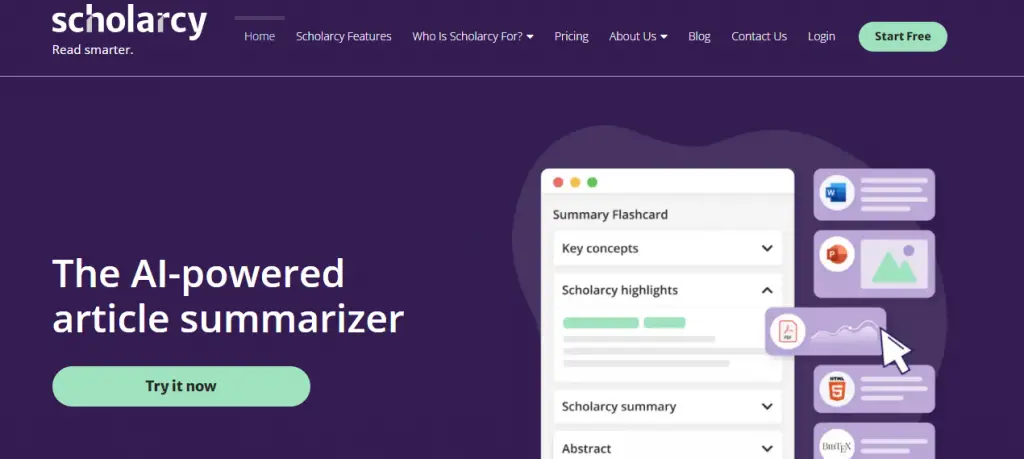
Scholarcy is a powerful literature review tool that helps researchers streamline their work. By employing advanced algorithms and natural language processing, it efficiently analyzes and summarizes academic papers, saving researchers valuable time.
Scholarcy’s ability to extract key information and generate concise summaries makes it an attractive option for scholars looking to quickly grasp the main concepts and findings of multiple papers.
However, it is important to exercise caution when relying solely on Scholarcy. While it provides a useful starting point, engaging with the original research papers is crucial to ensure a comprehensive understanding.
Scholarcy’s automated summarization may not capture the nuanced interpretations or contextual information presented in the full text.
Researchers should also be aware that certain types of documents, particularly those with heavy mathematical or technical content, may pose challenges for the tool.
Despite these considerations, Scholarcy remains a valuable resource for researchers seeking to enhance their literature review process and improve overall efficiency.
Scholarcy offer the following pricing plans:
- Browser Extension and Flashcards: Free
- Personal Library: $9.99
- Academic Institution License: $8K+

Final Thoughts
In conclusion, conducting a comprehensive literature review is a crucial aspect of any research project, and the availability of reliable and efficient tools can greatly facilitate this process for researchers. This article has explored the top 10 literature review tools that have gained popularity among researchers.
Moreover, the rise of AI-powered tools like Iris.ai and Sci.ai promises to revolutionize the literature review process by automating various tasks and enhancing research efficiency.
Ultimately, the choice of literature review tool depends on individual preferences and research needs, but the tools presented in this article serve as valuable resources to enhance the quality and productivity of research endeavors.
Researchers are encouraged to explore and utilize these tools to stay at the forefront of knowledge in their respective fields and contribute to the advancement of science and academia.
Q1. What are literature review tools for researchers?
Literature review tools for researchers are software or online platforms designed to assist researchers in efficiently conducting literature reviews. These tools help researchers find, organize, analyze, and synthesize relevant academic papers and other sources of information.
Q2. What criteria should researchers consider when choosing literature review tools?
When choosing literature review tools, researchers should consider factors such as the tool’s search capabilities, database coverage, user interface, collaboration features, citation management, annotation and highlighting options, integration with reference management software, and data extraction capabilities.
It’s also essential to consider the tool’s accessibility, cost, and technical support.
Q3. Are there any literature review tools specifically designed for systematic reviews or meta-analyses?
Yes, there are literature review tools that cater specifically to systematic reviews and meta-analyses, which involve a rigorous and structured approach to reviewing existing literature. These tools often provide features tailored to the specific needs of these methodologies, such as:
Screening and eligibility assessment: Systematic review tools typically offer functionalities for screening and assessing the eligibility of studies based on predefined inclusion and exclusion criteria. This streamlines the process of selecting relevant studies for analysis.
Data extraction and quality assessment: These tools often include templates and forms to facilitate data extraction from selected studies. Additionally, they may provide features for assessing the quality and risk of bias in individual studies.
Meta-analysis support: Some literature review tools include statistical analysis features that assist in conducting meta-analyses. These features can help calculate effect sizes, perform statistical tests, and generate forest plots or other visual representations of the meta-analytic results.
Reporting assistance: Many tools provide templates or frameworks for generating systematic review reports, ensuring compliance with established guidelines such as PRISMA (Preferred Reporting Items for Systematic Reviews and Meta-Analyses).
Q4. Can literature review tools help with organizing and annotating collected references?
Yes, literature review tools often come equipped with features to help researchers organize and annotate collected references. Some common functionalities include:
Reference management: These tools enable researchers to import references from various sources, such as databases or PDF files, and store them in a central library. They typically allow you to create folders or tags to organize references based on themes or categories.
Annotation capabilities: Many tools provide options for adding annotations, comments, or tags to individual references or specific sections of research articles. This helps researchers keep track of important information, highlight key findings, or note potential connections between different sources.
Full-text search: Literature review tools often offer full-text search functionality, allowing you to search within the content of imported articles or documents. This can be particularly useful when you need to locate specific information or keywords across multiple references.
Integration with citation managers: Some literature review tools integrate with popular citation managers like Zotero, Mendeley, or EndNote, allowing seamless transfer of references and annotations between platforms.
By leveraging these features, researchers can streamline the organization and annotation of their collected references, making it easier to retrieve relevant information during the literature review process.
Leave a Comment Cancel reply
Save my name, email, and website in this browser for the next time I comment.
We maintain and update science journals and scientific metrics. Scientific metrics data are aggregated from publicly available sources. Please note that we do NOT publish research papers on this platform. We do NOT accept any manuscript.
2012-2024 © scijournal.org
- Skip to main content
- Skip to primary sidebar
- Skip to footer
- QuestionPro

- Solutions Industries Gaming Automotive Sports and events Education Government Travel & Hospitality Financial Services Healthcare Cannabis Technology Use Case NPS+ Communities Audience Contactless surveys Mobile LivePolls Member Experience GDPR Positive People Science 360 Feedback Surveys
- Resources Blog eBooks Survey Templates Case Studies Training Help center
Home Surveys Academic Research
Academic Research Tools: What they are + Top 5 Best
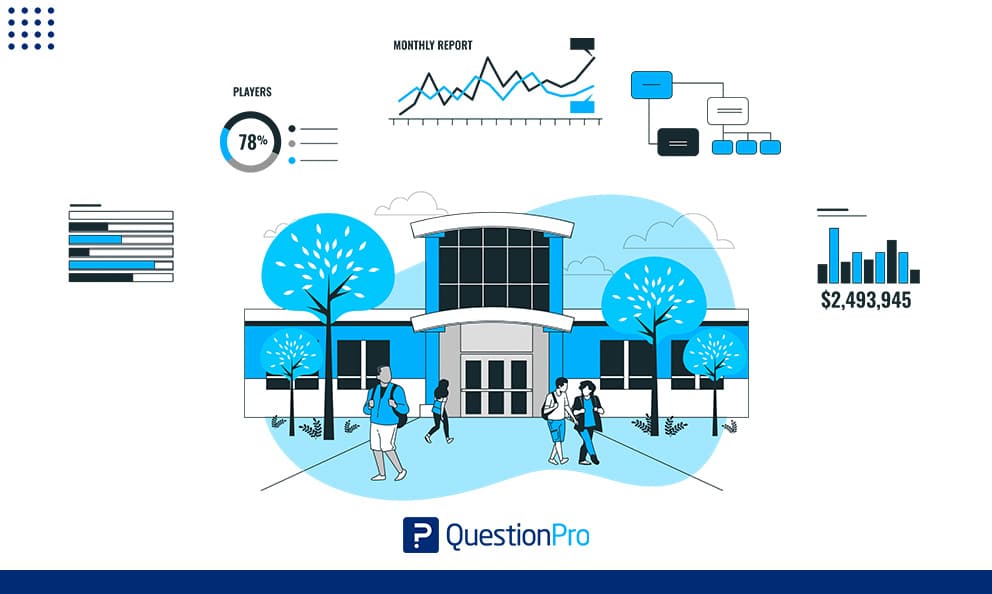
Academic research is a rigorous activity that requires a lot of dedication and diligence to provide great-quality results. Technology has improved how we access information by making access to information faster and more effective, so we carry out research more efficiently.
When conducting research, you must have the best methods and tools to facilitate the process. Every researcher needs a typing assistant to review spelling, grammar, and punctuation mistakes. If your research involves data analysis, you need a statistical research tool. You’ll probably need a virtual library for consulting if it involves psychology or sociology.
What are academic research tools?
An academic research tool is a software or platform that helps researchers organize, analyze, and manage the various components of their research projects. Some examples of academic research tools include reference management software, data visualization software, and survey design tools. These tools are designed to support the various stages of the research process, from literature review and data collection to data analysis and publication.
Reference management software, such as Mendeley or Endnote, allows researchers to organize and manage their bibliographic references and citations. This can be particularly helpful for large literature reviews, as it allows researchers to easily search and access their reference library and format citations and bibliographies in various styles. Additionally, many reference management tools offer features like annotation and collaboration, so researchers can share their reference libraries with colleagues and work on them together.
Data visualization software, like Tableau or R, can help researchers to explore and understand their data. These tools allow researchers to create interactive visualizations from their data, such as charts, graphs, and maps. This can be very useful for identifying patterns and trends that might not be immediately apparent from looking at raw data. These tools also provide a way to communicate the findings from their research clearly and effectively, as visualizations can be more easily understood than raw data.
Data collection software is another important tool that can support the research process. This software can be used to design and administer surveys, collect and store data, and manage participant information. Top data collection software such as QuestionPro offers a variety of question types, such as multiple choice, rating scales, and open-ended questions. They can be used to conduct surveys online or in person. This software also provides features like skip logic, data validation, and data export, which can help to ensure data quality and facilitate analysis. Some data collection software also integrates with data visualization or statistical software, making it easy to analyze and visualize once data is collected.
Top 5 Academic Research Tools
There are endless tools for academic research that can help you in any stage of the research process, from educational search engine software and project management tools to grammar editors and reference managers. Adopting these technologies can improve the quality of academic research, regardless of the field or topic.
From the multiple options in the market, we made a list of the best five academic research tools you can use to level up your academic research:
EndNote gives you the tools you need for searching, organizing, and sharing your research. It allows you to easily create bibliographies while writing your following paper with features like Cite While You Write. Maximize your time with features like finding full text for your references and automatically updating records.
Whether you’re on your desktop, online, or iPad, EndNote’s syncing capabilities let you access all of your references, attachments, and groups from anywhere.
Bit AI is an excellent tool for collaborating on research with your team. It’s essentially like a Google Docs but specifically made for research. You can upload and share different file formats, including PDFs, videos, white papers, etc., and then edit them together with your team.
Typeset is a great tool when it comes to writing your own research papers. You can upload all your references for simple citations and check your work for spelling errors and plagiarism. Typeset also offers features to collaborate with your teammates and get the work done together.
2. Google Scholar
Google Scholar is a classic tool that only some people know about. It’s essentially a version of the traditional Google search but focused on scientific and academic papers, journals, books, and other publications. Instead of using Google, you can use Google Scholar to eliminate the risk of citing non-credible sources.
1. QuestionPro
Most academic research, regardless of field or topic, requires data analysis so the information can have a solid foundation. Online surveys are critical to examine population samples so hypotheses can be proved or disregarded. While methods and techniques may vary, QuestionPro survey software is an excellent academic research tool for conducting online surveys.
QuestionPro’s robust suite of research tools provides you with all you need to derive research results. If someone needs a simple survey tool or a collaborative research solution, this software offers solutions in an intuitive way. The platform is simple to use intuitively, but our certification process can assist you in creating powerful surveys that minimize the risks of information bias. If needed, in the platform, you can also perform Audience Surveys . Audience gives you access to millions of possible respondents so that your segmentation sample for academic research becomes 360°.
QuestionPro also provides easy-to-setup analytical research tools to build dashboards and visualizations for all your research results. Presenting the data collected comprehensively is a crucial factor in research, making it easier for anyone to consult and cite the information.
It’s crucial to decide on the tools for data collection because research is carried out in different ways and for various purposes. Data collection aims to capture quality evidence that allows analysis to formulate convincing and credible answers to the posed questions.
With QuestionPro Education Research Solutions, you gain access to the top survey software in the market. Conduct powerful surveys with a complete set of data analytics tools to gather valuable insights. Join our community of more than 5000+ universities and colleges across the globe that already use our platform to make research of impact.
MORE LIKE THIS

Raked Weighting: A Key Tool for Accurate Survey Results
May 31, 2024

Top 8 Data Trends to Understand the Future of Data
May 30, 2024

Top 12 Interactive Presentation Software to Engage Your User
May 29, 2024

Trend Report: Guide for Market Dynamics & Strategic Analysis
Other categories.
- Academic Research
- Artificial Intelligence
- Assessments
- Brand Awareness
- Case Studies
- Communities
- Consumer Insights
- Customer effort score
- Customer Engagement
- Customer Experience
- Customer Loyalty
- Customer Research
- Customer Satisfaction
- Employee Benefits
- Employee Engagement
- Employee Retention
- Friday Five
- General Data Protection Regulation
- Insights Hub
- Life@QuestionPro
- Market Research
- Mobile diaries
- Mobile Surveys
- New Features
- Online Communities
- Question Types
- Questionnaire
- QuestionPro Products
- Release Notes
- Research Tools and Apps
- Revenue at Risk
- Survey Templates
- Training Tips
- Uncategorized
- Video Learning Series
- What’s Coming Up
- Workforce Intelligence
A free, AI-powered research tool for scientific literature
- Megan Ybarra
New & Improved API for Developers
Introducing semantic reader in beta.
Stay Connected With Semantic Scholar Sign Up What Is Semantic Scholar? Semantic Scholar is a free, AI-powered research tool for scientific literature, based at the Allen Institute for AI.

The best AI tools for research papers and academic research (Literature review, grants, PDFs and more)
As our collective understanding and application of artificial intelligence (AI) continues to evolve, so too does the realm of academic research. Some people are scared by it while others are openly embracing the change.
Make no mistake, AI is here to stay!
Instead of tirelessly scrolling through hundreds of PDFs, a powerful AI tool comes to your rescue, summarizing key information in your research papers. Instead of manually combing through citations and conducting literature reviews, an AI research assistant proficiently handles these tasks.
These aren’t futuristic dreams, but today’s reality. Welcome to the transformative world of AI-powered research tools!
This blog post will dive deeper into these tools, providing a detailed review of how AI is revolutionizing academic research. We’ll look at the tools that can make your literature review process less tedious, your search for relevant papers more precise, and your overall research process more efficient and fruitful.
I know that I wish these were around during my time in academia. It can be quite confronting when trying to work out what ones you should and shouldn’t use. A new one seems to be coming out every day!
Here is everything you need to know about AI for academic research and the ones I have personally trialed on my YouTube channel.
My Top AI Tools for Researchers and Academics – Tested and Reviewed!
There are many different tools now available on the market but there are only a handful that are specifically designed with researchers and academics as their primary user.
These are my recommendations that’ll cover almost everything that you’ll want to do:
Want to find out all of the tools that you could use?
Here they are, below:
AI literature search and mapping – best AI tools for a literature review – elicit and more
Harnessing AI tools for literature reviews and mapping brings a new level of efficiency and precision to academic research. No longer do you have to spend hours looking in obscure research databases to find what you need!
AI-powered tools like Semantic Scholar and elicit.org use sophisticated search engines to quickly identify relevant papers.
They can mine key information from countless PDFs, drastically reducing research time. You can even search with semantic questions, rather than having to deal with key words etc.
With AI as your research assistant, you can navigate the vast sea of scientific research with ease, uncovering citations and focusing on academic writing. It’s a revolutionary way to take on literature reviews.
- Elicit – https://elicit.org
- Litmaps – https://www.litmaps.com
- Research rabbit – https://www.researchrabbit.ai/
- Connected Papers – https://www.connectedpapers.com/
- Supersymmetry.ai: https://www.supersymmetry.ai
- Semantic Scholar: https://www.semanticscholar.org
- Laser AI – https://laser.ai/
- Inciteful – https://inciteful.xyz/
- Scite – https://scite.ai/
- System – https://www.system.com
If you like AI tools you may want to check out this article:
- How to get ChatGPT to write an essay [The prompts you need]
AI-powered research tools and AI for academic research
AI research tools, like Concensus, offer immense benefits in scientific research. Here are the general AI-powered tools for academic research.
These AI-powered tools can efficiently summarize PDFs, extract key information, and perform AI-powered searches, and much more. Some are even working towards adding your own data base of files to ask questions from.
Tools like scite even analyze citations in depth, while AI models like ChatGPT elicit new perspectives.
The result? The research process, previously a grueling endeavor, becomes significantly streamlined, offering you time for deeper exploration and understanding. Say goodbye to traditional struggles, and hello to your new AI research assistant!
- Consensus – https://consensus.app/
- Iris AI – https://iris.ai/
- Research Buddy – https://researchbuddy.app/
- Mirror Think – https://mirrorthink.ai
AI for reading peer-reviewed papers easily
Using AI tools like Explain paper and Humata can significantly enhance your engagement with peer-reviewed papers. I always used to skip over the details of the papers because I had reached saturation point with the information coming in.
These AI-powered research tools provide succinct summaries, saving you from sifting through extensive PDFs – no more boring nights trying to figure out which papers are the most important ones for you to read!
They not only facilitate efficient literature reviews by presenting key information, but also find overlooked insights.
With AI, deciphering complex citations and accelerating research has never been easier.
- Aetherbrain – https://aetherbrain.ai
- Explain Paper – https://www.explainpaper.com
- Chat PDF – https://www.chatpdf.com
- Humata – https://www.humata.ai/
- Lateral AI – https://www.lateral.io/
- Paper Brain – https://www.paperbrain.study/
- Scholarcy – https://www.scholarcy.com/
- SciSpace Copilot – https://typeset.io/
- Unriddle – https://www.unriddle.ai/
- Sharly.ai – https://www.sharly.ai/
- Open Read – https://www.openread.academy
AI for scientific writing and research papers
In the ever-evolving realm of academic research, AI tools are increasingly taking center stage.
Enter Paper Wizard, Jenny.AI, and Wisio – these groundbreaking platforms are set to revolutionize the way we approach scientific writing.
Together, these AI tools are pioneering a new era of efficient, streamlined scientific writing.
- Jenny.AI – https://jenni.ai/ (20% off with code ANDY20)
- Yomu – https://www.yomu.ai
- Wisio – https://www.wisio.app
AI academic editing tools
In the realm of scientific writing and editing, artificial intelligence (AI) tools are making a world of difference, offering precision and efficiency like never before. Consider tools such as Paper Pal, Writefull, and Trinka.
Together, these tools usher in a new era of scientific writing, where AI is your dedicated partner in the quest for impeccable composition.
- PaperPal – https://paperpal.com/
- Writefull – https://www.writefull.com/
- Trinka – https://www.trinka.ai/
AI tools for grant writing
In the challenging realm of science grant writing, two innovative AI tools are making waves: Granted AI and Grantable.
These platforms are game-changers, leveraging the power of artificial intelligence to streamline and enhance the grant application process.
Granted AI, an intelligent tool, uses AI algorithms to simplify the process of finding, applying, and managing grants. Meanwhile, Grantable offers a platform that automates and organizes grant application processes, making it easier than ever to secure funding.
Together, these tools are transforming the way we approach grant writing, using the power of AI to turn a complex, often arduous task into a more manageable, efficient, and successful endeavor.
- Granted AI – https://grantedai.com/
- Grantable – https://grantable.co/
Best free AI research tools
There are many different tools online that are emerging for researchers to be able to streamline their research processes. There’s no need for convience to come at a massive cost and break the bank.
The best free ones at time of writing are:
- Elicit – https://elicit.org
- Connected Papers – https://www.connectedpapers.com/
- Litmaps – https://www.litmaps.com ( 10% off Pro subscription using the code “STAPLETON” )
- Consensus – https://consensus.app/
Wrapping up
The integration of artificial intelligence in the world of academic research is nothing short of revolutionary.
With the array of AI tools we’ve explored today – from research and mapping, literature review, peer-reviewed papers reading, scientific writing, to academic editing and grant writing – the landscape of research is significantly transformed.
The advantages that AI-powered research tools bring to the table – efficiency, precision, time saving, and a more streamlined process – cannot be overstated.
These AI research tools aren’t just about convenience; they are transforming the way we conduct and comprehend research.
They liberate researchers from the clutches of tedium and overwhelm, allowing for more space for deep exploration, innovative thinking, and in-depth comprehension.
Whether you’re an experienced academic researcher or a student just starting out, these tools provide indispensable aid in your research journey.
And with a suite of free AI tools also available, there is no reason to not explore and embrace this AI revolution in academic research.
We are on the precipice of a new era of academic research, one where AI and human ingenuity work in tandem for richer, more profound scientific exploration. The future of research is here, and it is smart, efficient, and AI-powered.
Before we get too excited however, let us remember that AI tools are meant to be our assistants, not our masters. As we engage with these advanced technologies, let’s not lose sight of the human intellect, intuition, and imagination that form the heart of all meaningful research. Happy researching!
Thank you to Ivan Aguilar – Ph.D. Student at SFU (Simon Fraser University), for starting this list for me!

Dr Andrew Stapleton has a Masters and PhD in Chemistry from the UK and Australia. He has many years of research experience and has worked as a Postdoctoral Fellow and Associate at a number of Universities. Although having secured funding for his own research, he left academia to help others with his YouTube channel all about the inner workings of academia and how to make it work for you.
Thank you for visiting Academia Insider.
We are here to help you navigate Academia as painlessly as possible. We are supported by our readers and by visiting you are helping us earn a small amount through ads and affiliate revenue - Thank you!

2024 © Academia Insider

10 Best AI Tools for Academic Research in 2024 (Free and Paid)
Ayush Chaturvedi
20 min read
Research can be a time-consuming endeavour. Sifting through mountains of literature, analyzing data, and crafting clear arguments can feel overwhelming.
However, you can streamline much of this research process with Artificial Intelligence (AI) tools, some of which are the best for research.
These AI-powered assistants can search vast databases in seconds, pinpoint relevant studies, and customize data to your specific research question.
They can also recommend key research articles and highlight emerging trends within your field, saving you time.
Additionally, with the help of the best AI tools for research, you can improve your writing and streamline your workflow with real-time grammar and punctuation checks, stylistic suggestions, and clear explanations of complex concepts.
But how do you choose?
Don't worry; we've got you covered.
We have created a list of all the best AI tools for research on the internet, filtering based on various factors and handpicked the top 10.
These research AI tools not only assist you in research but also integrate with your workflow and reduce your overall workload.
So let's get started.
Best AI Tools for Research at a Glance
What are research ai tools, benefits of using ai tools for research, factors to consider when choosing the best ai tools for research, top 10 best ai tools for research, key features of elephas , elephas pricing , elepahs reviews, chatgpt key features , chatgpt pricing , chatgpt reviews , typeset.io features:, typeset.io pricing , typeset.io reviews , quillbot key features , quillbot pricing , quillbot review , wordvice.ai features:, wordvice.ai pricing , wordvice.ai reviews , consensus ai key features , consensus ai pricing , consensus ai reviews , scite.ai features , scite.ai pricing , scite.ai reviews , scholarly key features, scholarcy pricing , scholarcy reviews , proofhub key features , proofhub pricing , proofhub reviews , research rabbit key features , research rabbit pricing , research rabbit reviews , limitations of ai tools for research, case study: how a professor used elephas in his lesson research process.
- Conclusion
1. Which AI is better for research?
2. is chatgpt good for research, 3. how can ai be used for research, 4. what is the best ai for phd.
Elephas: Summarize research, rewrite content in different styles, and organize summaries in a central "Super Brain" for easy access.
ChatGPT: Summarize news articles and answer research questions
Typeset.io: Streamline academic writing with templates and citation management.
Quillbot: Rephrase text and summarize complex materials for research.
Wordvice.ai : Ensure clarity, grammar, and originality in your academic writing.
Consensus AI: Search vast databases and filter research papers for quality.
Scite.ai: Get real citations and measure the credibility of research claims.
Scholarcy: Summarize complex articles and build a searchable research library.
ProofHub: Manage research projects with tasks, collaboration tools, and scheduling.
ResearchRabbit: Build a research library and get recommendations for new papers.
Research AI tools are game-changers for students, academics, and researchers, streamlining the entire research process.
With the help of the best AI tools for research as your personal research assistant, they help you find relevant articles, analyze information, and even improve your writing!
Imagine being able to find hundreds of relevant research papers in minutes, or getting a clear summary of a complex article with the click of a button. That's the magic of AI research assistants.
Some specialize in specific areas, like grammar and plagiarism checking, while others focus on broader tasks like literature review and research question development.
No matter your research needs, there's an AI tool out there to help you save time, improve your work, and produce higher-quality research.
Let's look closer at the features that a research AI tool offers
These AI-powered tools offer a variety of features such as:
- Effortless searching: Quickly find high-quality research papers by entering your topic.
- Smarter literature reviews: Get suggestions for key studies, authors, and research trends.
- Enhanced writing: Improve your writing with grammar checks, stylistic suggestions, and help with complex concepts.
- Citation management: Easily manage and format your citations to avoid plagiarism.
- Research organization: Build your research library and organize articles for easy access.
These are just a few examples of how AI research tools can save you time and effort, allowing you to focus on the analysis and critical thinking that truly matters.
Some tools even go beyond and offer a complete suite of AI features that cut down more than half of the research time.
Research can be a time-consuming endeavour. Sifting through mountains of literature, analyzing data, and crafting clear arguments can feel overwhelming. However, you can streamline much of this research process with Artificial Intelligence (AI) tools like Research AI tools.
Here are some benefits you can gain with Research AI tools:
Effortless Information Retrieval: AI tools can search vast databases in seconds, pinpointing relevant studies and data tailored to your specific research question.
Smarter Literature Reviews: No more wading through mountains of papers. AI can recommend key research articles, and influential authors, and highlight emerging trends within your field, saving you time and ensuring a comprehensive review.
Idea Generation: If you struggle to spark new research ideas, then AI can help you. It can brainstorm fresh research questions, and hypotheses, and even suggest innovative experiment designs to propel your research forward.
Writing Assistant & Editor: You can improve your writing and streamline your workflow with AI's editing prowess. Get real-time grammar and punctuation checks , stylistic suggestions, and clear explanations of complex concepts, all designed to elevate the quality of your research writing.
Enhanced Efficiency: AI automates tedious tasks like citation management and formatting, freeing you to focus on the analysis and interpretation of your research findings.
Personalized Research Assistant: AI tools can adapt to your research interests, suggesting relevant articles, recommending new avenues for exploration, and even summarizing complex research papers for a clearer understanding.
There are different AI tools present on the internet for different needs. So with the vast array of AI-powered research assistants available, selecting the most suitable tool can be problematic.
Here are some key factors to consider, when you choosing the best AI Tools for Research:
Your Research Needs: Identify your specific needs. Are you searching for literature, summarizing complex papers, or improving your writing? Different tools excel in various areas.
Features Offered: Align the tool's features with your needs. Do you require real-time citation suggestions or plagiarism checkers?
Data Accuracy and Credibility: Ensure the tool retrieves information from reliable sources. Scite.ai stands out for highlighting the credibility of research claims.
Ease of Use: Consider the platform's user-friendliness. Look for intuitive interfaces and clear instructions.
Cost: AI tools often have varying pricing structures. Some offer free trials or basic plans, while others require subscriptions. Determine your budget and choose a tool that aligns with it.
Integration Capabilities: Does the tool integrate with your existing workflow? Look for options that seamlessly connect with your preferred reference managers or writing platforms.
Most importantly, remember that AI research assistants are only there to increase your productivity in the research process, not to replace it .
1. Elephas

Elephas is an innovative AI tool designed to supercharge your research and writing efficiency. It utilizes advanced technology to break down complex research papers, YouTube videos, and other content, extracting the key points and saving you valuable time.
Additionally, Elephas goes beyond summarizing – it can seamlessly integrate with your workflow and rewrite content in various tones, making it a versatile companion for all your writing needs.
Elephas doesn't just summarize research papers; it extracts key points and integrates seamlessly with your workflow. Whether you're a student, researcher, or content creator, Elephas helps you achieve more in less time.
Effortless Sum marization: Extract key points from research papers and YouTube videos with ease.
Centralized Hub: Keep all your research summaries organized in one place with Elephas Super Brain .
Seamless Content Creation: Create professional emails, engaging social media posts, and documents in just a few clicks.
Multiple Rewrite Modes: Choose from a variety of writing styles to make your content more engaging.
Super-Command Bar: Increase your productivity with features like article summarization and data extraction.
Elephas is also one of the best AI Tools for Summarizing Research Papers in the market right now. And it bundles up with a powerful iOS app as well.
It works locally and it's 100% privacy friendly!
If you own a Mac, you should definitely try it out.

ChatGPT , the tool behind the existence of many AI tools, is undeniably one of the best AI tools for research. With the right prompts, you can easily summarize any news articles , long notes, etc., in seconds. You can also ask ChatGPT research-related questions to gain a better understanding of research papers. Furthermore, you can improve your writing and avoid any grammar and punctuation mistakes. With the help of ChatGPT, the number of things you can do is endless.
Effortless Information Retrieval: Find the studies and data you need in a flash.
Smarter Literature Reviews: Get suggestions for key papers, authors, and research trends.
Idea Generation on Demand: Spark new research questions, hypotheses, and experiment designs.
Writing Assistant: Improve your writing with grammar checks, stylistic suggestions, and simplified explanations of complex concepts.
- Premium Plan Starts at $20/month
Some users have reported false money deductions and low-quality service provided in the premium subscription.
3. Typeset.io

Typeset.io streamlines the entire academic writing process, saving you time and frustration. This user-friendly platform offers a variety of features to help you write, collaborate, and publish top-notch research. From predefined templates to AI-powered writing assistance, Typeset.io empowers researchers of all levels to achieve their scholarly goals.
Effortless Formatting: Predefined templates ensure your paper meets journal requirements.
Citation Breeze: Manage citations and references effortlessly, with automatic generation.
Seamless Collaboration: Work together on research papers in real time.
Smart Journal Selection: Find the perfect fit for your research with a built-in journal database.
Premium Plan Starts at $7.78/month
Users have reported that the tool doesn't notify at the end of the free trial and sneakily charges for the premium plan. Additionally, once the plan is purchased, the money is non-refundable. Some have claimed that even after cancelling the subscription, the customer service did not cancel it and still charged their cards.
4. Quillbot

Quillbot is your AI research companion, offering several time-saving features to streamline your workflow. It is designed to assist researchers of all levels. This tool utilizes advanced learning algorithms to enhance your writing and comprehension skills. With Quillbot, you can confidently paraphrase text, summarize complex materials, and ensure clear, plagiarism-free writing. Additionally, you can perform citations with high accuracy. Quillbot streamlines your workflow and strengthens your writing.
Paraphrasing & Summarizing: Quillbot rewrites sentences and condenses lengthy passages, saving you time and effort.
Language Enhancement & Learning: Improve your writing with advanced suggestions and explanations, perfect for non-native speakers.
Research Brainstorming: Generate fresh ideas from just a few keywords, overcoming writer's block.
Academic Accuracy & Citation Help: Ensure your writing matches specific citation styles and uses precise academic language.
- Premium Plan starts at $4.17/month
Users have reported that the tool is working slowly when used in Microsoft Word, and it often uses complex words while paraphrasing. Some have also reported that the rephrased content on Quillbot is detected as AI-generated content on various AI detection tools.
5. Wordvice.ai

Wordvice AI is one of the best AI tools for research, it is your one-stop shop for powerful writing assistance. This AI-powered tool uses cutting-edge technology to streamline your research workflow, saving you time and effort. From basic grammar and clarity checks to advanced plagiarism detection, Wordvice AI helps you to write with confidence and produce polished, original academic content.
All-in-one editing: Grammar, style, clarity, and fluency checks with real-time feedback.
Vocabulary booster: Get suggestions for synonyms and alternative phrasing to diversify your writing.
Academic writing companion: Ensures proper citation format, maintains a scholarly tone, and adheres to research conventions.
Originality assured: Scans millions of sources to prevent plagiarism in your work.
Premium Plan starts at $9.95/month
Users have reported that certain sentence patterns generated by AI are already found on existing web pages, which has led to an increase in plagiarism within content.
6. Consensus AI

Consensus AI is an innovative platform that uses artificial intelligence to simplify your search process. In just minutes, Consensus AI can search through vast databases and deliver hundreds of relevant, high-quality research papers directly to you. Also, Consensus AI filters results by date, study type, and journal quality, ensuring you find high-quality, credible sources to strengthen your research.
AI-powered Search Engine: Enter your research question and let Consensus AI scour vast databases to find relevant papers.
Time-Saving Efficiency: Gather hundreds of papers in minutes, freeing you up to focus on analysis and writing.
Comprehensive Results: Access a diverse range of studies, including randomized trials, reviews, and observational studies.
High-Quality Papers: Filter results by journal quality to ensure the credibility of your sources.
- Premium Plan Starts at $8.99/month
Users have reported that when we try to share the live demo over Zoom, the tool becomes slow and hangs. They think it is a hassle to jump between the browser and Zoom. They suggest introducing some integration features in the tool as a good solution.
7. Scite.ai

Scite.ai is one of the best for reliable research assistance powered by Artificial Intelligence. Scite.ai tackles a common problem with AI research tools – unreliable citations. Unlike others, Scite.ai provides you with real citations to published papers, so you can be confident in the information you use. Even better, Scite.ai can analyze the research and tell you how many studies support or challenge a specific claim.
Create Dashboards: Organize your research findings in a user-friendly format.
Journal and Institution Metrics: Gain insights into the reputation of academic sources.
Interactive Visualizations: You can see research trends and connections come through visualizations of the tool.
Measure Claim Credibility: Scite.ai analyzes the strength of a claim by showing you how many studies support or refute it.
Premium Plan starts at $20/month
Users have noticed that sometimes the tool produces inaccurate citations, which can be problematic for researchers who rely on its accuracy. Additionally, some users believe that the tool's pricing is significantly higher compared to its competitors.

8. Scholarcy

Scholarcy is an AI-powered tool that acts like a personal research assistant, summarizing complex articles, reports, and even book chapters for you. Scholarcy quickly helps you understand the key points of any document and assess its relevance to your work, saving you precious time and effort. Whether you're a researcher, student, or just curious about the latest advancements, Scholarcy helps you quickly grasp key findings and identify relevant sources
Key Points at a Glance: Scholarcy extracts crucial information and organizes it into clear categories, making it easy to grasp the main ideas.
Seamless Integration: Scholarcy offers handy Chrome and Edge browser extensions, allowing you to summarize research directly from your web browser.
Visual Aids: Scholarcy can extract figures, tables, and images from articles, providing a more comprehensive understanding of the research.
Organized Knowledge: Build your searchable database of summarized research, making it easy to revisit key information later.
- Premium Plan Starts at $4.99/month
Some users are not satisfied with the complete summaries produced by Scholarcy, as some of the sentences are not actual sentences and need to be corrected. Additionally, some sentences do not make any sense. Other users have claimed that the quality of the tool has significantly dropped in recent months and it feels glitchy while using it.
9. ProofHub

ProofHub is one of the best AI tools for research to streamline research projects. It's an all-in-one project management tool designed specifically to make research teams more efficient and effective. ProofHub centralizes everything your team needs in a single platform, allowing seamless collaboration and communication. Save valuable time and avoid confusion by ditching the scattered emails, documents, and endless meetings.
Effortless Task & Project Management: Organize your research projects with ease using powerful tools like Kanban boards and Gantt charts.
Centralized Hub for Collaboration: Keep your team on the same page with a central platform for file sharing, discussions, and real-time feedback.
Streamlined Time Tracking & Scheduling: Never miss a deadline again! ProofHub's time tracking and scheduling features help you stay on top of your research project's progress.
Automated Workflows: Save even more time by automating repetitive tasks and creating custom workflows perfectly suited to your research needs.
- Premium Plan Starts at $45/month
Users have expressed dissatisfaction with the user interface and email notifications of the tool, stating that they are not up to par. In addition, some have reported that certain features in Proofhub are not as impressive as those of its competitors.
10. Research Rabbit

ResearchRabbit is another best AI tools for research, it helps you navigate through the vast world of scientific literature. Nicknamed the "Spotify for Papers," this innovative tool lets you explore research like never before. Build collections of articles you find interesting, and ResearchRabbit will cleverly suggest new papers that align with your specific interests. No more endless searches – ResearchRabbit becomes your personalized research assistant, saving you time and frustration.
Build your research library: Collect and organize articles you find interesting, all in one place.
Smart recommendations: Never miss a groundbreaking study! ResearchRabbit suggests new papers based on your interests, saving you valuable time.
Visualize connections: See how different research areas, authors, and ideas are linked together.
Collaboration made easy: Share your research collections with colleagues to work together more effectively.
Free Forever
We couldn't find any public reviews for the Research Rabbit. Therefore, we advise users to proceed with caution.
Many best AI tools for research suit different types of people, and these research AI tools have streamlined tasks and uncovered connections. However, they still have many limitations compared to manual research processes. Here's a closer look.
1. Accuracy and Bias: AI tools rely on the data they're trained on. If the data is biased or inaccurate, the results can be misleading. It's crucial to critically evaluate AI outputs and not rely solely on them.
2. Depth vs. Breadth: AI tools can efficiently scan vast amounts of literature, but they may miss nuances or subtleties within research papers. In-depth analysis and critical thinking remain essential for a comprehensive understanding.
3. Overreliance on Automation: AI shouldn't replace the core research process. Researchers should use AI to streamline tasks, not eliminate critical steps like evaluating source credibility and understanding research context.
4. Black Box Problem: Sometimes, AI won't explain its reasoning behind results. This lack of transparency can make it difficult to assess the trustworthiness of findings or suggestions.
5. Limited Scope: AI tools might not cover all relevant sources, especially niche or emerging research areas. Supplement your search with traditional methods like library databases and expert consultations.
In our community, we have found Elephas being used by some professors at a university, and they have shared their experiences on how they used it in their lesson research process. Here is how they did it:
1. Summarization: The professor utilized Elephas' ability to generate concise summaries of different textbooks and research papers. This allowed him to quickly grasp the core arguments and findings of numerous studies, saving him hours of dedicated reading time.
2. Video Research: Then the professor had to gather more knowledge to create a lesson plan, so he searched for some of the best lengthy video lectures. Packed with historical insights, these videos were no longer a trouble because Elephas efficiently summarized key points from them, enabling our professor to include this valuable information in his lessons without spending hours glued to the screen.
3. Building Knowledge Base: Finally, the professor used Elephas Super Brain to create a centralized hub for all his research summaries. This eliminated the need to sift through countless folders and documents, allowing him to access critical information instantly. Additionally, he utilized the Super Brain to better understand the lesson plan through the Super Brain chat feature of Elephas.
Let's see what Elephas was able to do for our professor who is striving to teach his students in-depth subject knowledge:
1. Increased Efficiency: The professor has seen a significant reduction in research time, freeing up valuable hours for lesson planning and development.
2. Deeper Lesson Understanding: With more time at his disposal, our professor was able to delve into the research he found most compelling, leading to a deeper understanding of historical topics.
3. Engaging Lectures: By using key insights from research summaries provided by Elephas, the professor's lectures became more informative and engaging for his students, helping in their understanding of the topic faster than before.
The professor's experience explains how Elephas can revolutionize the research process for academics. By saving time and streamlining workflows, Elephas helps researchers get deeper into their respective fields and create truly impactful learning experiences and also cut their research process to more than half.
Conclusion
In summary, AI research assistants are transforming how researchers approach their work. These tools can summarize complex information, find relevant studies, and even suggest new research ideas. Top choices include Elephas (which summarizes research papers and YouTube videos), ChatGPT (which summarizes articles and answers questions), and Typeset.io (which streamlines academic writing).
However, make sure to pick the best AI tool for research based on your requirements. Also, remember that while AI offers significant time savings and improved efficiency, it shouldn't replace critical thinking and human expertise in research because AI has several limitations that can degrade your research quality.
Elephas is the best AI tool for research, offering key features for researchers such as summarizing research papers, articles, and YouTube videos. Additionally, you can upload data to a "super brain" for retrieval and chat with uploaded PDFs for deeper understanding. This makes Elephas a strong AI tool for research tasks
Yes, ChatGPT can be a helpful tool for initial research exploration. It can brainstorm ideas, summarize complex topics, and even find relevant sources. However, for in-depth research, specialized academic databases and citation tools are better suited. These resources provide more reliable and accurate information, often with features like peer-reviewed content and advanced search options.
AI is revolutionizing research by summarizing complex information and assisting with content creation. AI tools can analyze research papers, articles, and even videos to extract key findings, saving researchers time and effort. AI can also rewrite content in different tones, making it a valuable asset for researchers who need to communicate their findings to various audiences.
Elephas is an AI tool designed to boost research and writing efficiency for PhD students and researchers. It summarizes complex research papers, YouTube videos, and other content, saving you time. Elephas also integrates with your workflow and rewrites content in various tones, making it a versatile PhD buddy.
Mac Productivity
AI assistant
Personal Knowledge Management
Don't miss out
Get 1 AI productivity tip delivered to your inbox every week. For FREE!
Elephas helps you write faster and smarter on Mac - It's the best AI powered writing assistant for your Apple devices - Mac, iPhone and iPad.
You may also want to read

How to Write a Research Paper Using AI? (2024) | Best Tips and Tools
Pinned Post

10 Hilarious Things People on the Internet said about the Scarlett Johannson vs Open AI debate

Top 10 Best AI Research Assistants in 2024 (Free + Paid)
Previous Post
Reference management. Clean and simple.
The top list of academic search engines

1. Google Scholar
4. science.gov, 5. semantic scholar, 6. baidu scholar, get the most out of academic search engines, frequently asked questions about academic search engines, related articles.
Academic search engines have become the number one resource to turn to in order to find research papers and other scholarly sources. While classic academic databases like Web of Science and Scopus are locked behind paywalls, Google Scholar and others can be accessed free of charge. In order to help you get your research done fast, we have compiled the top list of free academic search engines.
Google Scholar is the clear number one when it comes to academic search engines. It's the power of Google searches applied to research papers and patents. It not only lets you find research papers for all academic disciplines for free but also often provides links to full-text PDF files.
- Coverage: approx. 200 million articles
- Abstracts: only a snippet of the abstract is available
- Related articles: ✔
- References: ✔
- Cited by: ✔
- Links to full text: ✔
- Export formats: APA, MLA, Chicago, Harvard, Vancouver, RIS, BibTeX

BASE is hosted at Bielefeld University in Germany. That is also where its name stems from (Bielefeld Academic Search Engine).
- Coverage: approx. 136 million articles (contains duplicates)
- Abstracts: ✔
- Related articles: ✘
- References: ✘
- Cited by: ✘
- Export formats: RIS, BibTeX

CORE is an academic search engine dedicated to open-access research papers. For each search result, a link to the full-text PDF or full-text web page is provided.
- Coverage: approx. 136 million articles
- Links to full text: ✔ (all articles in CORE are open access)
- Export formats: BibTeX

Science.gov is a fantastic resource as it bundles and offers free access to search results from more than 15 U.S. federal agencies. There is no need anymore to query all those resources separately!
- Coverage: approx. 200 million articles and reports
- Links to full text: ✔ (available for some databases)
- Export formats: APA, MLA, RIS, BibTeX (available for some databases)

Semantic Scholar is the new kid on the block. Its mission is to provide more relevant and impactful search results using AI-powered algorithms that find hidden connections and links between research topics.
- Coverage: approx. 40 million articles
- Export formats: APA, MLA, Chicago, BibTeX

Although Baidu Scholar's interface is in Chinese, its index contains research papers in English as well as Chinese.
- Coverage: no detailed statistics available, approx. 100 million articles
- Abstracts: only snippets of the abstract are available
- Export formats: APA, MLA, RIS, BibTeX

RefSeek searches more than one billion documents from academic and organizational websites. Its clean interface makes it especially easy to use for students and new researchers.
- Coverage: no detailed statistics available, approx. 1 billion documents
- Abstracts: only snippets of the article are available
- Export formats: not available

Consider using a reference manager like Paperpile to save, organize, and cite your references. Paperpile integrates with Google Scholar and many popular databases, so you can save references and PDFs directly to your library using the Paperpile buttons:

Google Scholar is an academic search engine, and it is the clear number one when it comes to academic search engines. It's the power of Google searches applied to research papers and patents. It not only let's you find research papers for all academic disciplines for free, but also often provides links to full text PDF file.
Semantic Scholar is a free, AI-powered research tool for scientific literature developed at the Allen Institute for AI. Sematic Scholar was publicly released in 2015 and uses advances in natural language processing to provide summaries for scholarly papers.
BASE , as its name suggest is an academic search engine. It is hosted at Bielefeld University in Germany and that's where it name stems from (Bielefeld Academic Search Engine).
CORE is an academic search engine dedicated to open access research papers. For each search result a link to the full text PDF or full text web page is provided.
Science.gov is a fantastic resource as it bundles and offers free access to search results from more than 15 U.S. federal agencies. There is no need any more to query all those resources separately!

Bulk Content Generator
Brand Voice
AI Text Editor
Top AI Tools for Academic Research

Founder, Junia AI

Introduction
Academic research , once a tedious process involving hours spent in libraries and manual data collection, is now increasingly digitized. Technological advancements have made this critical aspect of knowledge generation more efficient and accessible.
One visionary who foresaw this transformation is Bill Gates . Known for his insightful predictions, Gates anticipated that AI-driven software would revolutionize education and academia within a span of 5-10 years. And true to his words, we are witnessing a surge in the use of AI writing tools for academic research.
These AI tools are not just augmenting traditional research methods but are reshaping them altogether. They offer a myriad of benefits like accelerating the pace of research, enhancing accuracy, and democratizing access to academic resources.
In this article, we have compiled a list of the top AI writing tools for academic research. These tools employ natural language processing algorithms to assist researchers in various aspects of the research process, including:
- Generating ideas and outlining papers
- Finding relevant sources
- Proofreading and editing
Best AI Tools For Research: Our Top Picks
thout reading entire text and establishes relationships between concepts across documents. | | 5 | Scite.ai | Analyzes citation patterns in scholarly articles to assess impact/credibility of papers. Categorizes citations as supporting/mentioning/disputing original paper's claims/findings. | | 6 | Research Rabbit | Web app for scientific literature exploration/understanding. Creates organized collections of relevant papers using advanced algorithms analyzing content/metadata (keywords/abstracts/citation networks). | | 7 | Google Scholar | Extensive online repository of scholarly literature across disciplines. Uses AI algorithms to rank documents by relevance and tracks citations to measure impact. | | 8 | Trinka | Improves academic papers' quality by providing feedback on sentence structure, vocabulary usage, overall coherence. |
1. Junia AI
.png?token=eyJhbGciOiJIUzI1NiIsInR5cCI6IkpXVCJ9.eyJ1cmwiOiJ1c2VyLWdlbmVyYXRlZC1pbWFnZXMvZjJmOThkNWUtNjNjNC00MTJiLTkyY2QtZjgyNDI5NTE3YWRkL1NjcmVlbnNob3QgMjAyMy0xMi0xNiBhdCAyMi4yMi40MCAoMSkucG5nIiwiaWF0IjoxNzA5OTM1NzUyLCJleHAiOjIwMjUyOTU3NTJ9.mwSsgMw94c8_U1XaTjDalxtKua8hNbQscZGif0iyTAE)
Junia AI is a leading AI writing tool for academic research, and its citation generator feature is one of its standout offerings. With Junia AI, citing research sources becomes a breeze, saving you time and effort. Let's take a closer look at what makes Junia AI the go-to citation tool for researchers and academicians.
How Junia AI Works
Junia AI utilizes advanced algorithms to simplify the citation process. It has access to a vast database of sources, which allows it to generate accurate citations in various styles such as APA, MLA, and Chicago. Here's how it works:
- Input Source Details: You provide the necessary information about your source, such as author name, publication title, year of publication, etc.
- Select Citation Style: You choose the desired citation style from the available options.
- Generate Citations: Junia AI applies its algorithms to create citations based on the provided details and selected style.
Key Benefits of Using Junia AI
Using Junia AI for your citation needs offers several advantages that can enhance your research process:
1. Time Efficiency
Manually citing sources and formatting reference lists can be time-consuming, especially when dealing with multiple styles. With Junia AI, you can save valuable time by letting the tool handle these tasks for you.
2. Accuracy
Correctly citing your sources is crucial in academic writing as it adds credibility to your work and prevents plagiarism issues. Junia AI's advanced algorithms ensure that your citations are precise and consistent with the chosen style.
3. Ease of Use
Despite its sophisticated features, Junia AI remains user-friendly. Its intuitive interface makes it easy to enter source details, and its ability to generate citations instantly is a boon for researchers working under tight deadlines.
4. Versatility
Whether you're citing a book, a scholarly journal, a website, or any other type of source, Junia AI has got you covered. It supports a wide range of source formats, making it a versatile tool for all your citation requirements.
While Junia AI offers significant benefits for academic writing, it's worth noting that there are other AI-driven tools available to assist you throughout your research journey.
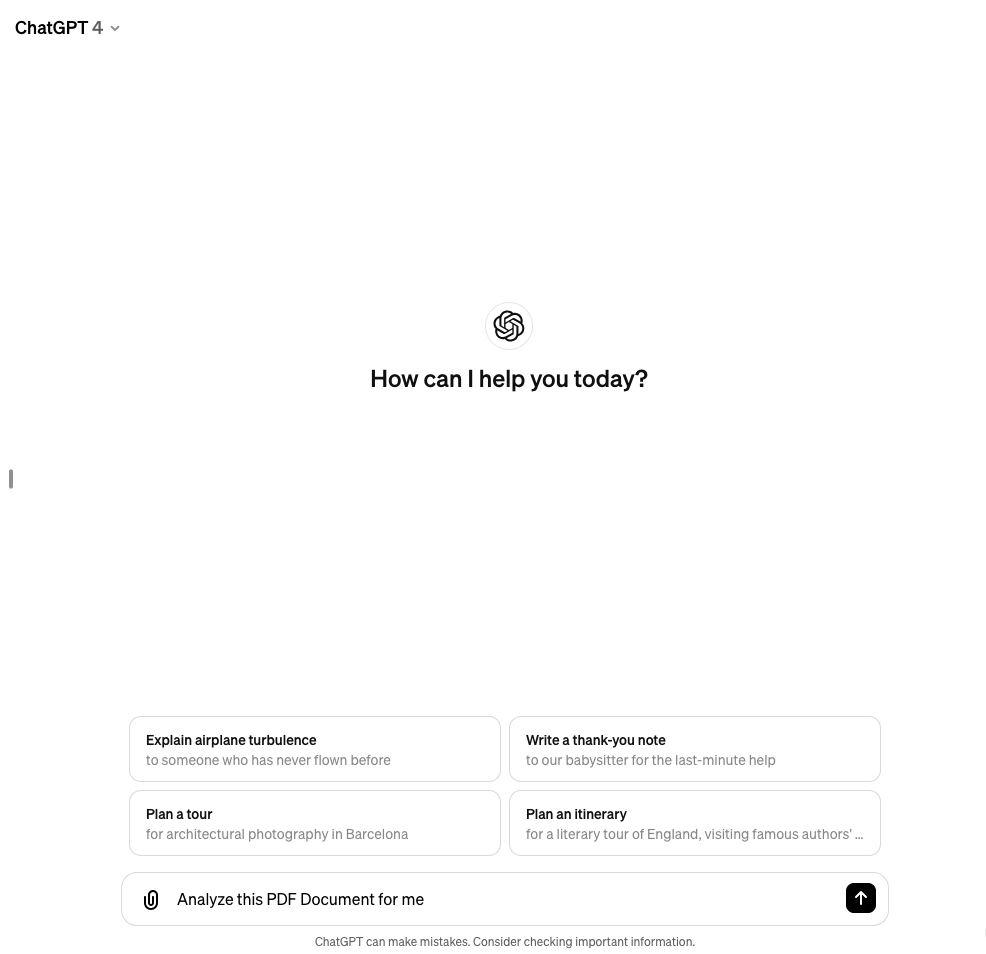
ChatGPT , developed by OpenAI , is an essential tool for academic research. This language model is specifically designed for generating text, making it a valuable assistant for scholars and researchers.
The Power of Incremental Prompting
The key feature of ChatGPT that resonates with academia is its incremental prompting feature. Incremental prompting allows researchers to create detailed outlines for their journal articles or research papers. With this feature, you can provide the model with a series of related prompts one by one, and it will respond accordingly. This step-by-step approach leads to more coherent and detailed responses.
This capability not only simplifies the writing process but also makes it more structured and organized. It's like having an intelligent assistant that helps you arrange your thoughts and ideas into well-defined sections or chapters of the research document.
Versatility in Document Handling
One of the strengths of ChatGPT lies in its ability to work with different types of documents. It can browse the web, interact with files (including PDFs and other formats), making it convenient for users to access various sources during their research work.
This ability is particularly useful when dealing with large PDF files or complex documents where finding relevant information can be challenging. With ChatGPT, you can simply upload your file, ask specific questions about its content, and get precise answers instead of having to read through the entire document.
Case Study: Stanford University
Let's look at an example from Stanford University where ChatGPT was tested by students and professors . They used this AI tool as part of their academic writing process - from generating ideas to creating outlines for journal articles.
- In one instance, a PhD student working on a paper about AI ethics used ChatGPT to generate an outline for his document. He started with a broad prompt on AI ethics which yielded a general response from the model. He then gradually added more specific prompts, leading the model to generate a detailed and organized outline of the paper.
- In another case, a professor at Stanford used ChatGPT for preparing his lectures. He would prompt the model with a topic he planned to teach and based on the generated responses, he would create an outline for his lecture.
These real-life examples demonstrate the effectiveness of ChatGPT in academic writing. It's not just about easing the writing process but also enhancing it by providing a new way to structure your thoughts, ideas, and findings. As Bill Gates predicted, AI-driven software like ChatGPT is indeed revolutionizing education and academia.
From these examples and many more, it is clear that using an AI tool like ChatGPT can significantly improve the academic writing process. By providing structure to your work, generating ideas, and making information retrieval easier, such tools are proving to be game-changers in academic research.
3. Consensus

Consensus is a specialized search engine designed for academics, leveraging advanced Artificial Intelligence to provide accurate and concise summaries of peer-reviewed articles.
How Consensus Works
The power of Consensus lies in its AI algorithms, which analyze the content of papers to extract key information. This makes it more than just a regular search engine - it's a tool that can distill complex academic papers into easy-to-understand summaries.
Why Choose Consensus?
When it comes to finding relevant sources for your research, Consensus offers several advantages over traditional search engines:
Features of Consensus
- Summarized Evidence : Consensus provides summarized evidence from peer-reviewed literature, allowing you to quickly grasp the main points of a paper without reading the entire document.
- AI-Powered Search Engine : Unlike keyword-based search engines, Consensus understands the context and relevance of your query, delivering more precise results.
- User-Friendly Interface : With its simple yet efficient interface, Consensus makes it easy for you to navigate the platform and find what you need.
Benefits of Using Consensus
Using Consensus during the literature review stage of your academic research projects can bring several benefits:
- Efficient Information Retrieval : By providing concise summaries of peer-reviewed articles, Consensus helps you save time during the literature review process.
- Access to Quality Sources : As Consensus focuses on peer-reviewed literature, using it ensures that you're accessing reliable and academically sound sources.
- Time-Saving : Thanks to its AI-powered search engine, Consensus delivers relevant results quickly, allowing you to work more efficiently.
- Improved Understanding : The summarized evidence provided by Consensus can enhance your understanding of the topic at hand, making your research more comprehensive.
- Ease of Use : With its user-friendly interface and straightforward functionality, Consensus is a tool that seamlessly integrates into your academic writing workflow.
Consensus serves as an example of how AI can transform the way academic research is conducted. As we embrace the digital age, tools like Consensus are becoming essential for researchers in various fields. By harnessing the power of AI, Consensus paves the way for more efficient and effective academic research, allowing you to focus on what truly matters - creating impactful knowledge.
4. Elicit.org
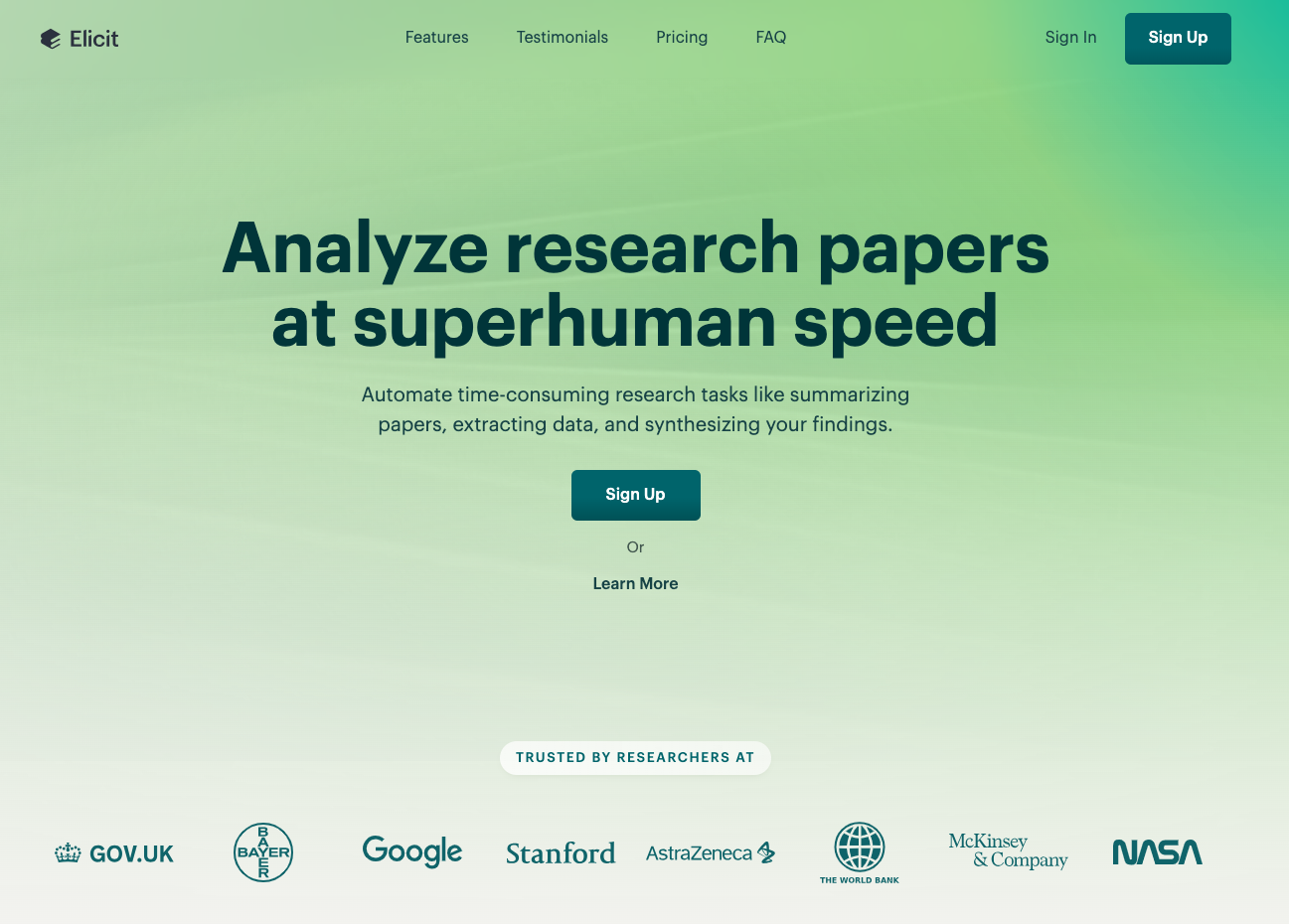
Elicit.org is an AI-powered tool designed to streamline the research process by assisting in conducting comprehensive literature reviews and extracting relevant data from various sources. It is one of the top AI writing tools for academic research that has been embraced by researchers worldwide.
How Elicit.org Works
The power of Elicit lies in its sophisticated algorithms that analyze the content of documents. These algorithms are capable of identifying key concepts, relationships, and findings within a sea of information. This feature allows users to gain valuable insights for their own research projects in a fraction of the time it would take manually.
Key Features of Elicit.org
Identifying key concepts.
Elicit's AI is programmed to identify and highlight key concepts within a text. This gives you an immediate grasp of the main ideas within a document without having to read it in its entirety.
Establishing Relationships
Another significant feature of Elicit.org is its ability to establish relationships between different documents or concepts. This helps to build a comprehensive understanding of the subject matter.
Extracting Findings
Finally, it can extract critical findings from research papers, providing you with specific data points that may be relevant to your research.
The practical applications of these features are numerous. For instance, if you were conducting a literature review on climate change, Elicit.org could:
- Analyze hundreds of papers
- Identify the key concepts such as 'global warming', 'carbon emissions', 'deforestation', etc.
- Establish relationships between these concepts across different papers
- Extract critical data points like specific carbon emission figures.

Try Elicit.org for Your Research
Elicit.org has truly revolutionized the way researchers approach literature review and data extraction, making it a crucial AI tool for academic research. By integrating Elicit.org into your research workflow, you can leverage its AI capabilities to make your research process more efficient and effective.
5. Scite.ai
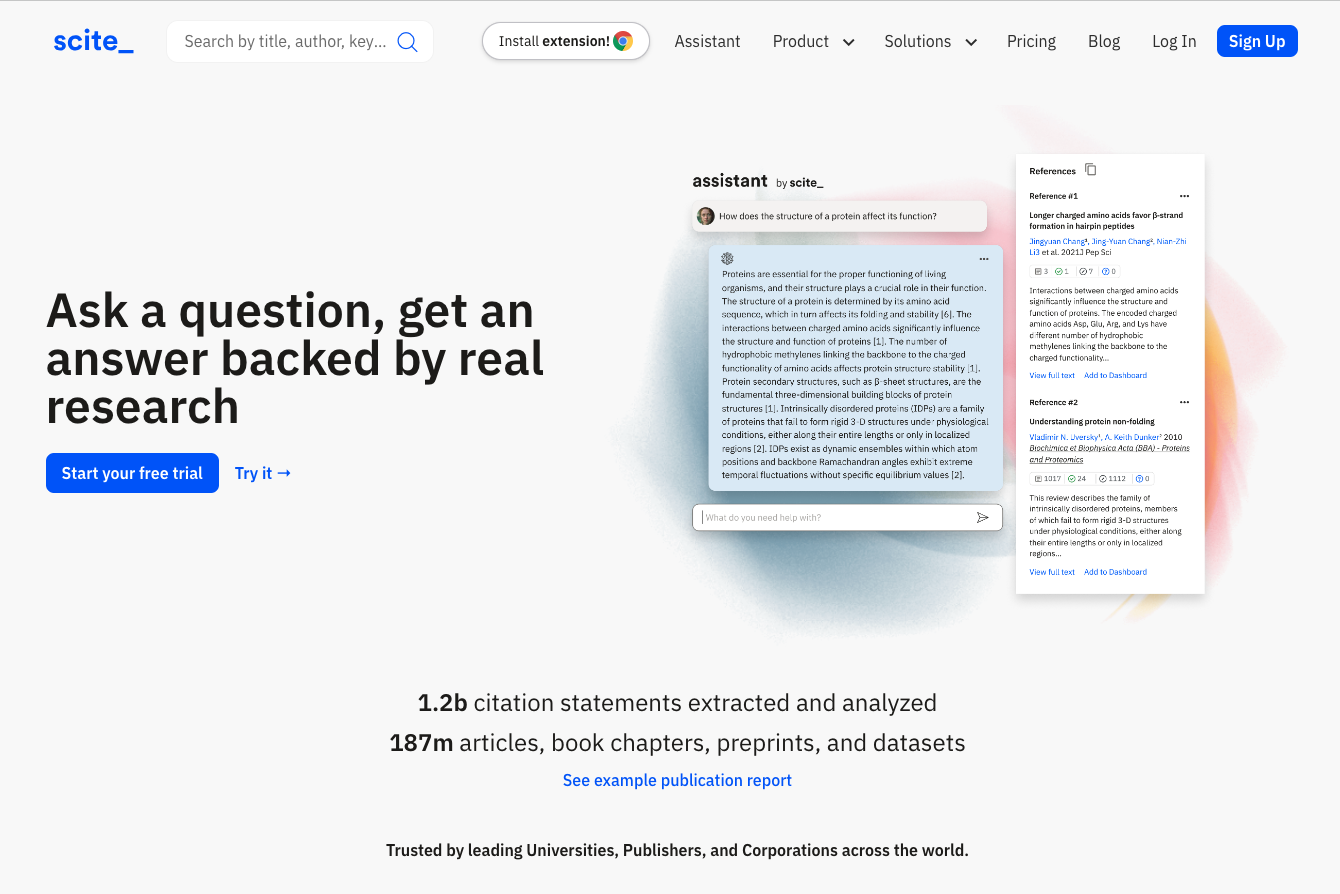
Scite.ai , a unique platform that stands out in its approach to enhancing the credibility of research.
Beyond Traditional Citation Tools
Scite.ai is not just a citation tool; it uses artificial intelligence to analyze citation patterns in scholarly articles meticulously. This insightful analysis offers users contextual information about how particular studies have been cited by other researchers. It's like having an intelligent assistant who can tell you not just who is citing your work, but also how and why they are citing it.
How Does Scite.ai Enhance Research Validation?
The primary focus of Scite.ai is on research validation. This is where the tool truly shines. In simple terms, Scite.ai helps scholars assess the impact and credibility of published papers more effectively. Its underlying AI technology sifts through the multitude of citations associated with any article, cutting through the noise to provide meaningful insights. It uses these insights to determine whether a paper has been positively or negatively received, based on the context within which it has been cited in subsequent works.
But how does this work?
Scite.ai takes each citation and breaks it down into three categories:
- Supporting : The citing work provides evidence in favor of the assertions made in the original paper.
- Mentioning : The citing work refers to the original paper but does not explicitly support or dispute its content.
- Disputing : The citing work challenges or contradicts the findings or claims made in the original paper.
This categorization gives a clear snapshot of how other researchers view your study, which can be invaluable when assessing its impact and validity.
Benefits of Using Scite.ai for Academic Writing
Incorporating Scite.ai into your academic writing process comes with several potential benefits:
- Strengthening Arguments : Knowing how others perceive your references can help you build stronger arguments by choosing sources that have been widely accepted and supported.
- Supporting Claims : Scite.ai gives you an edge by letting you back up your claims with references that have been positively cited in other works.
- Enhancing Credibility : A paper that includes well-regarded sources increases its credibility in the academic community, potentially leading to more citations and higher impact.
Understanding the Context of Citations
Scite.ai's approach to assessing the impact of papers does not stop at categorization. It also provides a 'citation statement', which is a brief excerpt from the citing text. This allows users to understand the context and rationale of the citation without having to read through the entire citing article.
For example, if a researcher is writing about climate change and selects a paper as a reference, Scite.ai not only shows how many times the paper has been cited but also provides an overview of whether these citations are supporting, mentioning or disputing it. This information paints a more in-depth and detailed picture of how the chosen paper has been received by the scientific community.
The Power of Scite.ai for Scholars
In essence, Scite.ai is a powerful ally for any scholar. It provides unique insights into citation patterns, enabling users to make informed decisions about which sources to use and how to present their arguments effectively. The ability to validate research, bolster arguments, and enhance credibility makes Scite.ai an indispensable tool in today's digital age where academic integrity is paramount.
6. Research Rabbit
Research Rabbit is an innovative AI tool designed to assist with exploring and understanding scientific literature. It's a web application that helps researchers navigate through scientific literature, enabling them to create organized collections of pertinent papers.
Utilizing advanced algorithms, Research Rabbit analyzes both content and metadata of articles. The analysis allows the application to suggest related works, providing researchers with new perspectives and connections they might have overlooked.
How Does Research Rabbit Work?
Research Rabbit employs AI algorithms to scrutinize the content and metadata of articles. This process includes evaluating keywords, abstracts, author affiliations, citation networks, and even figures and tables within the paper. This comprehensive approach provides a deeper understanding of the article's context and relevance.
The system then recommends other relevant articles based on its analysis. This feature aids researchers in uncovering new links between studies and gaining interdisciplinary insights.
Benefits of Using Research Rabbit
The use of Research Rabbit can bring multiple benefits to both novice and experienced researchers:
- Keeping Up With Latest Developments : The rapid pace at which new research papers are published makes it challenging for researchers to stay updated. Research Rabbit addresses this issue by providing recommendations based on recent publications related to their chosen topics.
- Identifying Research Gaps : By reviewing related papers suggested by Research Rabbit, researchers can identify gaps in current knowledge and thereby find opportunities for novel research.
- Improving Efficiency : Instead of manually searching for relevant studies, researchers can rely on Research Rabbit's AI-powered suggestions, saving valuable time.
- Enhancing Understanding : By presenting different perspectives on a topic through related works, Research Rabbit fosters a more comprehensive understanding of the subject matter.
To illustrate this process, consider a researcher studying climate change's impact on agriculture. After inputting their research papers into Research Rabbit, the application might suggest articles about innovative farming practices in response to climate change or economic studies on how climate change affects agricultural markets. These suggestions can lead the researcher to consider new angles for their work, promoting a more nuanced and complete analysis.
Research Rabbit represents a significant advancement in AI writing tools for academic research. Its ability to analyze literature and suggest related works enables researchers to delve deeper into their topics, discover new perspectives, and stay abreast of the latest developments in their field. By harnessing this technology, researchers can enhance the depth and breadth of their studies while improving their productivity.
7. Google Scholar
Google Scholar , a well-known platform for academic research, is an extensive online collection of scholarly literature across various fields. It has become an essential tool in the academic world because of its vast collection of research articles, conference papers, theses, books, and patents from professional societies, online repositories, universities, and other scholarly organizations.
Google Scholar uses advanced AI algorithms to rank documents based on their relevance, considering factors such as the full text of each document, where it was published, who authored it, and how frequently and recently it has been cited in other literature. As a result, researchers can access a wide range of scholarly content that might not be available through other search engines.
Finding Relevant Sources with Google Scholar
When doing academic research, the challenge often lies not in finding information but in finding relevant information. By using Google Scholar 's advanced search features effectively, you can overcome this challenge.
General Search
Simply enter your keywords into the search bar for a list of relevant resources.
Advanced Search
Click on the menu icon on the top left of the page and select "Advanced Search" for more specific queries. You can:
- Search for exact phrases
- Exclude certain words
- Search within specific publications or authors
Author Verification
If you're searching for articles from a particular author, make sure that they have verified their Google Scholar profile to avoid confusion with authors having similar names.
Tracking Citations: Measure Your Impact
One of the unique features of Google Scholar is its citation tracking capability. This feature allows researchers to measure the impact and influence of their work within the academic community.
This link under each result shows how many times an article has been cited by other papers indexed on Google Scholar . It's a helpful indicator of an article's influence or importance in a field.
Google Scholar Citations
This feature lets authors track citations to their articles. You can check who is citing your publications, graph citations over time, and compute several citation metrics.
Tips and Strategies: Maximizing Google Scholar's Effectiveness
The value derived from Google Scholar largely depends on how effectively you use its features. Here are some strategies to enhance your academic writing endeavors:
- Refine Your Search : Use boolean operators like AND, OR, NOT, "", and - to narrow or broaden your search.
- Personalized Updates : Set up alerts for new content that matches your specified criteria (such as author or keyword). This helps you stay updated with the latest research in your field of interest.
- Export Citations : Google Scholar allows you to export citations in various formats (like BibTeX, EndNote, RefMan, or RefWorks) which can be directly imported into your reference management software.
Google Scholar is considered one of the most powerful academic search engines available. Its comprehensive database coupled with advanced AI algorithms makes it an invaluable tool for academic research. By understanding its features and learning how to leverage them effectively, you can streamline your academic writing process and produce well-researched scholarly work.
Trinka is an advanced writing assistant powered by AI that aims to improve the quality of academic papers. It provides researchers with valuable feedback and suggestions to refine their writing style and eliminate grammatical errors.
How Does Trinka Help Improve Your Writing?
Trinka uses advanced algorithms to analyze your text thoroughly, focusing on three main areas:
1. Sentence Structure
Trinka examines each sentence in your paper for clarity, coherence, and conciseness. It suggests revisions to make your writing easier to understand.
2. Vocabulary Usage
The tool identifies complex or inappropriate words in your writing and suggests simpler alternatives.
3. Overall Coherence
Trinka evaluates the logical flow of ideas and arguments throughout your paper, highlighting areas that may need further explanation or reorganization.
By addressing these aspects, Trinka helps you create a well-written academic paper with a strong foundation.
"Trinka is more than just a grammar-checking tool. It is a smart companion that understands the nuances of academic writing and can assist you in producing high-quality papers.
The Power of AI Writing Tools for Academic Research
With the rapid advancements in technology, an important shift has taken place in the academic research arena. The emergence of AI writing tools for academic research has become a game-changer, improving both efficiency and quality in research efforts. These tools offer a wide range of capabilities that can help at every stage of the academic writing process.
Adapting to Technological Advancements
The world of academia is changing quickly. Researchers now need to keep up not only with developments in their own fields but also with broader technological trends that could affect their work. This includes embracing advancements like AI, which can greatly enhance research endeavors.
One example of this is Scite.ai . This platform uses AI to analyze citation patterns in scholarly articles, giving users contextual information about how a particular study has been cited by other researchers. This approach to research validation can help scholars better understand the impact and reliability of published papers. By using such tools, researchers can strengthen their arguments and support claims with trustworthy references, thereby improving the credibility of their work.
Experimenting with AI Tools
Innovation is key in academic research. That's why it's crucial for researchers to constantly explore and experiment with new methods and technologies that can enhance their work. This includes trying out various AI writing tools mentioned in this article.
For instance, you might want to consider using Research Rabbit for exploring scientific literature and creating organized collections of relevant papers. Its algorithms analyze the content and metadata of articles to suggest related works, enabling you to discover new connections and interdisciplinary perspectives. Such tools not only streamline your literature review process but also inspire new research directions.
The Future is Here
These AI writing tools are not just about keeping up with technological advancements; they are about embracing the future of academic research. As researchers, it's important for us to adapt and evolve alongside these changes, integrating technology into our workflows to improve efficiency and enhance the quality of our work.

Press ESC to close
Or check our popular categories....

Top 10 AI Tools For Academics: Level Up Your Research
If you aren’t using AI to augment your academic research in 2023, you are wasting a lot of time – time that you could free up from grunt work and invest in the more interesting stuff.
AI tools have proliferated since the launch of GPT 3 and beyond. The sudden and simultaneous rise of so many consumable AI-powered tools has quickly muddied the waters and made it tiresome if not impossible to get your hands on the right set of AI tools for researchers.
Fear not! I have hand-picked (I’ve had help, a lot of it, to be honest) 10 of the best AI tools for researchers. Go through the list, combine multiple tools, and create a customized stack of AI tools to help with your research process.
Top 10 AI tools for researchers
We’ll discuss tools powered by artificial intelligence that can augment your research work, save you a lot of time through the automation of certain tasks, and help you brainstorm new ideas avoid plagiarism, and streamline the research process.
1. PDFgear Copilot
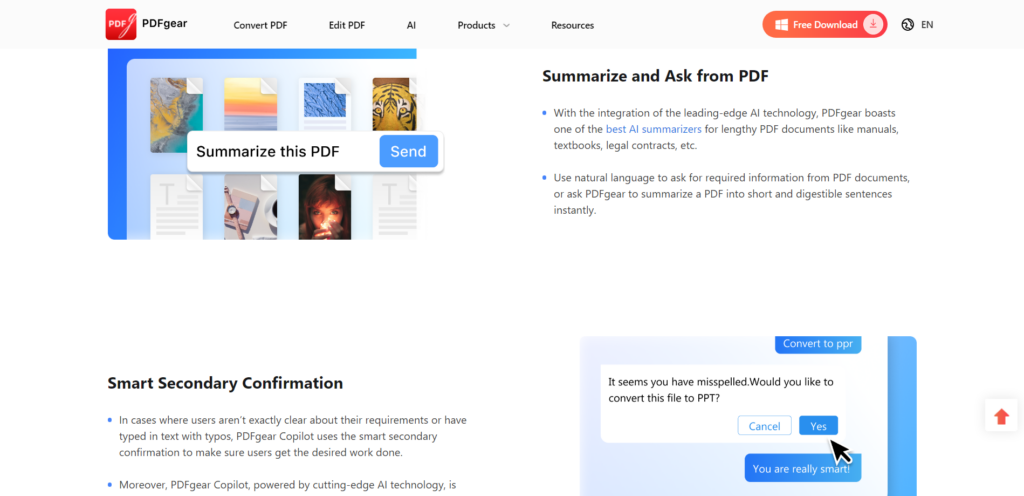
This PDF editor with a humble-looking website doesn’t even market itself properly as a top-class AI tool for researchers. It just is. PDFgear offers you some very simple functionalities that are going to save you a lot of time in different stages of your research activities.
It will let you upload PDF files and give you a summary of what’s inside the PDF . If you think it has missed something, ask. And it will find you the specific piece of information you were worried about. You can even ask PDFgear to compress a file, delete some pages, and perform other small-time edits via chat.
Now, let’s say you have created a paper and you want to check it for errors before submitting it. Run it through PDFgear. The AI copilot will catch your typos and spelling errors and save you from embarrassment.
PDFgear is free. It doesn’t matter if you want to summarize one file or 500 files. It’s free and instantaneous.
The only downside is that this tool is available for download only on Windows 10/11. Nonetheless, the website says the MacOS version will arrive soon.
2. Consensus

Consensus is useful for everyone and invaluable for researchers. It is an AI-powered search engine that takes questions in natural language and finds evidence-based answers from peer-reviewed research papers . Let that sink in.
While Google invests a lot in understanding the intent behind a search and providing the best answer, as a researcher you know how frustrating Google searches can be. You have to wade through an ocean of unverified content to reach evidence-based answers unless you are a master of keyword matching.
- Consensus helps you access information spread across 200 million peer-reviewed papers.
- They’ll cite the sources while answering your questions.
- Every answer is evidence-based
- The tool offers instant summaries and analyses with the help of GPT 4 and other powerful LLM
When it comes to using AI to augment research work, this is the real deal. You can use Consensus for research without paying a dime. The free edition will even let you create 3 summaries a month. For a price of $7.99 per month, you can generate unlimited summaries powered by GPT4.
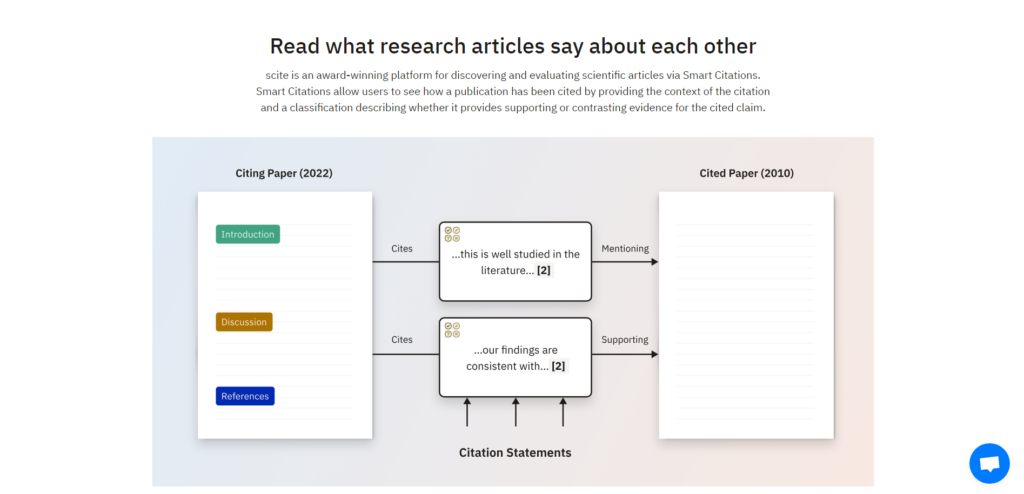
Scite, just like Consensus and PDFgear, has a very simple but elegant offering for researchers, students, and scholars. It tells you where an article has been cited and whether the citing article affirms or disputes the citation. So, as a researcher and a smart individual, you already know why this is incredible. I’ll talk about it a little anyway.
Scite helps you find how older research publications have been cited by newer research work through a feature called Smart Citation. This feature allows you to visualize a network of citations stemming from a single piece of work. It identifies the context of the citation and also classifies the citations as affirmative or negative.
You can take a glance at the visualization and instantly prioritize the publications that you want to go through . Scite is a real stress buster that can also open your eyes to new research angles.
These really are exciting times for researchers.
4. SciSpace

SciSpace is an AI-based tool that simplifies difficult concepts for you. So, if you are in a hurry and need to extract the gist of a sizable scientific paper , drop it at SciSpace and let the Copilot create a summary for you.
What if you have read an entire paper and cannot make sense of a specific section? Upload the file at SciSpace and highlight the section you need help with. The tool will break it down into digestible chunks and even take follow-up questions from you.
SciSpace also helps you with your literature reviews by finding related articles.
5. Wordvice AI
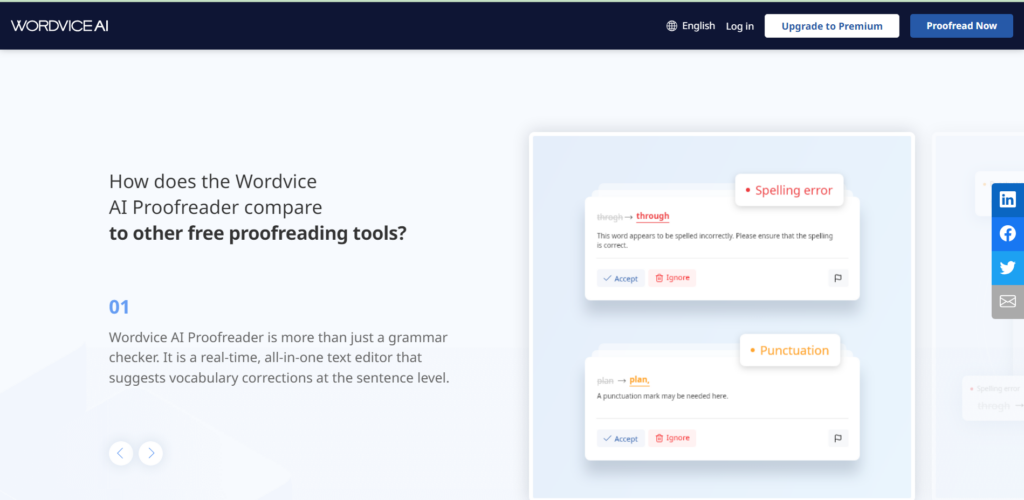
Wordvice AI is a well-rounded AI-powered writing assistant. It proofreads your work and checks your articles for spelling, punctuation, and style error. It helps you maintain a flow of writing by analyzing sentence structures and offering sentence-level suggestions.
It will help you choose better words and create better sentences, all while ensuring the correctness of spelling, grammar, and style.
Wordvice has solid use cases in academic research as well as in the corporate sector. It will help marketers write better copy and sales executives compose better emails.
If you look closely, most of the AI tools for research can actually be repurposed for other functionalities. Similarly, AI apps meant for business can be repurposed for research.
6. ChatGPT

ChatGPT is the OG generative AI chatbot. It took the world by storm and reached 1 million users in 5 days. It represents everything that’s cool about chatbots. But can you use it reliably for research?
The answer is no. ChatGPT is not considered a credible source for conducting research in any field. It comes up with false citations, offers misinformation, and isn’t up-to-date.
Then why is ChatGPT included in this list?
For two reasons:
- It is excellent at taking scattered information and forming comprehensive summaries.
- Its capability to adapt to a certain style of writing is almost magical.
So, as a smart individual what you can do is, get the information from credible sources, tie them up neatly with multiple prompts, and use ChatGPT to transform information into literature.
Also read: ChatGPT Wrappers: Compared [Use ChatGPT for Almost Free]
7. Research Rabbit
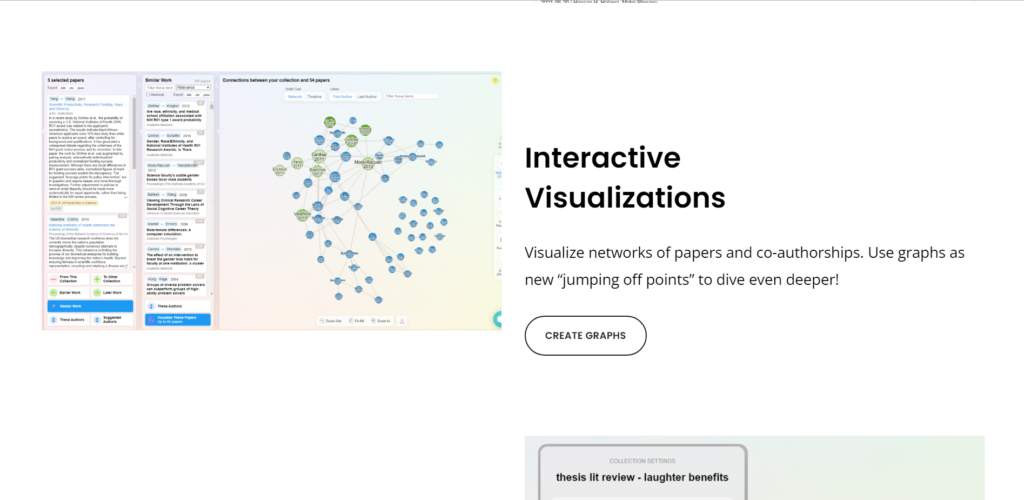
They call it “Spotify for Papers” and there is good reason behind it. ResearchRabbit allows you to create a collection of papers much like a Spotify playlist. Then, based on what you add to your collection and how you interact with papers, the platform creates recommendations. How neat is that? It’s like the AI-powered tool is reading your mind to help you read better.
Paper recommendations aside, ResearchRabbit also creates visualizations featuring your favorite articles showing how they’re cited. It gives you jumping-off points to delve deeper into an idea or to explore a different research angle.
You cannot call Research Rabbit a research assistant in its traditional sense. It is more like a friend that nudges you to try something new – relevant papers in this case.
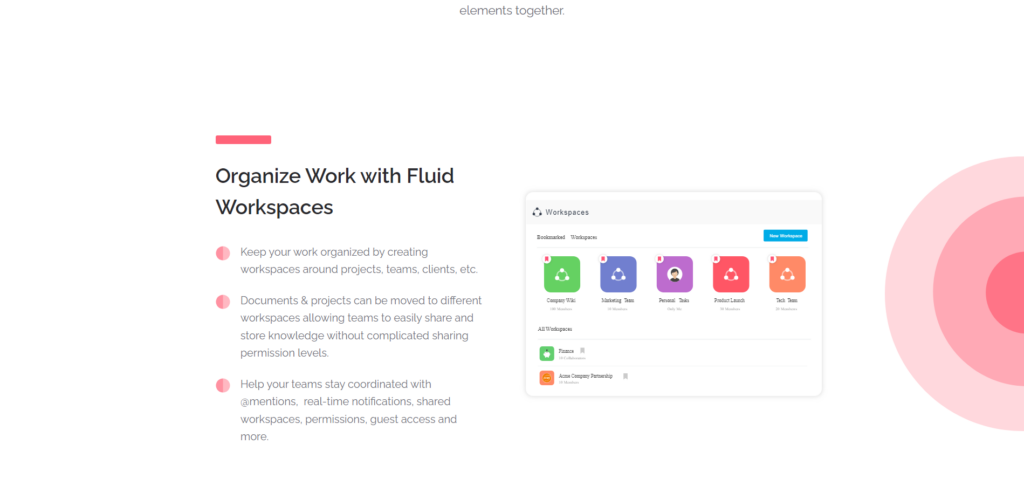
Here is another tool that’s never been marketed as an AI tool for researchers. In fact, Bit.ai is a fully-fledged document-sharing tool designed to cater to corporate needs. Nevertheless, it has certain features that researchers who like to collaborate can leverage.
This tool allows you to integrate a vast range of media items with your document . You can add infographics, create polls, and insert charts, and surveys. When you embed a link, Bit creates interactive visual cards visible to everyone sharing a document.
You can save all kinds of digital assets on the platform so that you do not have to search for content from different sources.
Now, imagine a scenario where you are part of a team of researchers who are collaborating on a few papers. You can organize and orchestrate the entire collaborative process with the help of Bit.ai.
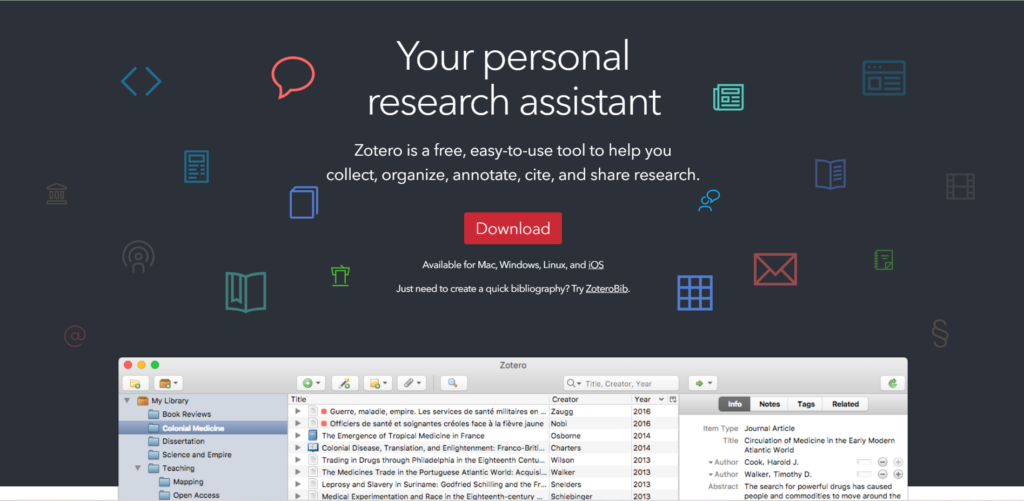
Zotero is a well-rounded AI research assistant. It helps researchers search better, organize better, and write better. Zotero analyzes your browsing patterns and senses when you are doing research. It then helps you find, sort, and save specific articles.
As you write the AI model recognizes the sources you are referencing and cites them for you following any of the 10000 citing procedures that it supports.
It creates a bibliography of all the resources used in your research paper. It synchronizes your data across devices to ensure access from anywhere at any time.
10. Semantic Scholar
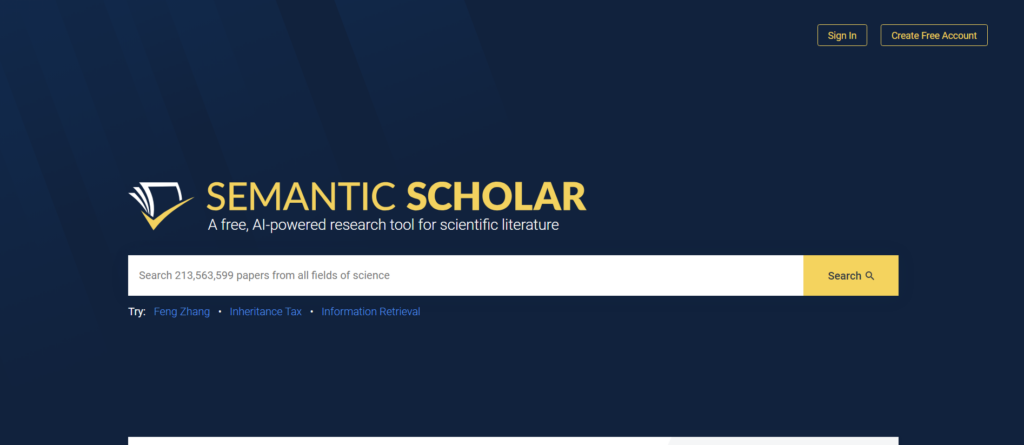
A search engine that helps you search from a database of 213 million scientific papers for free. It is somewhat similar to Consensus except for the fact that it is completely free. The platform is developed by Allen Institute for AI and it aims to make scientific literature accessible to all scholars .
As a researcher,
You can use Semantic Scholar to stay up-to-date with the latest scientific breakthroughs
Extract meaning and identify connections within papers
Find the highly influential citations at a glance
Create an online library to organize all your material
Get paper recommendations
AI tools for researchers that didn’t make the list
An AI research assistant that helps you find papers, extract meaning, and summarize articles.
A sentence structure checker and proofreader designed with scholastic compositions in mind.
Users can use this tool to converse with PDFs. They can get summaries, ask questions, and find insights into PDF files by uploading them.
iThenticate
A plagiarism-checker designed specifically for research works and scholastic literature.
Scholarcy is a platform driven by AI that helps you analyze scientific articles, extract key information, create lay summaries, and more.
Maintaining academic integrity while using AI tools for research
While using AI-powered research tools is hardly a matter of choice anymore, it is important to maintain the ethics and standards we associate with academic research. Despite the use of cutting-edge AI, your research procedures should be transparent.
Best practices for AI-powered academic research
- Mention the use of AI in your research and give credit to the developers.
- Discuss your use of AI tools and how their usage may have impacted the research outcome.
- Make sure that AI tools are used adhering to data privacy and informed consent requirements.
- Do not use AI-generated content in your research work without due attribution.
- Subject AI-assisted work to rigorous peer review.
FAQs about best AI tools for researchers
Does using ai tools for research raise any ethical concerns.
Yes, there can be concerns regarding data privacy, biased outcome, attribution of credit, and plagiarism. Researchers must be mindful of these issues while involving AI in their research strategy.
Can AI research assistants be used with AI expertise?
Most AI research assistants come with a conversational AI model that doesn’t require any expertise to use.
Is there an AI-based tool for historical research?
You can use general-purpose AI text analyzers to summarize large volumes of historical texts and create summaries. While there are AI-powered applications trained on historical data, they are mostly gamified, and cannot be directly used in historical research.
Categorized in:
Share Article:
Saumick Basu
Technical Writer & AI Researcher @ Foundr.AI
Saumick has been writing on technology for half a decade now. He loves talking about cybersecurity, AI, and enjoys diving deep into all disruptive tech. When not writing about tech, he writes songs and plays the drums.
Leave a Reply Cancel reply
Save my name, email, and website in this browser for the next time I comment.
Related Articles
10 best ai tools for recruiting in 2024, top 9 best ai tools for ecommerce in 2024, 9 best ai presentation maker tools [+1 bonus], 10 best ai tools for product managers.
10 Powerful AI Tools for Academic Research
- Serra Ardem

AI is no longer science fiction, but a powerful ally in the academic realm. With AI by their side, researchers can free themselves from the burden of tedious tasks, and push the boundaries of knowledge. However, they must use AI carefully and ethically, as these practices introduce new considerations regarding data integrity, bias mitigation, and the preservation of academic rigor.
In this blog, we will:
- Highlight the increasing role of AI in academic research
- List 10 best AI tools for academic research, with a focus on each one’s strengths
- Share 5 best practices on how to use AI tools for academic research
Let’s dig in…
The Role of AI in Academic Research
AI tools for academic research hold immense potential, as they can analyze massive datasets and identify complex patterns. These tools can assist in generating new research questions and hypotheses, navigate mountains of academic literature to find relevant information, and automate tedious tasks like data entry.

Let’s take a look at the benefits AI tools offer for academic research:
- Supercharged literature reviews: AI can sift through vast amounts of academic literature, and pinpoint relevant studies with far greater speed and accuracy than manual searches.
- Accelerated data analysis: AI tools can rapidly analyze large datasets and uncover intricate insights that might otherwise be overlooked, or time-consuming to identify manually.
- Enhanced research quality: Helping with grammar checking, citation formatting, and data visualization, AI tools can lead to a more polished and impactful final product.
- Automation of repetitive tasks: By automating routine tasks, AI can save researchers time and effort, allowing them to focus on more intellectually demanding tasks of their research.
- Predictive modeling and forecasting: AI algorithms can develop predictive models and forecasts, aiding researchers in making informed decisions and projections in various fields.
- Cross-disciplinary collaboration: AI fosters collaboration between researchers from different disciplines by facilitating communication through shared data analysis and interpretation.
Now let’s move on to our list of 10 powerful AI tools for academic research, which you can refer to for a streamlined, refined workflow. From formulating research questions to organizing findings, these tools can offer solutions for every step of your research.
1. HyperWrite
For: hypothesis generation
HyperWrite’s Research Hypothesis Generator is perfect for students and academic researchers who want to formulate clear and concise hypotheses. All you have to do is enter your research topic and objectives into the provided fields, and then the tool will let its AI generate a testable hypothesis. You can review the generated hypothesis, make any necessary edits, and use it to guide your research process.
Pricing: You can have a limited free trial, but need to choose at least the Premium Plan for additional access. See more on pricing here .
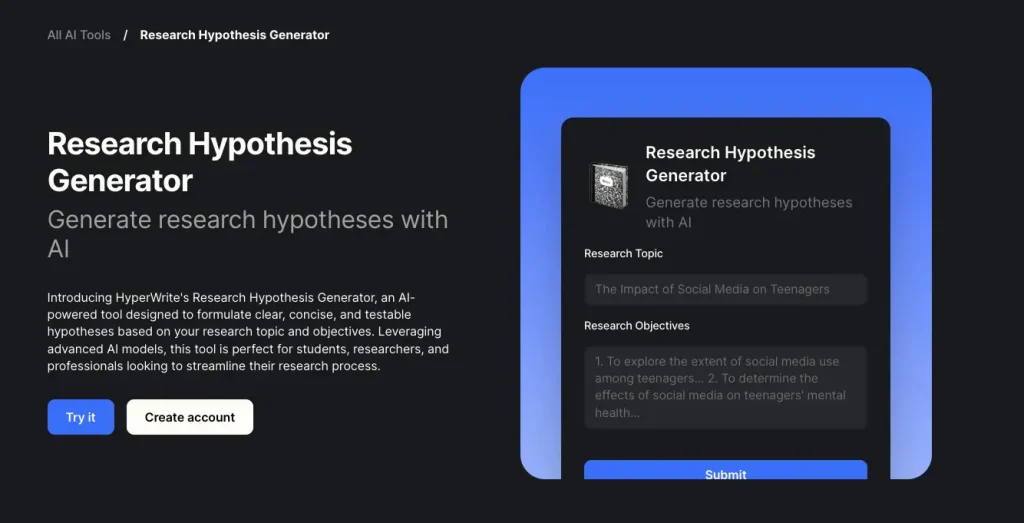
2. Semantic Scholar
For: literature review and management
With over 200 million academic papers sourced, Semantic Scholar is one of the best AI tools for literature review. Mainly, it helps researchers to understand a paper at a glance. You can scan papers faster with the TLDRs (Too Long; Didn’t Read), or generate your own questions about the paper for the AI to answer. You can also organize papers in your own library, and get AI-powered paper recommendations for further research.
Pricing: free

For: summarizing papers
Apparently, Elicit is a huge booster as its users save up to 5 hours per week. With a database of 125 million papers, the tool will enable you to get one-sentence, abstract AI summaries, and extract details from a paper into an organized table. You can also find common themes and concepts across many papers. Keep in mind that Elicit works best with empirical domains that involve experiments and concrete results, like biomedicine and machine learning.
Pricing: Free plan offers 5,000 credits one time. See more on pricing here .
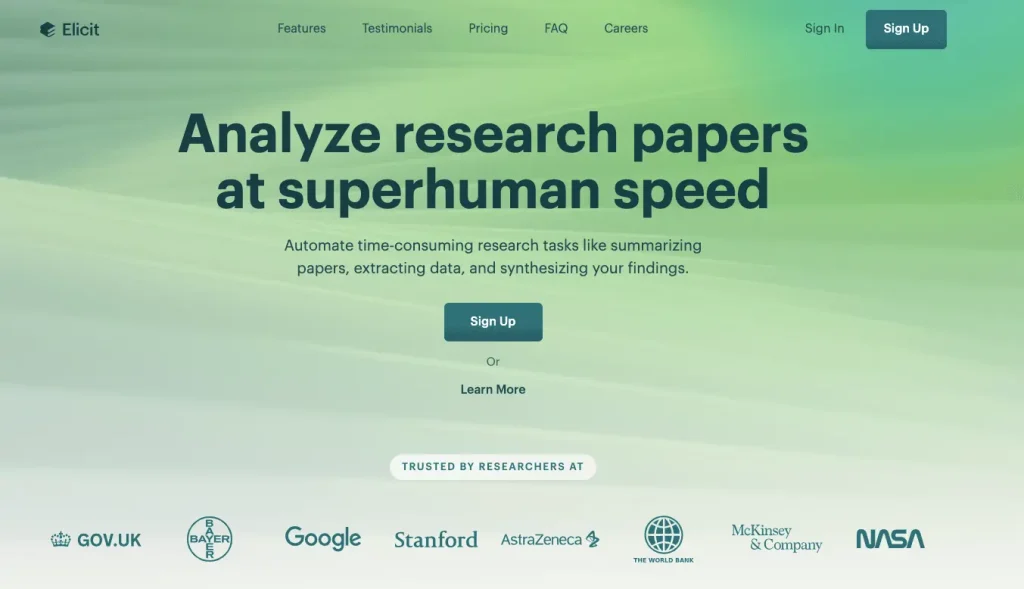
For: transcribing interviews
Supporting 125+ languages, Maestra’s interview transcription software will save you from the tedious task of manual transcription so you can dedicate more time to analyzing and interpreting your research data. Just upload your audio or video file to the tool, select the audio language, and click “Submit”. Maestra will convert your interview into text instantly, and with very high accuracy. You can always use the tool’s built-in text editor to make changes, and Maestra Teams to collaborate with fellow researchers on the transcript.
Pricing: With the “Pay As You Go” plan, you can pay for the amount of work done. See more on pricing here .
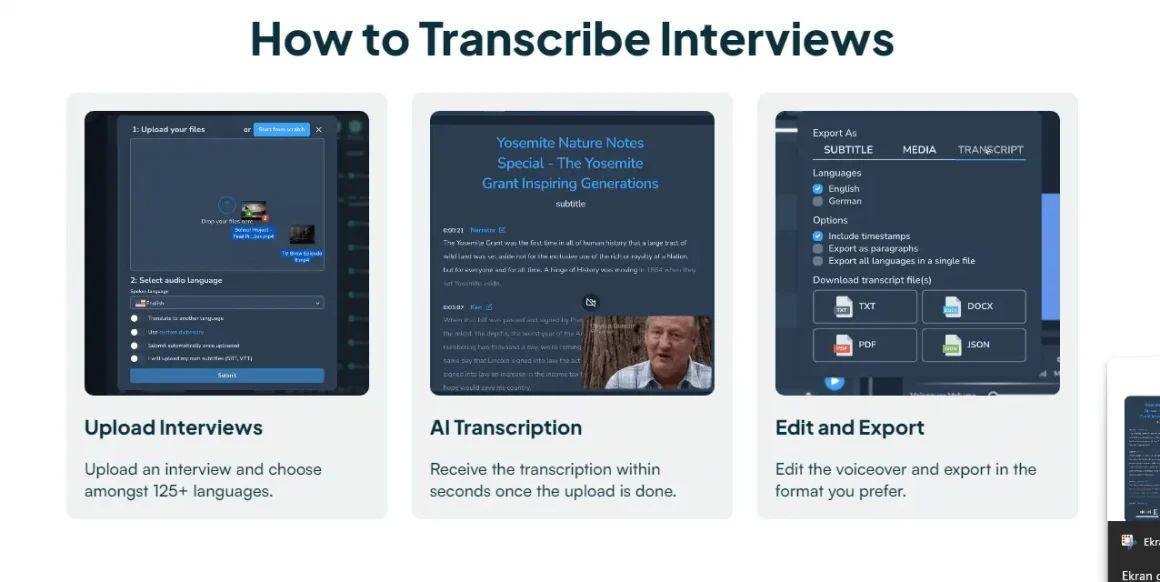
5. ATLAS.ti
For: qualitative data analysis
Whether you’re working with interview transcripts, focus group discussions, or open-ended surveys, ATLAS.ti provides a set of tools to help you extract meaningful insights from your data. You can analyze texts to uncover hidden patterns embedded in responses, or create a visualization of terms that appear most often in your research. Plus, features like sentiment analysis can identify emotional undercurrents within your data.
Pricing: Offers a variety of licenses for different purposes. See more on pricing here .
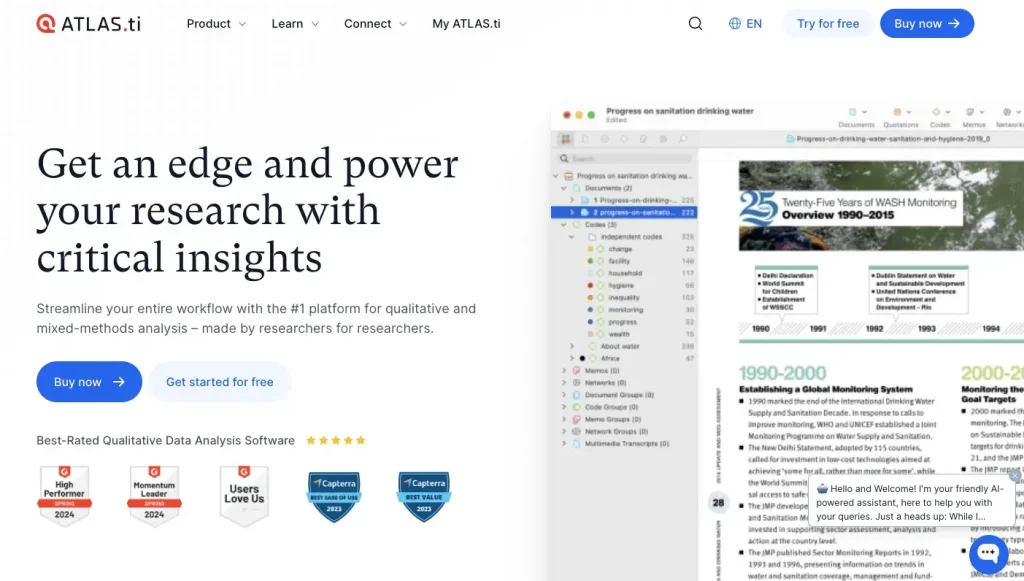
6. Power BI
For: quantitative data analysis
Microsoft’s Power BI offers AI Insights to consolidate data from various sources, analyze trends, and create interactive dashboards. One feature is “Natural Language Query”, where you can directly type your question and get quick insights about your data. Two other important features are “Anomaly Detection”, which can detect unexpected patterns, and “Decomposition Tree”, which can be utilized for root cause analysis.
Pricing: Included in a free account for Microsoft Fabric Preview. See more on pricing here .
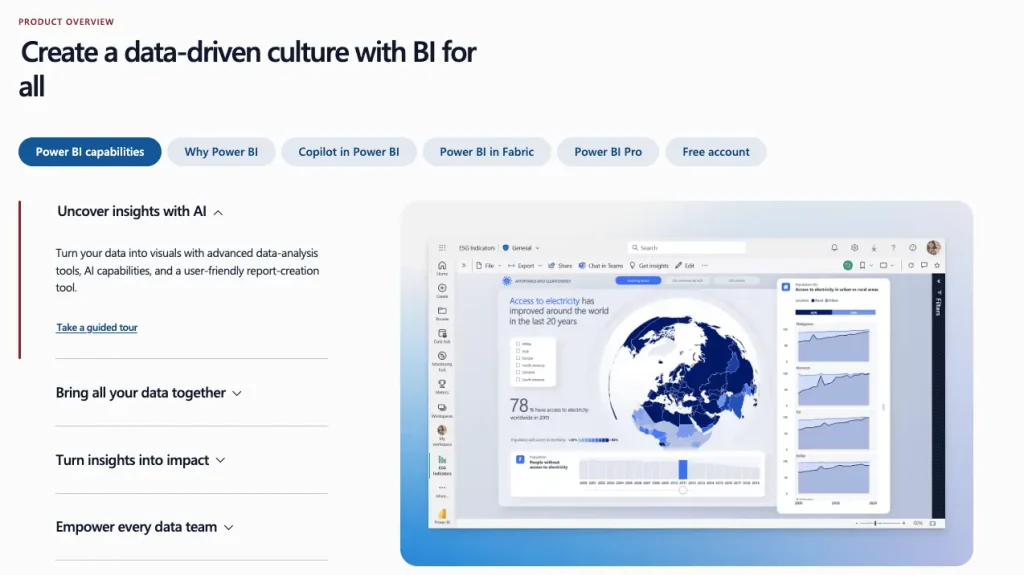
7. Paperpal
For: writing research papers
As a popular AI writing assistant for academic papers, Paperpal is trained and built on 20+ years of scholarly knowledge. You can generate outlines, titles, abstracts, and keywords to kickstart your writing and structure your research effectively. With its ability to understand academic context, the tool can also come up with subject-specific language suggestions, and trim your paper to meet journal limits.
Pricing: Free plan offers 5 uses of AI features per day. See more on pricing here .
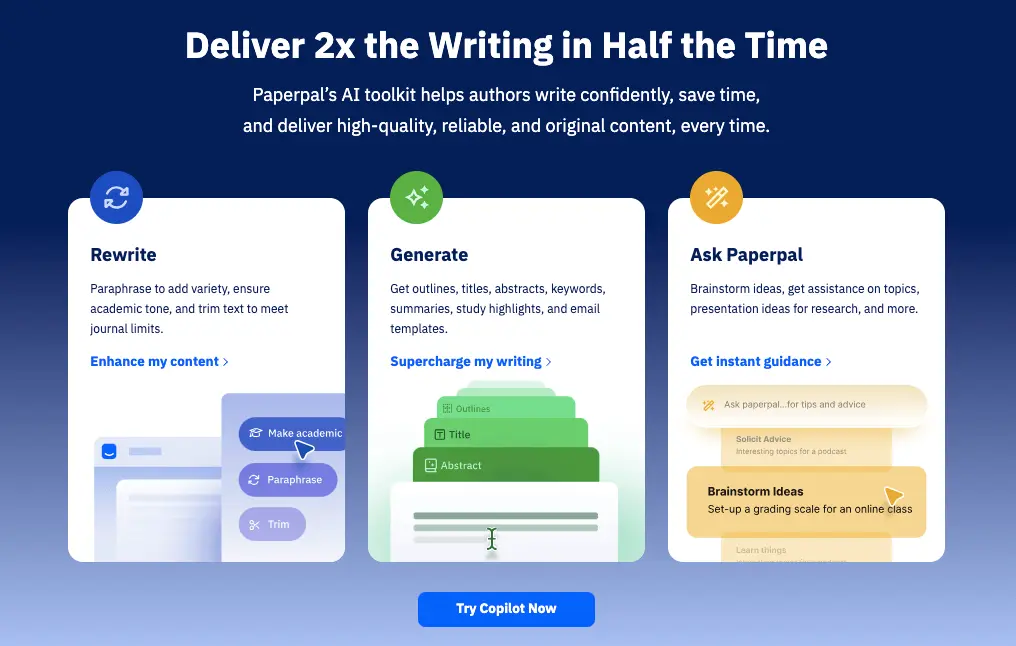
For: proofreading
With Scribbr’s AI Proofreader by your side, you can make your academic writing more clear and easy to read. The tool will first scan your document to catch mistakes. Then it will fix grammatical, spelling and punctuation errors while also suggesting fluency corrections. It is really easy to use (you can apply or reject corrections with 1-click), and works directly in a DOCX file.
Pricing: The free version gives a report of your issues but does not correct them. See more on pricing here .

9. Quillbot
For: detecting AI-generated content
Want to make sure your research paper does not include AI-generated content? Quillbot’s AI Detector can identify certain indicators like repetitive words, awkward phrases, and an unnatural flow. It’ll then show a percentage representing the amount of AI-generated content within your text. The tool has a very user-friendly interface, and you can have an unlimited number of checks.
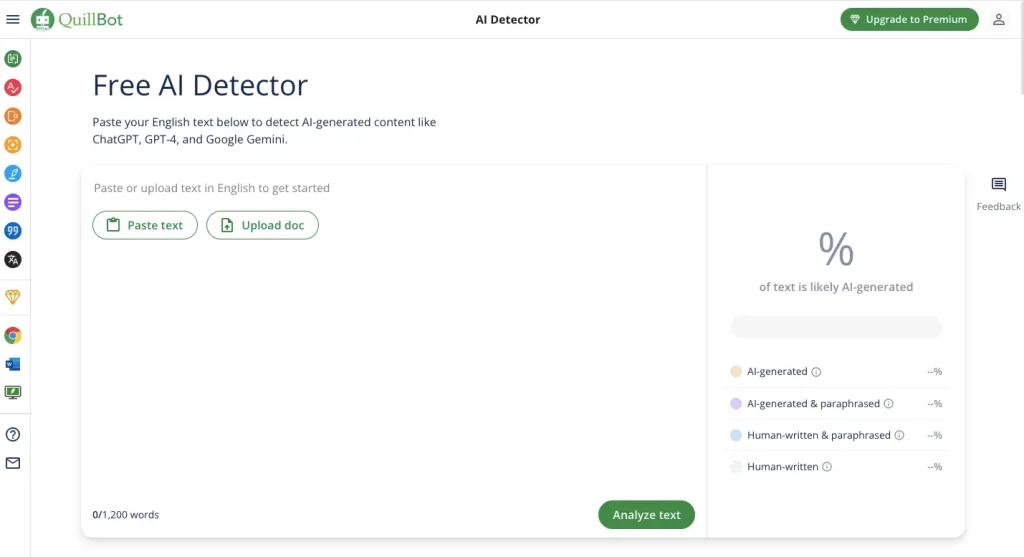
10. Lateral
For: organizing documents
Lateral will help you keep everything in one place and easily find what you’re looking for.
With auto-generated tables, you can keep track of all your findings and never lose a reference. Plus, Lateral uses its own machine learning technology (LIP API) to make content suggestions. With its “AI-Powered Concepts” feature, you can name a Concept, and the tool will recommend relevant text across all your papers.
Pricing: Free version offers 500 Page Credits one-time. See more on pricing here .
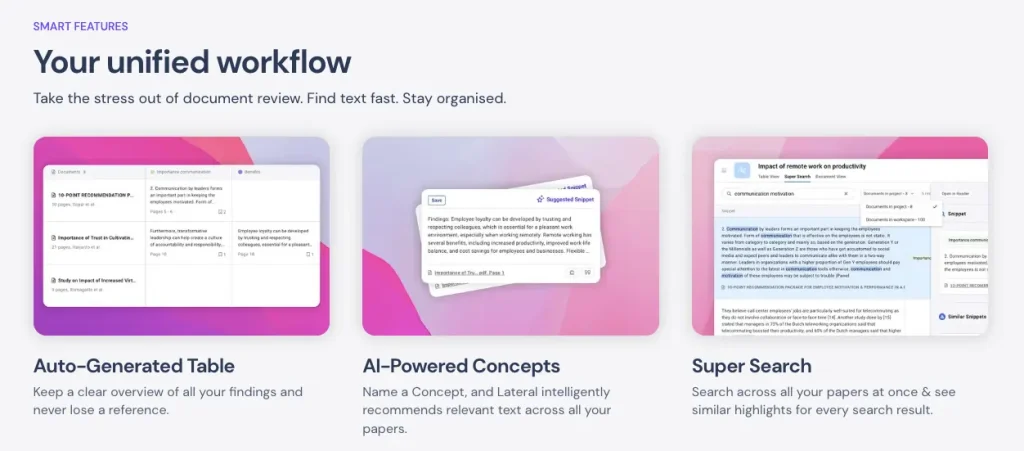
How to Use AI Tools for Research: 5 Best Practices
Before we conclude our blog, we want to list 5 best practices to adopt when using AI tools for academic research. They will ensure you’re getting the most out of AI technology in your academic pursuits while maintaining ethical standards in your work.
- Always remember that AI is an enhancer, not a replacement. While it can excel at tasks like literature review and data analysis, it cannot replicate the critical thinking and creativity that define strong research. Researchers should leverage AI for repetitive tasks, but dedicate their own expertise to interpret results and draw conclusions.
- Verify results. Don’t take AI for granted. Yes, it can be incredibly efficient, but results still require validation to prevent misleading or inaccurate results. Review them thoroughly to ensure they align with your research goals and existing knowledge in the field.
- Guard yourself against bias. AI tools for academic research are trained on existing data, which can contain social biases. You must critically evaluate the underlying assumptions used by the AI model, and ask if they are valid or relevant to your research question. You can also minimize bias by incorporating data from various sources that represent diverse perspectives and demographics.
- Embrace open science. Sharing your AI workflow and findings can inspire others, leading to innovative applications of AI tools. Open science also promotes responsible AI development in research, as it fosters transparency and collaboration among scholars.
- Stay informed about the developments in the field. AI tools for academic research are constantly evolving, and your work can benefit from the recent advancements. You can follow numerous blogs and newsletters in the area ( The Rundown AI is a great one) , join online communities, or participate in workshops and training programs. Moreover, you can connect with AI researchers whose work aligns with your research interests.

Frequently Asked Questions
Is chatgpt good for academic research.
ChatGPT can be a valuable tool for supporting your academic research, but it has limitations. You can use it for brainstorming and idea generation, identifying relevant resources, or drafting text. However, ChatGPT can’t guarantee the information it provides is entirely accurate or unbiased. In short, you can use it as a starting point, but never rely solely on its output.
Can I use AI for my thesis?
Yes, but it shouldn’t replace your own work. It can help you identify research gaps, formulate a strong thesis statement, and synthesize existing knowledge to support your argument. You can always reach out to your advisor and discuss how you plan to use AI tools for academic research .
Can AI write review articles?
AI can analyze vast amounts of information and summarize research papers much faster than humans, which can be a big time-saver in the literature review stage. Yet it can struggle with critical thinking and adding its own analysis to the review. Plus, AI-generated text can lack the originality and unique voice that a human writer brings to a review.
Can professors detect AI writing?
Yes, they can detect AI writing in several ways. Software programs like Turnitin’s AI Writing Detection can analyze text for signs of AI generation. Furthermore, experienced professors who have read many student papers can often develop a gut feeling about whether a paper was written by a human or machine. However, highly sophisticated AI may be harder to detect than more basic versions.
Can I do a PhD in artificial intelligence?
Yes, you can pursue a PhD in artificial intelligence or a related field such as computer science, machine learning, or data science. Many universities worldwide offer programs where you can delve deep into specific areas like natural language processing, computer vision, and AI ethics. Overall, pursuing a PhD in AI can lead to exciting opportunities in academia, industry research labs, and tech companies.
This blog shared 10 powerful AI tools for academic research, and highlighted each tool’s specific function and strengths. It also explained the increasing role of AI in academia, and listed 5 best practices on how to adopt AI research tools ethically.
AI tools hold potential for even greater integration and impact on research. They are likely to become more interconnected, which can lead to groundbreaking discoveries at the intersection of seemingly disparate fields. Yet, as AI becomes more powerful, ethical concerns like bias and fairness will need to be addressed. In short, AI tools for academic research should be utilized carefully, with a keen awareness of their capabilities and limitations.

About Serra Ardem
Serra Ardem is a freelance writer and editor based in Istanbul. For the last 8 years, she has been collaborating with brands and businesses to tell their unique story and develop their verbal identity.
7 Best Free AI Tools For Research Paper Understanding
Remember that time you found an incredibly promising research paper, but it felt like it was written in another language? The complicated terms, the long, winding sentences.
it can make you want to give up before you even start. But imagine if you had a super-smart friend who could break it all down for you – explain the ideas in simpler terms, point out the most important parts, and even show you how it connects to other stuff you already know.
That’s basically what some amazing new tools out there can do! If your curious about this ai tools let me show you the list of the best free AI tools for research paper understanding.
SciSpace (formerly known as Scispace)
Connected papers, research rabbit, semantic scholar, explainpaper, tldr papers, faq: free ai tools for research paper understanding.
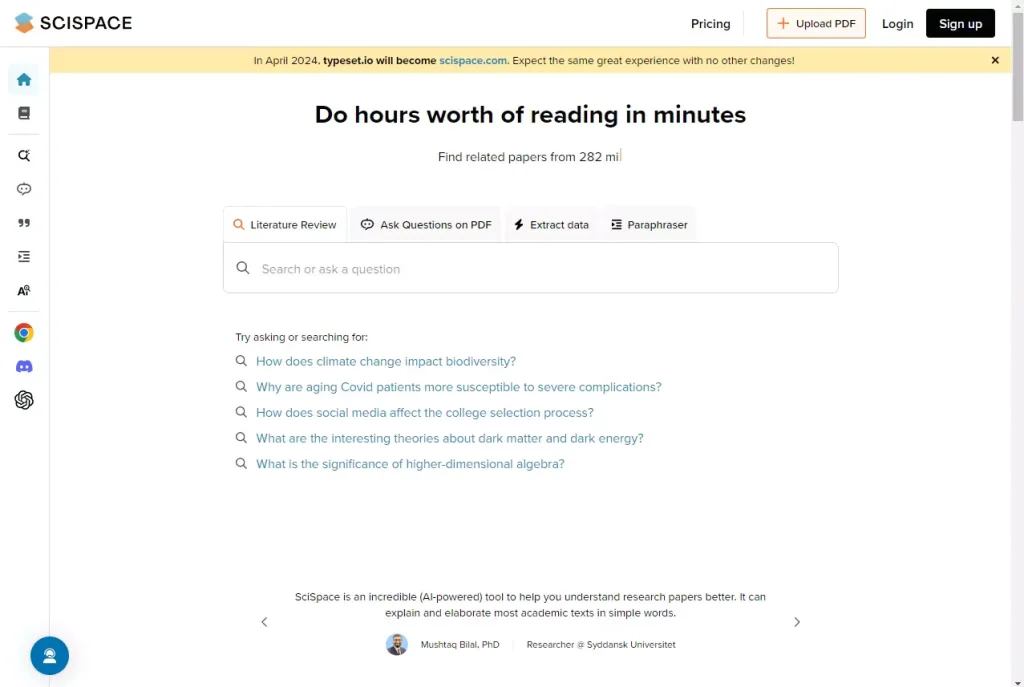
Summary: SciSpace is a powerful tool that simplifies the research process. It distills complex research papers into easy-to-understand summaries, provides clear explanations of key concepts, and helps you visualize connections within the broader field.
- Why It Stands Out: SciSpace uses its own machine learning models specifically trained on scientific text, making it highly accurate when analyzing research papers.
- Saves significant time understanding dense research
- Helps build a solid foundation in a specific field or topic
- Excellent for students and researchers in all disciplines
- May not be as effective with highly niche or emerging topics where AI training data is limited
- The free version has certain usage restriction.
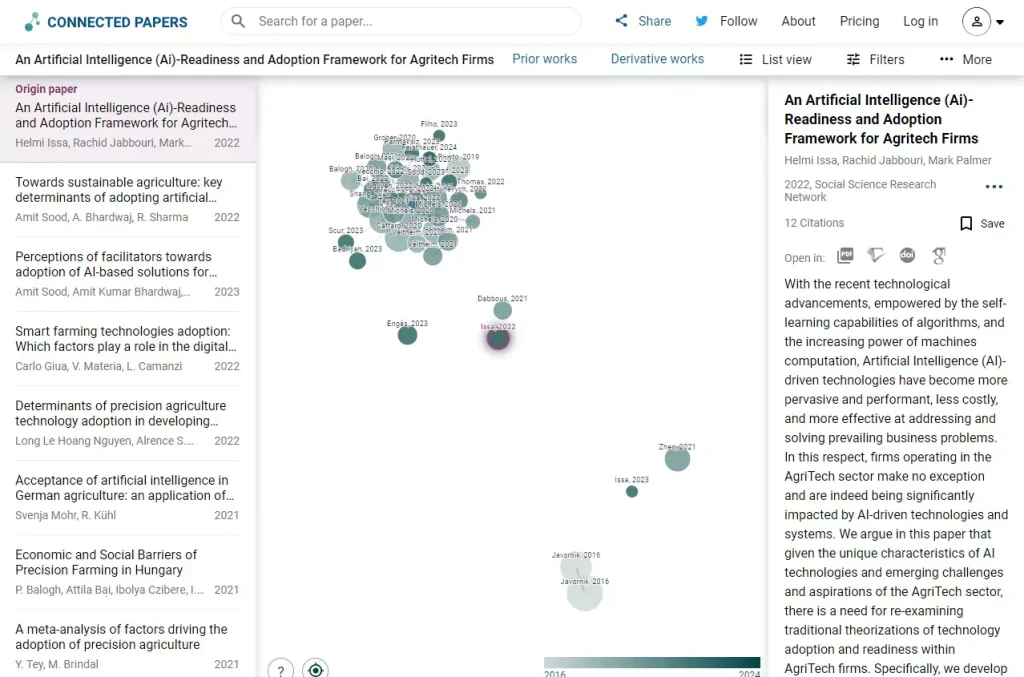
Summary: Connected Papers is a visual tool that reveals connections between research papers. It helps you discover relevant research, identify seminal works in your field, and explore how a paper relates to a broader body of knowledge.
- Why It Stands Out: Connected Papers uses citation relationships between papers to build its visual maps. This lets you discover research you might have otherwise missed, even if it doesn’t directly cite the paper you started with.
- Quickly discover a wealth of relevant research
- Helps see the “big picture” of a research area
- Great for finding foundational papers or seeing where a specific idea developed
- Can be overwhelming if your starting paper is too broad
- Relies on citation data, so very recent papers may not be well-represented
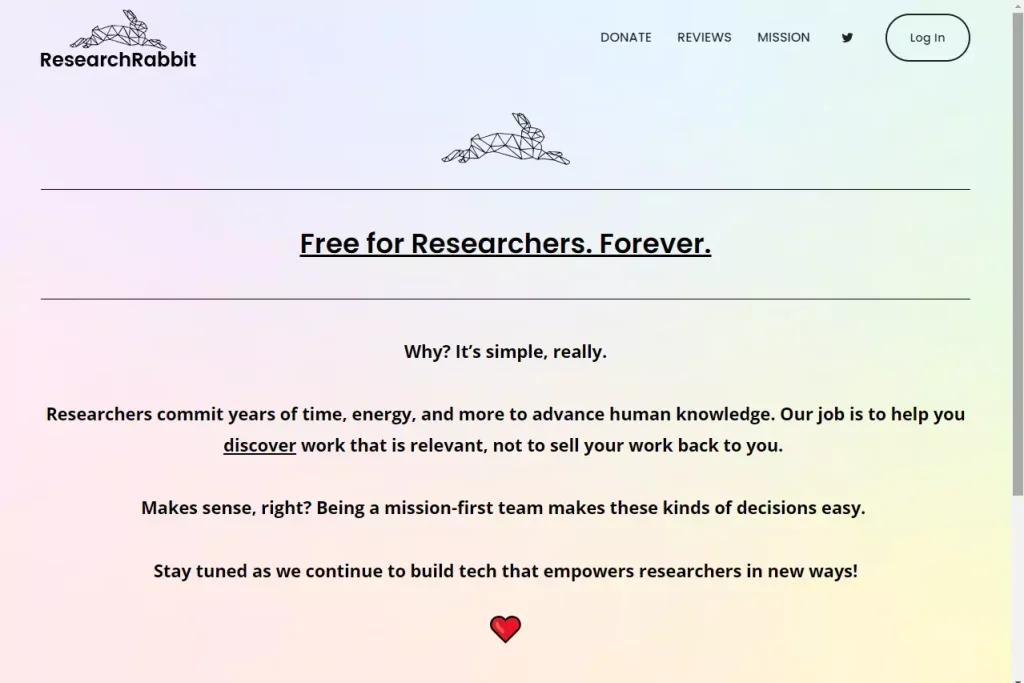
Summary: Research Rabbit helps you navigate the vast landscape of academic literature. It creates visual maps connecting related papers, authors, and publications, letting you quickly explore different avenues of your research topic.
- Why It Stands Out: Research Rabbit’s multiple search methods (paper, author, keywords) make it incredibly flexible. This allows you to start your exploration from different points and uncover hidden connections.
- Visually appealing interface helps you organize research
- Great for both broad exploration and targeted searches
- Lets you see how authors and institutions are connected
- Can have a slight learning curve to master all the features
- Might not be the best tool for highly specialized niche topics
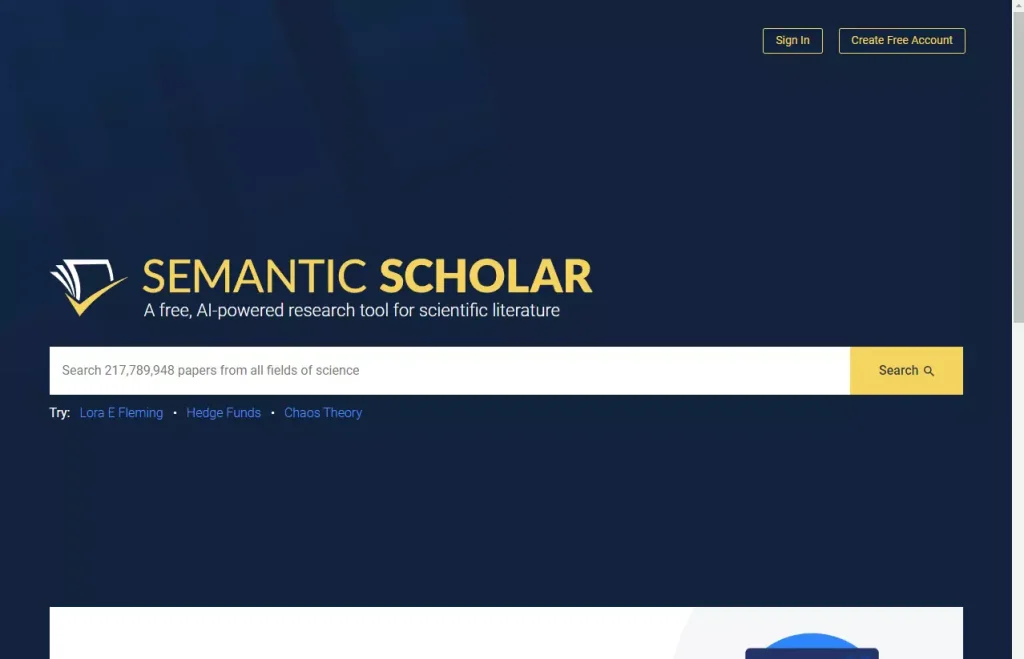
Summary: Semantic Scholar is an AI-powered search engine designed specifically for academic research. It understands the context of research papers, helping you find the most relevant results and providing summaries that highlight key findings.
- Why It Stands Out: Semantic Scholar uses natural language processing to go beyond simple keyword matching. It can identify similar research papers, even if they don’t use the exact same terminology.
- Helps you break out of “keyword bubbles” to find truly relevant research
- Provides summaries and figures to quickly assess potential papers
- Excellent for staying current in your field and uncovering new discoveries
- Coverage within some specialized disciplines may still be developing
- Less flashy visual interface compared to some other tools
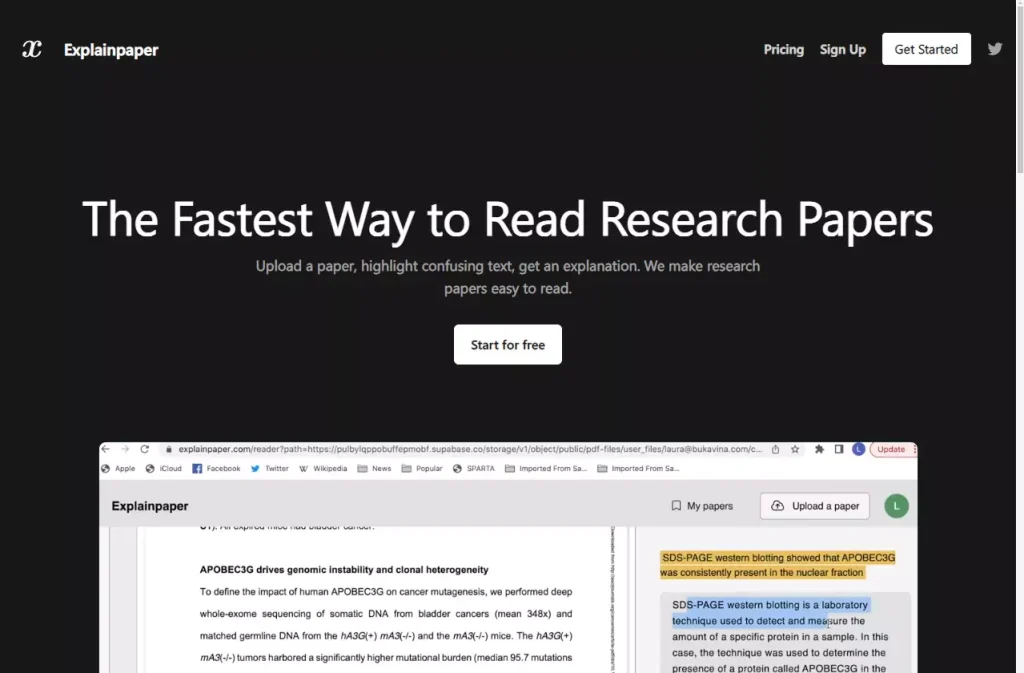
Summary: Explainpaper focuses on clarifying the often-dense language used in research papers. It allows you to highlight confusing sections of a paper and receive clear, plain-language explanations to aid your understanding.
- Why It Stands Out: Explainpaper’s direct approach to simplifying research paper text sets it apart. It’s ideal for tackling specific jargon or complex sentence structures.
- Provides targeted help when you’re stuck on a specific concept or phrase
- The ability to ask questions about the paper adds to its usefulness
- Great for those who learn well through direct explanations
- Requires you to first identify the parts you don’t understand
- May not be as helpful for broader understanding of a paper’s entire scope

Anyword Review: Unbiased Review
Summary: TLDR Papers aims to deliver exactly what its name implies: extremely concise summaries of research papers. It gives you the most important findings in a few sentences, perfect for getting the gist of a paper quickly.
- Why It Stands Out: TLDR Papers is focused on efficiency. If your main goal is to know whether a paper is worth a deep dive, it’s the perfect tool for the job.
- Quickly skim through a lot of papers and weed out the less relevant ones
- Excellent for getting a sense of the latest research trends
- Great for those with limited time who still want to stay informed
- Doesn’t replace reading the full paper if you need in-depth understanding
- Summaries may sometimes oversimplify complex findings
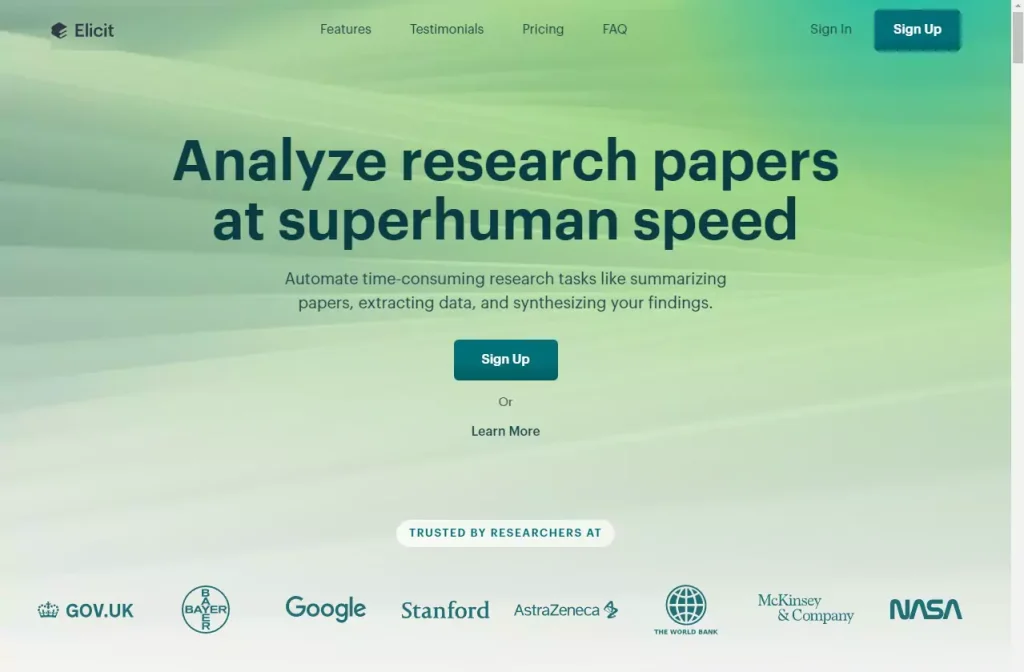
Summary: Elicit is a research tool that helps you ask the right questions about academic papers. It uses natural language processing to analyze a paper and generate thought-provoking questions to deepen your understanding.
- Why It Stands Out: Elicit goes beyond summarization and focuses on critical thinking. It encourages you to engage actively with the research, promoting deeper learning.
- Helps uncover hidden assumptions or implications in a paper
- Great for students learning to analyze research critically
- Encourages a more active reading approach
- Requires effort on your part to answer the generated questions thoroughly
- Might be less useful for highly descriptive papers where critical analysis is less central
Why is it so hard to understand some research papers?
Research papers are often written for a specialized audience, using technical terms and complex sentence structures that can be overwhelming for non-experts. This can be frustrating when you find a promising paper but struggle to grasp its significance.
How can AI tools help me understand research papers better?
AI tools designed for research paper analysis can be incredibly helpful. They can distill complex papers into easy-to-understand summaries, break down technical jargon into plain language, and even reveal connections between the paper and the broader field of research. It’s like having a knowledgeable friend guide you through the paper.
Are there good free AI tools available for this?
Yes! Several excellent free AI tools can help you tackle research papers. Some popular choices include SciSpace, Connected Papers, Research Rabbit, Semantic Scholar, Explainpaper, TLDR Papers, and Elicit. Each has its own strengths, so explore to find what works best for you.
Can AI tools replace my own understanding of research?
AI tools are incredibly powerful, but they are meant to support your understanding, not replace it. They can save you time, clarify confusing points, and uncover connections you might miss. However, you’ll still need to apply your critical thinking skills to fully analyze and integrate research findings into your own work.

The AI Tools for Teachers Are Getting More Robust. Here’s How

- Share article
Big ed-tech players are adding generative artificial intelligence tools to existing products already popular in the K-12 world. While some educators and AI experts are excited, they say these new tools make the need for teacher training on AI even more urgent.
Google is providing Gemini —its generative AI model—as an add-on for educational institutions using its Workspace for Education product. A lower-tier version of Gemini Education provides access to generative AI features in Google’s Workspace apps, such as Docs, Sheets, Slides, and Gmail, and access to the Gemini chatbot. The premium version offers additional features, such as AI-powered note taking and summaries in Meet.
Khan Academy and Microsoft are partnering to provide free access to Khanmigo—its AI powered teaching assistant—for teachers. Both tools can help educators with administrative work and creating materials for students.
The announcements come as more educators try out the emerging technology and as school districts discuss and create guidelines and policies for AI use .
“This is a great example of the speed of AI tool development,” said Pat Yongpradit, the chief academic officer at Code.org and a leader of TeachAI, an initiative to support schools in using and teaching about AI. “And I’m really happy that the big companies are thinking about how to serve educators, and they’re not just focused on creating general purpose chatbot tools.”
How do teachers use AI?
Educators who are using AI have mostly been using ChatGPT or other free AI tools available online . But these releases from Google and Khan Academy should increase access to AI tools, Yongpradit said.
“If you’re using Google stuff, which zillions of schools are, now you have [AI] stuff to play with,” he said. And Khanmigo being free now is “wonderful, because cost has been an issue with accessing Khanmigo before.”
Mark Erlenwein, the principal of Staten Island Technical High School in New York, has yet to try Gemini, but he has tried Khanmigo and said he’s “impressed” by what he sees so far. With Khanmigo, Khan Academy has provided ready-made prompts and activities that teachers could use. For instance, if a teacher wants Khanmigo to help her create an exit ticket, she would just click that button, input a grade level, subject, and topic, and then Khanmigo will produce the exit ticket.
In the past, Erlenwein has mostly used ChatGPT, but now with these new tools, “it kind of comes down to: Do you want to go directly to ChatGPT to do the work or do you want to use these platforms that honestly would make it easier for a teacher?”

It’s helpful that Khan Academy has figured out “the mastery behind asking the prompt correctly,” Erlenwein said, “which is what I think is going to be the difference-maker here” because now educators don’t have to spend time figuring out the perfect prompt to ask the chatbot to get what they want.
Along with increasing access, these tools also most likely have better data privacy and security practices than some of the other free AI tools that have cropped up, Yongpradit said.
“A hit to [Google’s and Khan Academy’s] reputation is a much bigger hit that has way larger ramifications than some ed-tech startup maybe messing up or not being as careful about privacy and security and age appropriateness and compliance with existing policies,” he said.
Google said in its announcement that it isn’t using data that users put into Gemini to train its AI model without permission and that it isn’t sharing data with other users or organizations. And Khanmigo, which is powered by the same technology behind ChatGPT, is also not training the AI model. It does use feedback from educators to refine prompts.
Why training on how to use AI is important for teachers
Providing access to AI tools is great, educators and AI experts say, but it’s meaningless if educators don’t know how to use the tools properly.
Schools need funding and time to provide professional development for educators to understand how to use these tools, as well as how to evaluate the effectiveness of the tools, they say.
So far, more than 7 in 10 teachers said they haven’t received any professional development on using AI in the classroom, according to a nationally representative EdWeek Research Center survey of 953 educators, including 553 teachers, conducted between Jan. 31 and March 4.

“Teachers are going to have to really figure out what makes the most sense for their context,” Yongpradit said. “They still need to have that healthy skepticism and evaluation skills to make the most sense of [what the AI tool produces].”
Glenn Kleiman, a senior adviser for Stanford University’s Graduate School of Education, said it’s also important to start thinking beyond using AI to improve efficiency. Districts, researchers, and policymakers need to start thinking about the changes in content and pedagogy as AI continues to advance.
“The advances in AI tools are running ahead of advances in the human capacity to use them well,” he said.
School districts need to be thoughtful about crafting policies on AI use
The fast pace at which AI is evolving might make districts feel like they need to respond just as quickly, but they should keep calm and have a thoughtful implementation over time, Kleiman added.
Erlenwein has always been an early adopter of new technologies, and he’s excited about these new tools’ ability to increase efficiency and productivity. However he is concerned about the lack of research on what effects it will have on K-12.
“As an early adopter, I’m ready to adopt. But I don’t know if we really know what we’re adopting,” he said.
Yongpradit of TeachAI said there are organizations that are trying to figure out how to fund the research that’s needed, but it takes time. For now, districts should trust their robust evaluation, procurement, and piloting processes, he said.
Sign Up for EdWeek Tech Leader
Edweek top school jobs.

Sign Up & Sign In

30 Tools and Resources for Academic Research
Merriam-Webster defines “research” as “careful or diligent search; studious inquiry or examination; the collecting of information about a particular subject”. It’s not easy to conduct academic research, so here we round up 30 tools that will facilitate your research in managing, indexing, and web scraping .
Looking for data resources for your research? Find it in 70 Amazing Free Data Resources you should know, covering government, crime, health, finances, social media, journalism, real estate, etc.
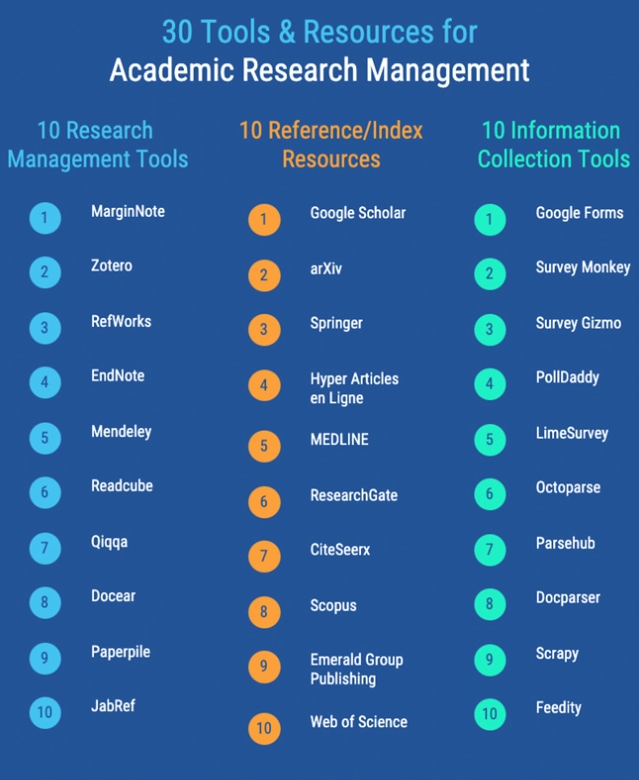
10 Research Management Tools
1. marginnote.
License: Commercial
MarginNote is a powerful reading tool for learners. Whether you are a student, a teacher, a researcher, a lawyer, or someone with a curious mind to learn, MarginNote can help you quickly organize, study and manage large volumes of PDFs and EPUBs. All-in-one learning app enables you to highlight PDF and EPUB, take notes, create the mind map, review flashcards, and saves you from switching endlessly between different Apps. It is available on Mac, iPad, and iPhone.
License: Free
Zotero is a free, easy-to-use tool to help you collect, organize, cite, and share research. It is available for Mac, Windows, and Linux. It supports managing bibliographic data and related research materials (such as PDF files). Notable features include web browser integration, online syncing, generation of in-text citations, footnotes, and bibliographies, as well as integration with the word processors Microsoft Word and LibreOffice Writer.
3. RefWorks
RefWorks is a web-based commercial reference management software package. Users’ reference databases are stored online, allowing them to be accessed and updated from any computer with an internet connection. Institutional licenses allow universities to subscribe to RefWorks on behalf of all their students, faculty, and staff. Individual licenses are also available. The software enables linking from a user’s RefWorks account to electronic editions of journals to which the institution’s library subscribes.
EndNote is the industry standard software tool for publishing and managing bibliographies, citations, and references on the Windows and Macintosh desktop. EndNote X9 is the reference management software that not only frees you from the tedious work of manually collecting and curating your research materials and formatting bibliographies, but also gives you greater ease and control in coordinating with your colleagues.
5. Mendeley
Mendeley Desktop is free academic software (Windows, Mac, Linux) for organizing and sharing research papers and generating bibliographies with 1GB of free online storage to automatically back up and synchronize your library across desktop, web, and mobile.
6. Readcube
ReadCube is a desktop and browser-based program for managing, annotating, and accessing academic research articles. It can sync your entire library including notes, lists, annotations, and even highlights across all of your devices including your desktop (Mac/PC), mobile devices (iOS/Android/Kindle), or even through the Web.
Qiqqa is a free research and reference manager. Its free version supports supercharged PDF management, annotation reports, expedition, Ad-supported, and 2GB free online storage.
Docear offers a single-section user interface that allows the most comprehensive organization of your literature; a literature suite concept that combines several tools in a single application (pdf management, reference management, mind mapping, …); A recommender system that helps you to discover new literature: Docear recommends papers which are free, in full-text, instantly to download, and tailored to your information needs.
9. Paperpile
Paperpile is a web-based commercial reference management software, with a special emphasis on integration with Google Docs and Google Scholar. Parts of Paperpile are implemented as a Google Chrome browser extension
JabRef is an open-source bibliography reference manager. The native file format used by JabRef is BibTeX, the standard LaTeX bibliography format. JabRef is a desktop application that runs on the Java VM (version 8), and works equally well on Windows, Linux, and Mac OS X. Entries can be searched in external databases and BibTeX entries can be fetched from there. Example sources include arXiv, CiteseerX, Google Scholar, Medline, GVK, IEEEXplore, and Springer.
10 Reference/Index Resources
1. google scholar.
Google Scholar is a freely accessible web search engine that indexes the full text or metadata of scholarly literature across an array of publishing formats and disciplines. It includes most peer-reviewed online academic journals and books, conference papers, theses and dissertations, preprints, abstracts, technical reports, and other scholarly literature, including court opinions and patents. You can extract these academic data easily by scraping Google Scholar search results .
arXiv (pronounced “archive”) is a repository of electronic preprints (known as e-prints) approved for publication after moderation, that consists of scientific papers in the fields of mathematics, physics, astronomy, electrical engineering, computer science, quantitative biology, statistics, and quantitative finance, which can be accessed online. In many fields of mathematics and physics, almost all scientific papers are self-archived on the arXiv repository.
3. Springer
Springer Science+Business Media or Springer, part of Springer Nature, has published more than 2,900 journals and 290,000 books, which covers science, humanities, technical and medical, etc.
4. Hyper Articles en Ligne
Hyper Articles en Ligne (HAL) is an open archive where authors can deposit scholarly documents from all academic fields, run by the Centre pour la Communication Scientifique direct, which is part of the French National Centre for Scientific Research. An uploaded document does not need to have been published or even to be intended for publication. It may be posted to HAL as long as its scientific content justifies it.
MEDLINE (Medical Literature Analysis and Retrieval System Online, or MEDLARS Online) is a bibliographic database of life sciences and biomedical information. It includes bibliographic information for articles from academic journals covering medicine, nursing, pharmacy, dentistry, veterinary medicine, and health care. MEDLINE also covers much of the literature in biology and biochemistry, as well as fields such as molecular evolution.
Compiled by the United States National Library of Medicine (NLM), MEDLINE is freely available on the Internet and searchable via PubMed and NLM’s National Center for Biotechnology Information’s Entrez system.
6. ResearchGate
ResearchGate is a social networking site for scientists and researchers[3] to share papers, ask and answer questions, and find collaborators.[4] According to a study by Nature and an article in Times Higher Education, it is the largest academic social network in terms of active users.
7. CiteSeerx
Owner: Pennsylvania State University
CiteSeerx ( CiteSeer ) is a public search engine and digital library for scientific and academic papers, primarily in the fields of computer and information science. Many consider it to be the first academic paper search engine and the first automated citation indexing system. CiteSeer holds a United States patent # 6289342, titled “Autonomous citation indexing and literature browsing using citation context”.
Owner: Elsevier
Scopus is the world’s largest abstract and citation database of peer-reviewed research literature. With over 22,000 titles from more than 5,000 international publishers. You can use this free author lookup to search for any author; or, use the Author Feedback Wizard to verify your Scopus Author Profile.
9. Emerald Group Publishing
Emerald Publishing was founded in 1967, and now manages a portfolio of nearly 300 journals, more than 2,500 books, and over 1,500 teaching cases, covering the fields of management, business, education, library studies, health care, and engineering.
10. Web of Science
Owner: Clarivate Analytics (United States)
Web of Science (previously known as Web of Knowledge) is an online subscription-based scientific citation indexing service originally produced by the Institute for Scientific Information (ISI)
5 Information Survey Tools
1. google forms.
Google Forms is a simple option for you if you already have a Google account. It supports menu search, a shuffle of questions for randomized order, limiting responses to once per person, custom themes, automatically generating answer suggestions when creating forms, and an “Upload file” option for users answering to share content through.
Moreover, the response can be synced in Google Drive, and users can request file uploads from individuals outside their respective companies, with the storage cap initially set at 1 GB.
2. Survey Monkey
Survey Monkey is quite a well-known name in the field but is also costing. It is a great choice for you if you want an easy user interface for basic surveys, as its free plan supports unlimited surveys, however, each survey is limited to 10 questions.
3. Survey Gizmo
SurveyGizmo can be customized to meet a wide range of data-collection demands. The free version has up to 25 question types, letting you write a survey that caters to specific needs. It also offers nearly 100 different question types that can all be customized to the user’s liking.
4. PollDaddy
PollDaddy is online survey software that allows users to embed surveys on their website or invite respondents via email. Its free version supports unlimited polls, 19 types of questions, and even adding images, videos, and content from YouTube, Flickr, Google Maps, and more.
5. LimeSurvey
LimeSurvey is an open-source survey software as a professional SaaS solution or as a self-hosted Community Edition. LimeSurvey’s professional free version provides 25 responses/month with an unlimited number of surveys, unlimited administrators, and 10 MB of upload storage.
5 Web Data Collection Tools
1. octoparse.
Octoparse is the most easy-to-use web scraping tool for people without a prior tech background. It is widely used among online sellers, marketers, researchers, and data analysts. With its intuitive interface, you can scrape web data within points and clicks. It also provides ready-to-use web scraping templates to extract data from Amazon, eBay, Twitter, BestBuy, etc. If you are looking for a one-stop data solution, Octoparse also provides a web data service . Or you can simply follow the Octoparse user guide to scrape website data easily for free.
Its free version offers unlimited pages per crawl, 10 crawlers, and up to 10,000 records per export. If the data collected is over 10,000, then you can pay $5.9 to export all the data. If you need to track the dynamic data in real time, you may want to use Octoparse’s premium feature: scheduled cloud extraction. Read its customer stories to get an idea of how web scraping enhances businesses.
2. Parsehub
Parsehub is another non-programmer-friendly desktop software for web scraping, which is available to various systems such as Windows, Mac OS X, and Linux. Its free version offers 200 pages per crawl, 5 public projects, and 14 days for data retention.
3. Docparser
Docparser converts PDF documents into structured and easy-to-handle data, which allows you to extract specific data fields from PDFs and scanned documents, convert PDF to text, PDF to JSON, PDF to XML, convert PDF tables into CSV or Excel, etc. Its starting price is $19, which includes 100 parsing credits.
Scrapy is an open-source and collaborative framework for extracting the data you need from websites. In a fast, simple, yet extensible way.
Feedity automagically extracts relevant content & data from public web pages to create auto-updating RSS feeds. Instantly convert online news, articles, discussion forums, reviews, jobs, events, products, blogs, press releases, social media posts, or any other Web content into subscribable or publishable notifications. The starter version offers 20 feeds and 6 hours update interval, with a cost of $9 per month.
Explore topics
- # Web Scraping 212
- # Knowledge 122
- # Octoparse 95
- # Big Data 59
- # Data Collection 54
- # Customer Reviews 21

Get started with Octoparse today
Related articles.

A new future of work: The race to deploy AI and raise skills in Europe and beyond
At a glance.
Amid tightening labor markets and a slowdown in productivity growth, Europe and the United States face shifts in labor demand, spurred by AI and automation. Our updated modeling of the future of work finds that demand for workers in STEM-related, healthcare, and other high-skill professions would rise, while demand for occupations such as office workers, production workers, and customer service representatives would decline. By 2030, in a midpoint adoption scenario, up to 30 percent of current hours worked could be automated, accelerated by generative AI (gen AI). Efforts to achieve net-zero emissions, an aging workforce, and growth in e-commerce, as well as infrastructure and technology spending and overall economic growth, could also shift employment demand.
By 2030, Europe could require up to 12 million occupational transitions, double the prepandemic pace. In the United States, required transitions could reach almost 12 million, in line with the prepandemic norm. Both regions navigated even higher levels of labor market shifts at the height of the COVID-19 period, suggesting that they can handle this scale of future job transitions. The pace of occupational change is broadly similar among countries in Europe, although the specific mix reflects their economic variations.
Businesses will need a major skills upgrade. Demand for technological and social and emotional skills could rise as demand for physical and manual and higher cognitive skills stabilizes. Surveyed executives in Europe and the United States expressed a need not only for advanced IT and data analytics but also for critical thinking, creativity, and teaching and training—skills they report as currently being in short supply. Companies plan to focus on retraining workers, more than hiring or subcontracting, to meet skill needs.
Workers with lower wages face challenges of redeployment as demand reweights toward occupations with higher wages in both Europe and the United States. Occupations with lower wages are likely to see reductions in demand, and workers will need to acquire new skills to transition to better-paying work. If that doesn’t happen, there is a risk of a more polarized labor market, with more higher-wage jobs than workers and too many workers for existing lower-wage jobs.
Choices made today could revive productivity growth while creating better societal outcomes. Embracing the path of accelerated technology adoption with proactive worker redeployment could help Europe achieve an annual productivity growth rate of up to 3 percent through 2030. However, slow adoption would limit that to 0.3 percent, closer to today’s level of productivity growth in Western Europe. Slow worker redeployment would leave millions unable to participate productively in the future of work.

Demand will change for a range of occupations through 2030, including growth in STEM- and healthcare-related occupations, among others
This report focuses on labor markets in nine major economies in the European Union along with the United Kingdom, in comparison with the United States. Technology, including most recently the rise of gen AI, along with other factors, will spur changes in the pattern of labor demand through 2030. Our study, which uses an updated version of the McKinsey Global Institute future of work model, seeks to quantify the occupational transitions that will be required and the changing nature of demand for different types of jobs and skills.
Our methodology
We used methodology consistent with other McKinsey Global Institute reports on the future of work to model trends of job changes at the level of occupations, activities, and skills. For this report, we focused our analysis on the 2022–30 period.
Our model estimates net changes in employment demand by sector and occupation; we also estimate occupational transitions, or the net number of workers that need to change in each type of occupation, based on which occupations face declining demand by 2030 relative to current employment in 2022. We included ten countries in Europe: nine EU members—the Czech Republic, Denmark, France, Germany, Italy, Netherlands, Poland, Spain, and Sweden—and the United Kingdom. For the United States, we build on estimates published in our 2023 report Generative AI and the future of work in America.
We included multiple drivers in our modeling: automation potential, net-zero transition, e-commerce growth, remote work adoption, increases in income, aging populations, technology investments, and infrastructure investments.
Two scenarios are used to bookend the work-automation model: “late” and “early.” For Europe, we modeled a “faster” scenario and a “slower” one. For the faster scenario, we use the midpoint—the arithmetical average between our late and early scenarios. For the slower scenario, we use a “mid late” trajectory, an arithmetical average between a late adoption scenario and the midpoint scenario. For the United States, we use the midpoint scenario, based on our earlier research.
We also estimate the productivity effects of automation, using GDP per full-time-equivalent (FTE) employee as the measure of productivity. We assumed that workers displaced by automation rejoin the workforce at 2022 productivity levels, net of automation, and in line with the expected 2030 occupational mix.
Amid tightening labor markets and a slowdown in productivity growth, Europe and the United States face shifts in labor demand, spurred not only by AI and automation but also by other trends, including efforts to achieve net-zero emissions, an aging population, infrastructure spending, technology investments, and growth in e-commerce, among others (see sidebar, “Our methodology”).
Our analysis finds that demand for occupations such as health professionals and other STEM-related professionals would grow by 17 to 30 percent between 2022 and 2030, (Exhibit 1).
By contrast, demand for workers in food services, production work, customer services, sales, and office support—all of which declined over the 2012–22 period—would continue to decline until 2030. These jobs involve a high share of repetitive tasks, data collection, and elementary data processing—all activities that automated systems can handle efficiently.
Up to 30 percent of hours worked could be automated by 2030, boosted by gen AI, leading to millions of required occupational transitions
By 2030, our analysis finds that about 27 percent of current hours worked in Europe and 30 percent of hours worked in the United States could be automated, accelerated by gen AI. Our model suggests that roughly 20 percent of hours worked could still be automated even without gen AI, implying a significant acceleration.
These trends will play out in labor markets in the form of workers needing to change occupations. By 2030, under the faster adoption scenario we modeled, Europe could require up to 12.0 million occupational transitions, affecting 6.5 percent of current employment. That is double the prepandemic pace (Exhibit 2). Under a slower scenario we modeled for Europe, the number of occupational transitions needed would amount to 8.5 million, affecting 4.6 percent of current employment. In the United States, required transitions could reach almost 12.0 million, affecting 7.5 percent of current employment. Unlike Europe, this magnitude of transitions is broadly in line with the prepandemic norm.
Both regions navigated even higher levels of labor market shifts at the height of the COVID-19 period. While these were abrupt and painful to many, given the forced nature of the shifts, the experience suggests that both regions have the ability to handle this scale of future job transitions.

Businesses will need a major skills upgrade
The occupational transitions noted above herald substantial shifts in workforce skills in a future in which automation and AI are integrated into the workplace (Exhibit 3). Workers use multiple skills to perform a given task, but for the purposes of our quantification, we identified the predominant skill used.
Demand for technological skills could see substantial growth in Europe and in the United States (increases of 25 percent and 29 percent, respectively, in hours worked by 2030 compared to 2022) under our midpoint scenario of automation adoption (which is the faster scenario for Europe).
Demand for social and emotional skills could rise by 11 percent in Europe and by 14 percent in the United States. Underlying this increase is higher demand for roles requiring interpersonal empathy and leadership skills. These skills are crucial in healthcare and managerial roles in an evolving economy that demands greater adaptability and flexibility.
Conversely, demand for work in which basic cognitive skills predominate is expected to decline by 14 percent. Basic cognitive skills are required primarily in office support or customer service roles, which are highly susceptible to being automated by AI. Among work characterized by these basic cognitive skills experiencing significant drops in demand are basic data processing and literacy, numeracy, and communication.
Demand for work in which higher cognitive skills predominate could also decline slightly, according to our analysis. While creativity is expected to remain highly sought after, with a potential increase of 12 percent by 2030, work activities characterized by other advanced cognitive skills such as advanced literacy and writing, along with quantitative and statistical skills, could decline by 19 percent.
Demand for physical and manual skills, on the other hand, could remain roughly level with the present. These skills remain the largest share of workforce skills, representing about 30 percent of total hours worked in 2022. Growth in demand for these skills between 2022 and 2030 could come from the build-out of infrastructure and higher investment in low-emissions sectors, while declines would be in line with continued automation in production work.
Business executives report skills shortages today and expect them to worsen
A survey we conducted of C-suite executives in five countries shows that companies are already grappling with skills challenges, including a skills mismatch, particularly in technological, higher cognitive, and social and emotional skills: about one-third of the more than 1,100 respondents report a shortfall in these critical areas. At the same time, a notable number of executives say they have enough employees with basic cognitive skills and, to a lesser extent, physical and manual skills.
Within technological skills, companies in our survey reported that their most significant shortages are in advanced IT skills and programming, advanced data analysis, and mathematical skills. Among higher cognitive skills, significant shortfalls are seen in critical thinking and problem structuring and in complex information processing. About 40 percent of the executives surveyed pointed to a shortage of workers with these skills, which are needed for working alongside new technologies (Exhibit 4).

Companies see retraining as key to acquiring needed skills and adapting to the new work landscape
Surveyed executives expect significant changes to their workforce skill levels and worry about not finding the right skills by 2030. More than one in four survey respondents said that failing to capture the needed skills could directly harm financial performance and indirectly impede their efforts to leverage the value from AI.
To acquire the skills they need, companies have three main options: retraining, hiring, and contracting workers. Our survey suggests that executives are looking at all three options, with retraining the most widely reported tactic planned to address the skills mismatch: on average, out of companies that mentioned retraining as one of their tactics to address skills mismatch, executives said they would retrain 32 percent of their workforce. The scale of retraining needs varies in degree. For example, respondents in the automotive industry expect 36 percent of their workforce to be retrained, compared with 28 percent in the financial services industry. Out of those who have mentioned hiring or contracting as their tactics to address the skills mismatch, executives surveyed said they would hire an average of 23 percent of their workforce and contract an average of 18 percent.
Occupational transitions will affect high-, medium-, and low-wage workers differently
All ten European countries we examined for this report may see increasing demand for top-earning occupations. By contrast, workers in the two lowest-wage-bracket occupations could be three to five times more likely to have to change occupations compared to the top wage earners, our analysis finds. The disparity is much higher in the United States, where workers in the two lowest-wage-bracket occupations are up to 14 times more likely to face occupational shifts than the highest earners. In Europe, the middle-wage population could be twice as affected by occupational transitions as the same population in United States, representing 7.3 percent of the working population who might face occupational transitions.
Enhancing human capital at the same time as deploying the technology rapidly could boost annual productivity growth
About quantumblack, ai by mckinsey.
QuantumBlack, McKinsey’s AI arm, helps companies transform using the power of technology, technical expertise, and industry experts. With thousands of practitioners at QuantumBlack (data engineers, data scientists, product managers, designers, and software engineers) and McKinsey (industry and domain experts), we are working to solve the world’s most important AI challenges. QuantumBlack Labs is our center of technology development and client innovation, which has been driving cutting-edge advancements and developments in AI through locations across the globe.
Organizations and policy makers have choices to make; the way they approach AI and automation, along with human capital augmentation, will affect economic and societal outcomes.
We have attempted to quantify at a high level the potential effects of different stances to AI deployment on productivity in Europe. Our analysis considers two dimensions. The first is the adoption rate of AI and automation technologies. We consider the faster scenario and the late scenario for technology adoption. Faster adoption would unlock greater productivity growth potential but also, potentially, more short-term labor disruption than the late scenario.
The second dimension we consider is the level of automated worker time that is redeployed into the economy. This represents the ability to redeploy the time gained by automation and productivity gains (for example, new tasks and job creation). This could vary depending on the success of worker training programs and strategies to match demand and supply in labor markets.
We based our analysis on two potential scenarios: either all displaced workers would be able to fully rejoin the economy at a similar productivity level as in 2022 or only some 80 percent of the automated workers’ time will be redeployed into the economy.
Exhibit 5 illustrates the various outcomes in terms of annual productivity growth rate. The top-right quadrant illustrates the highest economy-wide productivity, with an annual productivity growth rate of up to 3.1 percent. It requires fast adoption of technologies as well as full redeployment of displaced workers. The top-left quadrant also demonstrates technology adoption on a fast trajectory and shows a relatively high productivity growth rate (up to 2.5 percent). However, about 6.0 percent of total hours worked (equivalent to 10.2 million people not working) would not be redeployed in the economy. Finally, the two bottom quadrants depict the failure to adopt AI and automation, leading to limited productivity gains and translating into limited labor market disruptions.

Four priorities for companies
The adoption of automation technologies will be decisive in protecting businesses’ competitive advantage in an automation and AI era. To ensure successful deployment at a company level, business leaders can embrace four priorities.
Understand the potential. Leaders need to understand the potential of these technologies, notably including how AI and gen AI can augment and automate work. This includes estimating both the total capacity that these technologies could free up and their impact on role composition and skills requirements. Understanding this allows business leaders to frame their end-to-end strategy and adoption goals with regard to these technologies.
Plan a strategic workforce shift. Once they understand the potential of automation technologies, leaders need to plan the company’s shift toward readiness for the automation and AI era. This requires sizing the workforce and skill needs, based on strategically identified use cases, to assess the potential future talent gap. From this analysis will flow details about the extent of recruitment of new talent, upskilling, or reskilling of the current workforce that is needed, as well as where to redeploy freed capacity to more value-added tasks.
Prioritize people development. To ensure that the right talent is on hand to sustain the company strategy during all transformation phases, leaders could consider strengthening their capabilities to identify, attract, and recruit future AI and gen AI leaders in a tight market. They will also likely need to accelerate the building of AI and gen AI capabilities in the workforce. Nontechnical talent will also need training to adapt to the changing skills environment. Finally, leaders could deploy an HR strategy and operating model to fit the post–gen AI workforce.
Pursue the executive-education journey on automation technologies. Leaders also need to undertake their own education journey on automation technologies to maximize their contributions to their companies during the coming transformation. This includes empowering senior managers to explore automation technologies implications and subsequently role model to others, as well as bringing all company leaders together to create a dedicated road map to drive business and employee value.
AI and the toolbox of advanced new technologies are evolving at a breathtaking pace. For companies and policy makers, these technologies are highly compelling because they promise a range of benefits, including higher productivity, which could lift growth and prosperity. Yet, as this report has sought to illustrate, making full use of the advantages on offer will also require paying attention to the critical element of human capital. In the best-case scenario, workers’ skills will develop and adapt to new technological challenges. Achieving this goal in our new technological age will be highly challenging—but the benefits will be great.
Eric Hazan is a McKinsey senior partner based in Paris; Anu Madgavkar and Michael Chui are McKinsey Global Institute partners based in New Jersey and San Francisco, respectively; Sven Smit is chair of the McKinsey Global Institute and a McKinsey senior partner based in Amsterdam; Dana Maor is a McKinsey senior partner based in Tel Aviv; Gurneet Singh Dandona is an associate partner and a senior expert based in New York; and Roland Huyghues-Despointes is a consultant based in Paris.
Explore a career with us
Related articles.

Generative AI and the future of work in America

The economic potential of generative AI: The next productivity frontier

What every CEO should know about generative AI
Diving Deeper into Postsecondary Value, IHEP Research Series Explores Equity and Economic Outcomes

Washington, DC (May 29, 2024) – Higher education has long been recognized as a key driver of economic opportunity, but new research, spearheaded by the Institute for Higher Education Policy (IHEP), is diving deeper into questions of postsecondary value and equity. The “Elevating Equitable Value: Investigating Economic Outcomes of Postsecondary Education” series, informed by data from the Equitable Value Explorer tool along with state-level data, surveys, and additional sources, is exploring pressing questions about postsecondary value. Research released today by Trellis Strategies, the American Association of State Colleges and Universities (AASCU), Wayne State University, and the Research Institute at Dallas College completes the seven-paper series.
“Earning a college degree can change the trajectory of students’ lives, their families, and their communities, for generations to come, but the benefits are not evenly distributed,” said IHEP President Mamie Voight . “By unpacking the nuances of value delivery across different contexts, this research strengthens the evidence-base showing that college is worth the investment. It also can inform policymakers and institutions about targeted strategies to improve the returns on postsecondary education for all students.”
Field-based researchers across the country built on the work of the Postsecondary Value Commission by exploring critical questions on post-college outcomes in their own specific context:
How Can Policy and Practice Shape Equitable Value?
Several papers in the series explored how institutional policy and practice can ensure all students benefit from a college degree. Research by Trellis Strategies underscores the connection between student financial well-being during college and future economic returns. A ten-percentage-point decrease in the number of students experiencing financial instability during college was correlated with higher economic returns to students, especially at four-year public schools. The authors highlight the importance of programs that expand access to emergency aid, promote financial literacy, and enhance transparency around college costs and financial aid options.
A study by the American Association of State Colleges and Universities (AASCU) found that all 33 institutions participating in their Student Success Equity Intensive program had earnings that exceeded the Postsecondary Value Commission’s minimum economic return threshold, but equity gaps persist. Institutions serving a larger proportion of Black, Latinx, and Indigenous students or Pell Grant recipients saw a smaller economic return – the amount by which earnings exceed those of a typical high school graduate, plus the cost of their education – demonstrating the need for continued efforts to promote student success and the financial value of college degrees.
Another key finding shows a strong link between faculty composition and student outcomes. Research by Frederick Tucker of the City University of New York reveals that institutions with more tenured or tenure-track faculty, alongside a smaller proportion of full-time adjuncts, see stronger economic returns for students. This is particularly true at Minority-Serving Institutions (MSIs) and colleges serving a large share of Pell Grant recipients.
How Does Postsecondary Value Differ By and Within States?
The research in this series adds to our growing understanding of how certain states are delivering value. For example, a project by Wayne State University found that while postsecondary education generally leads to higher earnings in Michigan, disparities exist. Public, four-year universities in the state provided the highest economic return, exceeding the minimum threshold by over $22,000, while most other types of institutions in the state offered a smaller but still positive return. Michigan ranked high nationally in terms of the amount that students’ earnings typically exceed the minimum economic return threshold, despite having a moderate ranking in median post-college earnings.
The Research Institute at Dallas College’s analysis paired data from the Equitable Value Explorer with state longitudinal data to measure the economic return at more than 500 Hispanic-Serving Institutions (HSIs) nationwide, in addition to outcomes for all Hispanic students in Texas. Overall, economic returns were positive for Hispanic students, but disparities persisted even within Hispanic communities, particularly for immigrants, those from low-income backgrounds and women.
What is the Role of Geography in the Postsecondary Value Equation?
Location plays a significant role in education options and economic returns. Two papers in the series examined the geographic dimension of value. The American Institutes for Research’s study found that community college students generally earn more after college than those with only a high school diploma in their region. However, community colleges serving a higher percentage of underrepresented students tend to deliver a lower economic value, underscoring the need for additional support to ensure these institutions can effectively serve their students.
Boston College researchers’ analysis of rural-serving institutions (RSIs) found that while median post-college earnings may be slightly lower compared to urban and suburban institutions, RSIs are typically more affordable. The majority of RSIs still provide a positive economic return for students after factoring in these relatively low education costs, highlighting their vital role in expanding access to higher education in underserved areas.
IHEP is expanding and strengthening the community of researchers, practitioners and advocates exploring postsecondary value through an equity lens, by providing the tools necessary for researchers, associations, and institutions to tackle these critical questions. For more information about the Equitable Value Explorer, please visit: https://equity.postsecondaryvalue.org/

Supporting the Whole Student Through Holistic Advising: Reflections on ED’s Raise The Bar Summit

Investing in Student Success: IHEP’s Federal Funding Priorities for FY25
Help | Advanced Search
Computer Science > Computer Vision and Pattern Recognition
Title: collaborative video diffusion: consistent multi-video generation with camera control.
Abstract: Research on video generation has recently made tremendous progress, enabling high-quality videos to be generated from text prompts or images. Adding control to the video generation process is an important goal moving forward and recent approaches that condition video generation models on camera trajectories make strides towards it. Yet, it remains challenging to generate a video of the same scene from multiple different camera trajectories. Solutions to this multi-video generation problem could enable large-scale 3D scene generation with editable camera trajectories, among other applications. We introduce collaborative video diffusion (CVD) as an important step towards this vision. The CVD framework includes a novel cross-video synchronization module that promotes consistency between corresponding frames of the same video rendered from different camera poses using an epipolar attention mechanism. Trained on top of a state-of-the-art camera-control module for video generation, CVD generates multiple videos rendered from different camera trajectories with significantly better consistency than baselines, as shown in extensive experiments. Project page: this https URL .
Submission history
Access paper:.
- HTML (experimental)
- Other Formats
References & Citations
- Google Scholar
- Semantic Scholar
BibTeX formatted citation
Bibliographic and Citation Tools
Code, data and media associated with this article, recommenders and search tools.
- Institution
arXivLabs: experimental projects with community collaborators
arXivLabs is a framework that allows collaborators to develop and share new arXiv features directly on our website.
Both individuals and organizations that work with arXivLabs have embraced and accepted our values of openness, community, excellence, and user data privacy. arXiv is committed to these values and only works with partners that adhere to them.
Have an idea for a project that will add value for arXiv's community? Learn more about arXivLabs .

IMAGES
VIDEO
COMMENTS
6. Scrivener. Scrivener is another great tool for research writing and keeping your notes organized. Used by researchers, screenwriters, novelists, non-fiction writers, students, journalists, academics, lawyers, translators, and more, Scrivener is a tool made for long writing projects.
Authorea - Best for Alternative Publication and Exposure. Authorea is this writing tool is a one-stop-shop for you to a) create/upload, b) disseminate your research paper, and c) get published in top journals. Authorea is great for young researchers who want to publish their academic work.
The best tools for researchers make this job easier. Market research tools help researchers write their project proposals, reports, academic papers, and articles by helping them avoid language mistakes, cite sources, build networks, and search for journals to publish. 12 Best tools for researchers in research and survey. So, let's get right ...
2. Phrasebank. Created by Dr John Morley from "The University Language Center" of Manchester University, the Phrasebank is a database of common phrases used in papers, dissertations and grant proposals - a real goldmine!. The phrases are organised both by the common sections in a paper such as the Introduction, Methods, Results or Discussion section.
Here is the list of top 16 digital tools for researchers that can help in making a researcher's life easy. Get a list of some must-have tools for researchers that can give you a head start and divide the load. Get insights on importance of digital tools for a researcher and work smarter!
1. SciSpace. SciSpace — formerly Typeset — is a brilliant tool for academics and researchers who create white papers, technical documentation, or research papers.. Created with the aim of "making science more collaborative and accessible," SciSpace allows users to search its expansive database for papers, authors, and topics of interest.
1. SciSpace Literature Review. SciSpace's Literature Review tool is designed for researchers to conduct systematic literature reviews efficiently. This AI research tool helps you compare and contrast scientific papers, and extract key information, themes, patterns, and concepts of numerous research papers in minutes, all in one single workspace.
6. Consensus. Researchers to work together, annotate, and discuss research papers in real-time, fostering team collaboration and knowledge sharing. 7. RAx. Researchers to perform efficient literature search and analysis, aiding in identifying relevant articles, saving time, and improving the quality of research. 8.
Typeset. Typeset is a great tool when it comes to writing your own research papers. You can upload all your references for simple citations and check your work for spelling errors and plagiarism. Typeset also offers features to collaborate with your teammates and get the work done together. 2. Google Scholar.
27. ScienceDirect. Elsevier, one of the biggest publishers of science content, offers access to their entire archive through ScienceDirect. ScienceDirect is built on a wide range of trusted, high-quality, interdisciplinary research. Its aim is to help you find answers to the most pressing research questions. 28.
Semantic Reader is an augmented reader with the potential to revolutionize scientific reading by making it more accessible and richly contextual. Try it for select papers. Semantic Scholar uses groundbreaking AI and engineering to understand the semantics of scientific literature to help Scholars discover relevant research.
In this post, we have pulled together 8 tools and resources that will help you work better and smarter when writing a research paper. Our downloadable comprehensive free guide: Writing your paper. Todoist: A to-do list to organize your work. Evernote: As a research notebook. Grammarly: Cloud based typing assistant.
AI for scientific writing and research papers. In the ever-evolving realm of academic research, AI tools are increasingly taking center stage. Enter Paper Wizard, Jenny.AI, and Wisio - these groundbreaking platforms are set to revolutionize the way we approach scientific writing.
A research paper is a piece of academic writing that provides analysis, interpretation, and argument based on in-depth independent research. ... Tip AI tools like ChatGPT can be effectively used to brainstorm potential thesis statements and develop research paper outlines. However, trying to pass off AI-generated text as your own work is widely ...
Best AI Tools for Research. Main Features . Pricing . Elephas . Summarizes research papers, Rewrites content in various tones, organizes your research in its second brain Premium Plan Starts at $4.99. Start a 30 Day Free Trial . ChatGPT. Summarizes news articles and answers research questions Premium Plan Starts at $20/month. Typeset.io
Get 30 days free. 1. Google Scholar. Google Scholar is the clear number one when it comes to academic search engines. It's the power of Google searches applied to research papers and patents. It not only lets you find research papers for all academic disciplines for free but also often provides links to full-text PDF files.
4. Elicit.org. Elicit.org is an AI-powered tool designed to streamline the research process by assisting in conducting comprehensive literature reviews and extracting relevant data from various sources. It is one of the top AI writing tools for academic research that has been embraced by researchers worldwide.
9. IBM Watson Discovery. An AI-powered tool called IBM Watson Discovery makes it possible to analyze and summarize academic publications. It makes use of cutting-edge machine learning and NLP techniques to glean insights from massive amounts of unstructured data, including papers, articles and scientific publications.
Top 10 AI tools for researchers. We'll discuss tools powered by artificial intelligence that can augment your research work, save you a lot of time through the automation of certain tasks, and help you brainstorm new ideas avoid plagiarism, and streamline the research process. 1. PDFgear Copilot.
2. Semantic Scholar. For: literature review and management With over 200 million academic papers sourced, Semantic Scholar is one of the best AI tools for literature review. Mainly, it helps researchers to understand a paper at a glance. You can scan papers faster with the TLDRs (Too Long; Didn't Read), or generate your own questions about the paper for the AI to answer.
Enago Read streamlines reference management, contributing to a more efficient and organized research workflow for researchers. 5. Consensus.app: Simplifying Literature Review with AI. Consensus is a search engine that simplifies the literature review process for researchers.
Yes! Several excellent free AI tools can help you tackle research papers. Some popular choices include SciSpace, Connected Papers, Research Rabbit, Semantic Scholar, Explainpaper, TLDR Papers, and Elicit. Each has its own strengths, so explore to find what works best for you.
A study describing a new method to ensure that online content analysis algorithms, such as those detecting harmful speech, remain fair and accurate over time, has won the Best Full Paper Award at the 16th ACM Web Science Conference 2024.The conference, held on May 21-24, 2024, in Stuttgart, Germany, brought together experts in Web Science, an interdisciplinary field dedicated to understanding ...
Detecting data points deviating from the training distribution is pivotal for ensuring reliable machine learning. Extensive research has been dedicated to the challenge, spanning classical anomaly detection techniques to contemporary out-of-distribution (OOD) detection approaches. While OOD detection commonly relies on supervised learning from a labeled in-distribution (ID) dataset, anomaly ...
Khan Academy and Microsoft are partnering to provide free access to Khanmigo—its AI powered teaching assistant—for teachers. Both tools can help educators with administrative work and creating ...
5. Mendeley. License: Free. Mendeley Desktop is free academic software (Windows, Mac, Linux) for organizing and sharing research papers and generating bibliographies with 1GB of free online storage to automatically back up and synchronize your library across desktop, web, and mobile. 6.
Our analysis finds that demand for occupations such as health professionals and other STEM-related professionals would grow by 17 to 30 percent between 2022 and 2030, (Exhibit 1). Exhibit 1. [email protected]. By contrast, demand for workers in food services, production work, customer services, sales, and office ...
Higher education has long been recognized as a key driver of economic opportunity, but new research, spearheaded by the Institute for Higher Education Policy (IHEP), is diving deeper into questions of postsecondary value and equity. The "Elevating Equitable Value: Investigating Economic Outcomes of Postsecondary Education" series, informed by data from the Equitable Value Explorer tool ...
The auto-regressive decoding of Large Language Models (LLMs) results in significant overheads in their hardware performance. While recent research has investigated various speculative decoding techniques for multi-token generation, these efforts have primarily focused on improving processing speed such as throughput. Crucially, they often neglect other metrics essential for real-life ...
Research on video generation has recently made tremendous progress, enabling high-quality videos to be generated from text prompts or images. Adding control to the video generation process is an important goal moving forward and recent approaches that condition video generation models on camera trajectories make strides towards it. Yet, it remains challenging to generate a video of the same ...